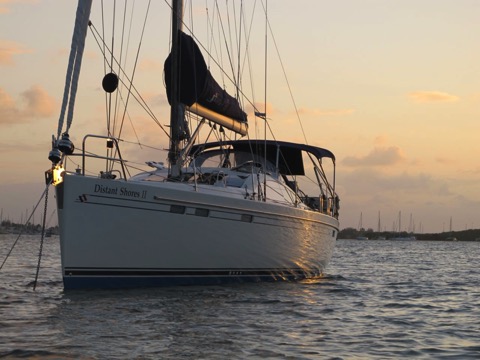Maintaining a Home Base while Cruising
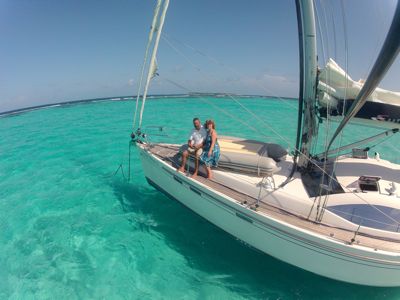
Aboard Distant Shores II in the Tobago Cays, St Vincent and the Grenadines
Right now we're counting the days to getting back to the boat in the Caribbean since we’re facing a major snow storm in Southern Ontario. But in 3 more days we'll be back on board our sailboat, Distant Shores II, in Grenada preparing for another season of sailing in the Caribbean.
Paul and I have been home in Canada for the last few weeks completing post production on the final episodes of Distant Shores season 9 which document the experiences of our recent cruise through the Leeward and Windward Islands of the Caribbean starting with the British Virgin Islands for the BVI Spring Regatta, St. Maarten for Carnival, diving and hiking in Dominica, riding out Tropical Storm Chantal in Martinique, and a special episode featuring top canal voyages that you can do with your own boat or by chartering. (The shows will soon be airing on television but if you can't wait, you can get them on DVD as well as HD digital download.)
Being home has got me thinking about the pros and cons of maintaining a home base while cruising, so today I thought I'd share our experiences. Paul and I have now been cruising for 24 years. We initially opted for the “sell up and sail” style of cruising (1989 to 1998) but for the last 15 years we have maintained a home base - a condo town house in Ontario's “cottage country” north of Toronto - so we have lots of experience with both options.
Sell Up and Sail
When Paul and I were married in 1985 we had only been out of school for a couple of years but were committed to our dream of building a boat and going cruising before settling down. The dream had been burning since high school and we knew that if we didn't do it we would live with the regret forever. So it didn't make sense for us to put down roots and immediately start saving for a house like the rest of our 20s-something friends were doing. We were paying off our student loans and investing in our dream, which was building our own sailboat from a bare hull and deck and taking a 1-2 year sabbatical to sail it down south - a delayed “gap year” of sorts.
We got a lovely, yet surprisingly affordable, waterfront apartment overlooking the Port Credit Harbour Marina and Port Credit Yacht Club, our home club on Lake Ontario west of Toronto, where we could build our Classic 37 sailboat in the boat yard right at our doorstep. It was a convenient, supportive, inspiring environment for our dream. When we launched the boat after 2 years of building, had sailed her for a couple of seasons, and were ready to set sail, it was easy to just let the apartment go, store a few things with friends and family, sell our student furniture (we were so focused on our boat project we weren't tempted to buy new stuff for the apartment), car, etc., and say goodbye to financial commitments ashore . We no longer had to budget for things like car and home insurance, utilities, rent, cable TV, and all that goes with life on land.
It was quite freeing. Life afloat is is simple life and so is managing the basic expenses of the cruising life when you don't have financial commitments back home. Building our boat didn't save us any money. Home builders don't benefit from the volume discounts on materials that commercial manufacturers pass on to their customers but building our Classic 37 sailboat, Two-Step, allowed us to put our money into our project gradually, kept us involved and committed to our dream, and most importantly gave us knowledge and skills which saved us money once we were “out there”. When we sold up and went sailing we owned the boat free and clear which is also liberating.
That first cruise stretched into a 3-year voyage from 1989-1992 around the Atlantic Ocean via the USA, Bahamas, Bermuda, Azores, Spain, Portugal, Gibraltar, Balearics, Canary Islands, Brazil, Caribbean Islands and then back to Canada. We found our savings stretched out since we anchored a lot, shopped in local markets mostly cooking on board, and did all our own repairs and maintenance. It was an amazing life-altering experience but by the end we were travel weary and looking forward to getting home. The travel documentary we'd filmed, Call of the Ocean, was picked up by Discovery Channel and we got requests for a full TV series that would follow upcoming voyages.
Part-time Cruising
By then we'd been home for a year, living with my (Sheryl's) mother who is a widow. It was a good arrangement because Mom wanted to stay in the family home and us being there helped all of us financially, plus we felt good about being able to help out with chores and projects for the house. Paul's parents lived just down the street (Paul and I went to school together and have been friends since we were 7 years old) and our brothers nearby in neighbouring towns. It was the perfect arrangement since we were longing to be back with our families after being away for 3 years. They had all come to visit us on the boat during our time away of course and we'd had amazing times together, but a week here and there is pretty different from the real family involvement we find so enriching.
It was great to be home but after a year ashore Paul and I were itching to get back to sea. We missed living in the outdoors, working as a team running the boat, the stimulation of no two days ever being the same, the new sights, sounds and friendships which are the real treasures of the cruising life. Our brief time back home had re-charged our batteries. We were enthusiastic once again and a contract for our first full TV series, Exploring Under Sail, (co-produced with Canadian director, Peter Rowe) required us to sail and film for 6 months of the year with time at home doing post-production for the rest of the year.
We discovered this part-time style of cruising worked well for us since it provided a nice balance of long-term cruising and life ashore, meaning we never got tired of either. In fact, it made us savour and appreciate all the benefits of both more full. Sharing a house with my mother meant that while we were away we didn't have to worry about leaving an empty house and we were anxious to get caught up with one another when we got home. We kept up this arrangement living with Mom and cruising for part of the year for 6 years.
At the time, Mom was working as a full-time pharmacist. Then Mom retired and one of the things she was looking forward to in retirement was doing lots of entertaining. Paul and I had been working at home and this started to make it difficult to work sometimes. Also, us being there meant she didn't have the space for extended family and friends to stay while visiting when we were home. At about the same time Paul and I were at a point where we were missing having our own nest to feather. Our own furniture, dishes, artwork, and many other personal possessions that we treasured, including beautiful wedding gifts we'd never had the chance to use, were still in storage and had been for years. We'd also collected lovely things during our travels that we didn't have the space to display, use and enjoy either on the boat or in the rooms we stayed in at my mother's. We realized it was time to get a place of our own even though we'd only be there for part of the year. We both have a great relationship with my mother and we didn't want to strain it by this change in circumstances. The time was right.
Maintaining a Home Base
So we found a small but lovely condo townhouse north of the city in Ontario's cottage country on Lake Simcoe where Paul and I had both got our start in boating as kids.
It gave us the space for family and friends to visit on weekends. That it's a condo means that maintenance is handled by the condo association. We can just lock the door and leave when it's time to go cruising again. We have 2 neighbours, Dawn and Nancy, who run our office while we're away. They coordinate production details, fulfill DVD orders, and manage the administrative tasks involved with running a television production business. So our place isn't empty and is paying for itself through the business.
Renting
Many of our cruising friends who maintain a home base to come back to, rent out their condo or home, or sublet their apartment. This helps to cover costs and in many cases provides income as well depending on the type of property.
Several friends of ours own waterfront condos in popular tourist areas. During the high season they're out cruising, a property management agency handles renting out and handling maintenance on their furnished condos on a weekly and/or monthly basis. Our friends store their personal items during the time tourists are renting it. In low season when sailing isn't good in the areas they're cruising in, they come home and move back into the condo for several months to take a break and re-connect with family and friends.
Other cruising friends rent out their homes on a longer term basis, say for a year or two, while they're taking a sailing sabbatical or on a voyage of a particular length. They will organize a friend to act as superintendent or hire a professional service. This works well if you have good tenants and a reliable person or property management service looking after things. There is less stress and strain on your home as compared to the high turnover of vacationing tenants like our friends in the first example have to deal with. And our friends who are renting out their condos weekly are often anxious if weeks aren't filled since they're counting on the income.
Although long-term rentals of your home base seem like less hassle, the down side is that if your own circumstances change, say perhaps one of you becomes seriously ill and you need to return home sooner than planned, your home is not available to you. Laws protecting tenants are strong and making changes to rental agreement can be tricky so it's necessary to have legal advice when setting up any rental arrangement.
One of the most important things is to do everything possible to ensure that you are getting good reliable non-destructive tenants. If the people you end up renting turn out to be the tenants from hell it can really ruin your cruise. Getting good references, doing interviews, being clear about your expectations, having a good legal agreement, and having a good property manager that checks up on the tenants and property regularly does help. Since most people that go cruising are pretty tuned in to other people, most of our friends have had really great experiences with good tenants.
House Sitters
Another option is to have a family member or friend house-sit for you. Friends of our whose home is in a university town have a young niece attending the university who house-sits for him during school terms. In the summertime when the niece heads back to her home town for a summer job our friends return to the house after a winter of cruising in the tropics. It is an excellent arrangement for everyone since our friends feel secure knowing the house isn't empty and their niece, a quiet responsible person, has affordable student housing. Also, if our friends need to make a quick unplanned visit home for a doctor's appointment or short-term work contract, it's not a problem to come back since they all get along well together under one roof.
Conclusion
The goal of most cruises is to live a more relaxed enjoyable life so make sure that you take steps to ensure that maintaining the security and investment that a home offers you, is hassle-free. There are definitely pros and cons to both “selling up and sailing” as well as maintaining a home base while cruising. When making up your mind about which option you're going to choose, it's important to consider which will bring you and your mate, the greatest sense of pleasure, security and peace of mind.
See you out there!
Sheryl and Paul Shard
You Might also like the following...
Tropical Storm Chantal Arrives
Making Money While Cruising
Maintaining a Homebase
About the Southerly 49
Top 10 Canal Journeys
Celebrating 24 Years of Cruising - Lessons Learned
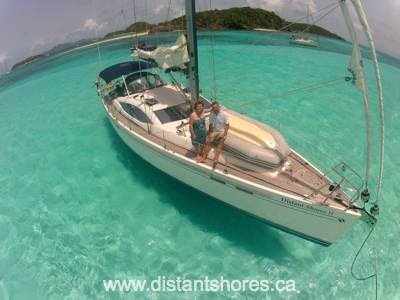
Sheryl and Paul Shard aboard their Southerly 49, Distant Shores II, in the Tobago Cays
September has been a month of celebration for us aboard Distant Shores II. On September 3rd the Distant Shores TV series was launched on the brand new Cottage Life channel and is now airing primetime across Canada in back-to-back episodes at 6:00 PM ET and 6:30 PM ET daily Monday to Friday. (Where to Watch). September 21st was Sheryl's birthday and also the 24th Anniversary of the day we set sail from Toronto, Canada, on our first international cruise.
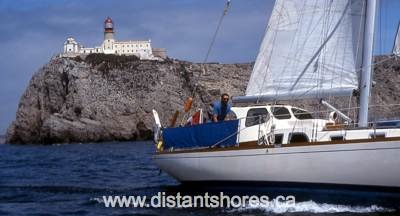
Completing a transatlantic passage at Cape St. Vincent, Portugal, aboard their self-built Classic 37, Two-Step
All month we've been reminiscing about the magical places we've sailed to and the amazing people we've met over the years. And since September is a time that so many people head south on their first cruise we thought we'd share some thoughts on Lessons Learned during 24 years of cruising.
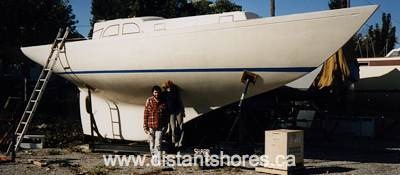
Paul and Sheryl in the boat yard at Port Credit Yacht Club on Lake Ontario in early stages of building Two-Step
Before setting off on our first international voyage, Paul and I had been sailing our self-built Classic 37 sloop, Two-Step, (our wedding present to each other) on the Great Lakes of Canada. We were in our 20's, had saved our money after paying off our student loans, spent 3 years building and sailing our new boat, and were looking forward to heading south from Toronto for adventures in warmer climes. The plan was to take a 1-2 year sabbatical and then settle down. The “settling down” part never happened.
Lesson Learned – Going Cruising is Life Changing
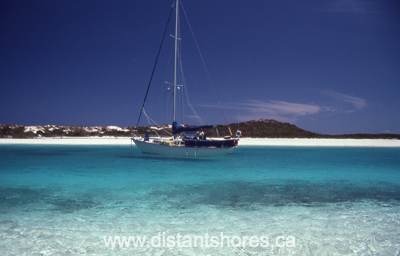
Two-Step at anchor in Warderick Wells, Bahamas, 1990
Our 1-2 year sabbatical to explore the Bahamas and Caribbean stretched into a 3-year Atlantic Circle taking us across the Atlantic to the Med then south to Brazil before returning home briefly via the Caribbean. We found that the money we'd saved went further than we'd thought as our experience grew. We anchored more than staying in marinas, discovered the fun of shopping in foreign markets and cooking on board versus eating out in restaurants and did our own repairs and maintenance which saved a bundle. Since we'd built our own boat we had the tools and know-how. We gave up our early-marriage apartment and sold our furniture, so had no additional expenses such as mortgage payments, house insurance or utilities, etc. while cruising. Our budget for that first cruise was $1,000 US a month and we lived and explored well. Here's a link to an article we wrote and recently updated about the Costs of Cruising.
Lesson Learned – Cruising Life Can be a Very Affordable Lifestyle
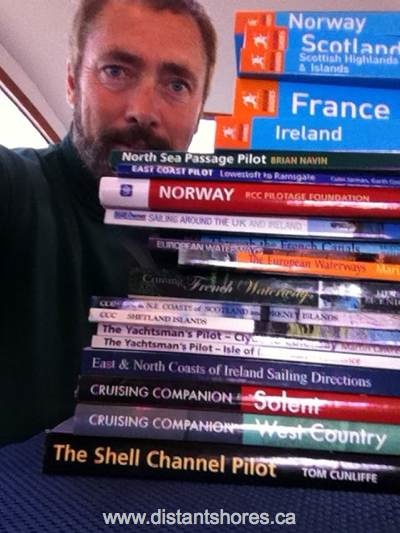
Stack of cruising guides for the Distant Shores season 8 cruise, 2011.
Our background and work training is in photo-journalism and television production so it's natural for us to share our cruising experiences this way. Our one-hour travel documentary about our first 3-year cruise, Call of the Ocean, was picked up Discovery Channel in 1992. This led to our first sailing TV series, Exploring Under Sail, which we co-produced with Canadian director, Peter Rowe (Angry Planet, Adventures in Filmmaking) and required that we do another couple of years of cruising. Twist our arms! When that contract ended we were ready to go out on our own with the Distant Shores sailing adventure TV series which is now in its 9th season with 117 half-hour episodes and is broadcast worldwide in 24 languages. You can download all the episodes and also get them on DVD. We also published a book, “Sail Away! A Guide to Outfitting and Provisioning for Cruising”, which became a best-seller with 11,000 copies sold. We're currently updating the book to a 3rd edition.
Lesson #3 – There are Many Ways to Earn a Living While Cruising
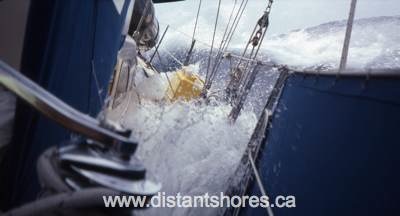
Caught in a storm on their first transatlantic passage aboard Two-Step
During the 24 years that we've been cruising we've put over 90,000 nm under our keels. We've crossed the Atlantic Ocean 5 times, most recently last December as participants of the Atlantic Rally for Cruisers (ARC), which we filmed in a 3-part series released in August. Our first transatlantic crossing was from Bermuda to the Azores in 1990. We were excited and nervous as we waited in St. George's Harbour in anticipation for front after front to pass by Bermuda so we'd have a good weather window to make the jump. Two weeks went by. Boats were gathering. We were afraid if we had to wait any longer we'd lose our nerve. There was a small break in the weather and a few us convinced each other we should go for it. Within 24 hours the coming front sped up and caught us at sea. The winds howled and there was no way of turning back. The seas built to the size of 2-storey houses and we fought the conditions for 3 exhausting days and nights. Finally we hove-to to get some rest and the storm passed on. We faced the nightmare and got through it arriving safely in Horta, Fayal, in the Azores 18 days later, somewhat shaken but undaunted.
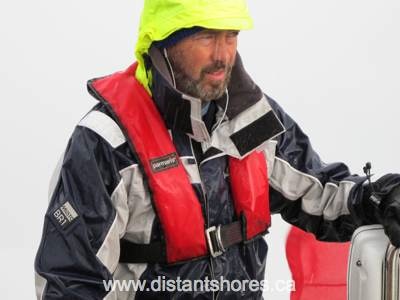
We've never had such a bad experience again. Why? Now we wait for reliably good weather. We have the time. And how bad can it be to spend one more week in a paradise like Bermuda waiting until conditions are good?! I mean, really. Also, we have more experience now so we strategize better if bad weather does catch us offshore, which is rare with the excellent weather forecasting and accessibility to it at sea these days via SSB radio and grib files by e-mail. Plus we aren't so anxious about heavy weather since we know what to expect, what to do, and know just what we and our boat can handle. We are unmoved by the advice of others if their decisions don't gybe with ours. We've paid the price.
Lessons Learned: Wait for Good Weather. Do What Feels Right for You and Your Crew Despite What Everyone Else is Doing.
An adjunct to the lesson above is that having a set schedule or a deadline often tempts you to sail in conditions that you normally wouldn't feel safe or comfortable in. Things such as meeting guests coming to visit you at a certain location or time. It's so important to give yourself lots of lead time and to warn your guests that if you are delayed by weather they will have to make alternate plans until you can get there. Not easy to do but the dangers aren't worth it. This is also something to think about if you're joining a rally with a set start date. We were impressed with the organizers of 2012 Atlantic Rally for Cruiser (ARC) who delayed the start by 2 days due to weather – a huge logistical decision since there were over 200 boats in the fleet, most with crew who had deadlines for flying home at the other end. Even still the day of the delayed start turned out to be miserable but off we all went. If we'd been on our own, most agreed they would never have started a passage on such an unpleasant day.
Lesson Learned: Schedules and Cruising Don't Mix
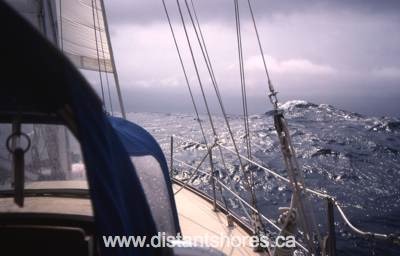
Crossing the Gulf Stream from Florida to the Bahamas
Thinking back to our first real (but short) blue water passage in December 1989 - a one-night crossing of the Gulf Stream from Florida to the Bahamas where we were going to cruise for the winter of 1990. (We loved the Bahamas and have been back to cruise many times over the years!) Knowing it would be hard to get certain foods and supplies in the islands and that things would be much more expensive than in the US, we loaded the boat on that first crossing with so much stuff that she became top heavy. The lockers were bursting with provisions and the decks were covered in fuel and water jugs as well as a couple of extra propane cans. We waddled across the Gulf Stream in gentle conditions but later, in heavy weather down-island, the boat rolled dangerously and we took water over the decks.
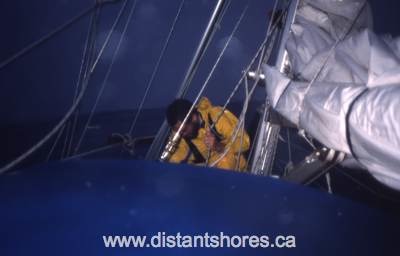
Paul clipped on during rough conditions
A propane tank broke loose and started bashing against the fibreglass hull. Although Paul was safely clipped onto the boat with his safety harness, it was a risky manoeuver in the pounding seas to get that propane tank back on board. Now we keep our decks clear and cargo weight as low and centrally distributed as possible. We still carry a lot of stuff since we like the independence and self-sufficiency, but now never at the expense of the safe performance of the boat. This goes for gear and equipment too. Better to have a simply equipped boat that's seaworthy than have a boat loaded with all the latest equipment, toys and appliances that makes the boat dangerous to control.
Lesson Learned: Clear the Decks
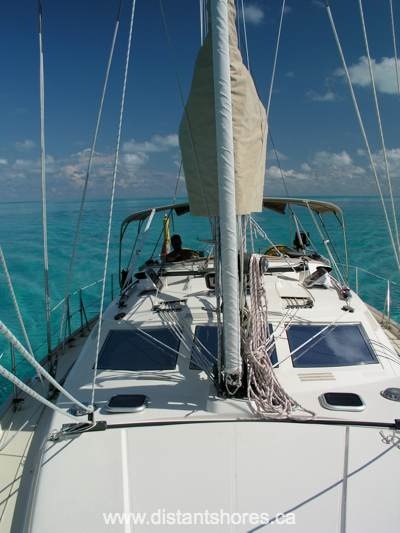
Paul had a lot more sailing experience than I did when we set sail in 1989 so we made a deal that if I wasn't comfortable with the conditions on a planned day of sailing that we would wait, change the plan, or turn back if we were already at sea. Paul knew that even if my fears were unfounded, if I got traumatized that would seriously affect the future of our cruising plans. We both were committed to making our sailing sabbatical a happy experience for both of us. Because we respected this agreement I felt safe to stretch myself if I was a little nervous about the conditions since I knew if it got to be too much Paul would turn the boat around or head for shore sooner than planned. This really helped me to build my experience and confidence and I am forever grateful to him. Twenty-four years later we're both still loving the cruising life!
Lesson Learned: Respect the Fears of Your Mate and Crew
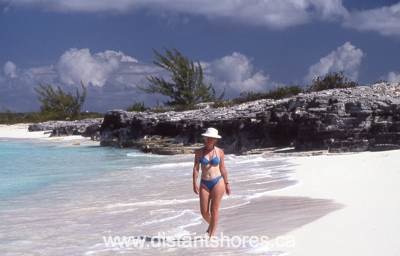
No need to rush. Keep it fun for everyone. Sheryl strolling a Bahamian beach 1990.
Something that I don't see written about very often with regards to cruising is “travel weariness”. This often sets in when you've been on the move for awhile and start to get impatient with things and each other. Stuff you got excited about in your early days of cruising you don't notice anymore or start taking for granted. You feel physically uncomfortable. The fun has gone out things. This is the time to stop.
You may need to stop for only a day or two if you've been on the move at a fast pace for a few weeks, a common problem with first time cruisers used to one-week packed-full boating vacations. You can't keep the same pace long-term. Sometimes you need to stop for a month or so to do maintenance and enjoy the pleasures of getting to know a place really well and make local friends. Sometimes it's good for the crew to get off the boat for a night or two and enjoy the luxuries of comforts in a hotel ashore if you've had some miserable weather.
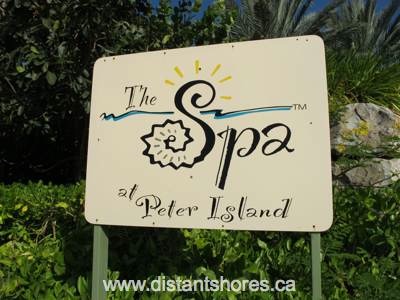
Sometimes the break needs to be even longer – a year or several years due to family or work issues. But think of it as just a break. Not that “it's over”. Most people head out again sooner or later.
After our first 3 years of full-time cruising we really started getting travel weary so knew it was time to head home. Within a year we had regained our enthusiasm and were back “out there”. Our work now requires that we're home working in the studio for several months each year and this half-on half-off the boat experience is the perfect balance for us. We never get tired of things and are enthusiastic wherever we are – home or ashore. Many cruisers we meet have adopted this part-time cruising lifestyle, storing their boats for part of the year to make visits home to work or see the family or travel in different ways.
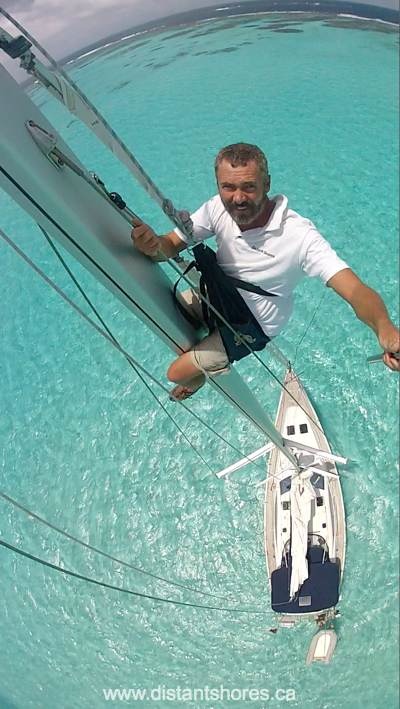
Paul doing a rigging check in the Tobago Cays
You should never feel bad if you start noticing that you've lost some of your enthusiasm for the cruising life. People commit so much to making it happen that they feel as if they are giving up on the dream when they realize they aren't having fun anymore. And they're often afraid to voice these feelings to their partner or crewmates which just makes it worse.
Sometimes it just takes a small change to put the sparkle back into things again.
Lesson Learned: Take a Break Once in Awhile
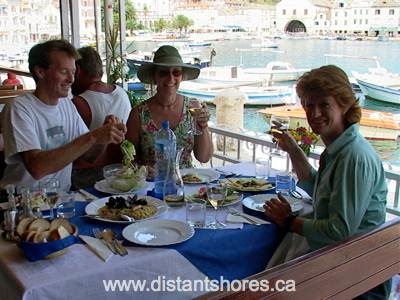
Experiencing the local cuisine in Croatia with cruising friends.
But really, it's pretty easy to keep things fun while cruising. You meet such great people wherever you go, both from the cruising community as well as local people. The friends you make become good friends since you have so much in common and are sharing exciting experiences together. And you will be blown away by the kindness you are shown by strangers. Throughout the world we have met so many amazing local people who have helped us out, invited us to their homes, given us a lift, even loaned us their cars!
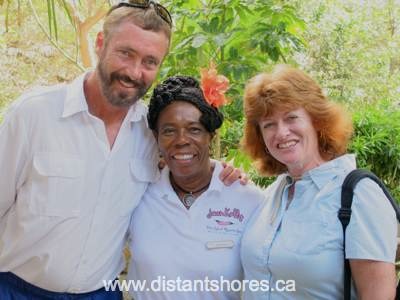
Paul and Sheryl with Jean at the Dead Man’s Beach Bar, Peter Island, BVI
When you watch the news you can feel that the world is an unfriendly dangerous place. Sure there are dangerous places but you can avoid them and if you don't like something or someone you can just raise anchor and leave when you're cruising. I don't deny that there are baddies out there but on the whole we have discovered that the there are a lot of nice people out there and meeting them is one of the greatest joys of cruising.
Lesson Learned: The World is a Friendly Place
So if you're cruising now, just starting out, or still dreaming of cruising, we wish you all the best and look forward to meeting you “out there”.
Fair winds,
Sheryl and Paul Shard
Aboard SY Distant Shores II
St. Georges, Grenada
You Might also like the following...
Tropical Storm Chantal Arrives
Making Money While Cruising
Maintaining a Homebase
About the Southerly 49
Top 10 Canal Journeys
On On - Hashing in Grenada
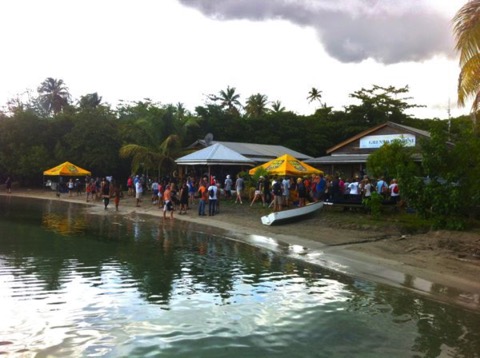
Yesterdays Hash started at Grenada Marine in St David’s - here everyone is being briefed on the route (there were three trails, a short and long "runners" option plus a shorter walkers trail.
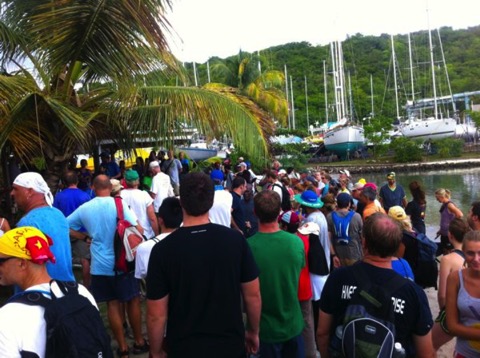
Back in Gibraltar we used to get 25-50 hashers out, here in Grenada there are 200-400 or more!! Its a very fun mix here, from young kids to seniors, university students from the Medical School (this could come in handy!!) locals and cruisers!
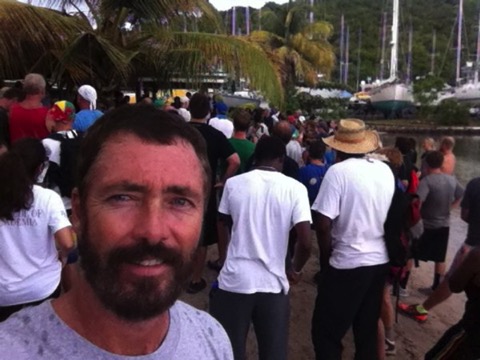
The course will ALWAYS take you somewhere you haven’t seen before. Here we are scrambling down a ruined tower and out a hole onto the beach. Note its been raining... a bit slippy today!
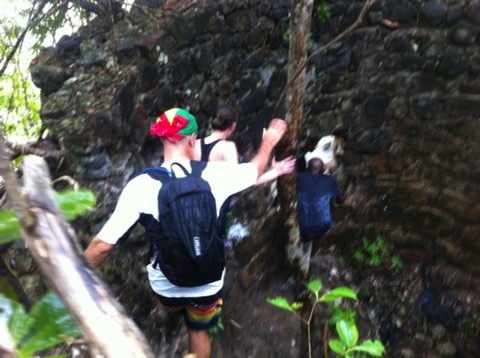
The runners trail took us along the steep shoreline with a few quite tricky bits. Walkers are generally spared the toughest bits. When I say "runner’s" trail note almost no one could actually run the whole thing because of these scrambles, climbs, crawls etc.
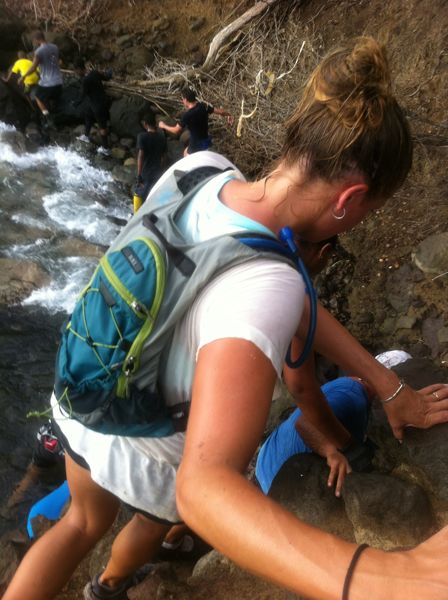
Wading along the shoreline for a bit to make sure we all have gravel in the shoes!
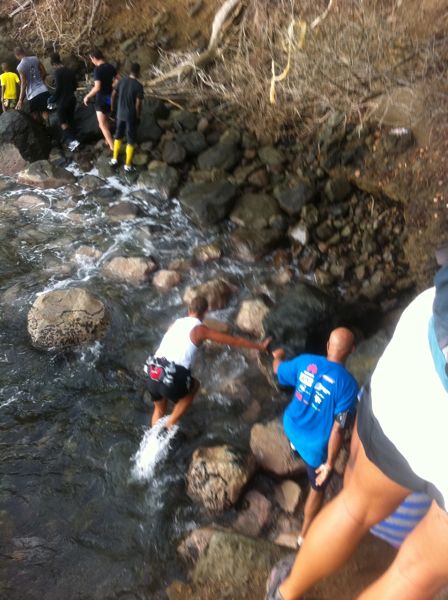
It’s 7 km altogether when we get back to the seashore and wade along the last leg to the finish line. I have fallen twice including once flat in the mud, but then fell again in the river so am all cleaned off!
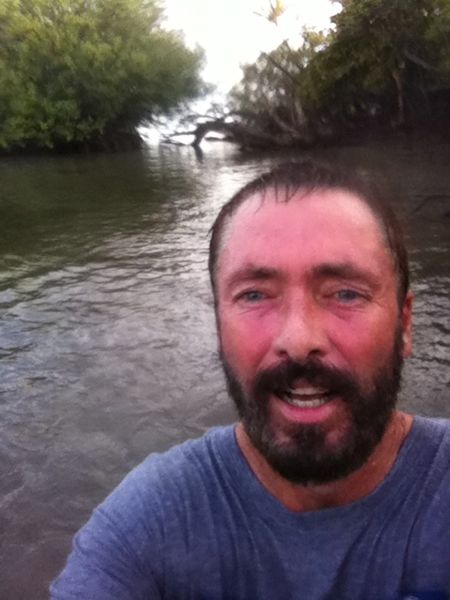
Fell on slippery grass/rocks and skinned my knee. This looked terrible in the rain with blood running down into my sock, but now its been rinsed by wading in the seawater so it doesn’t look so bad.
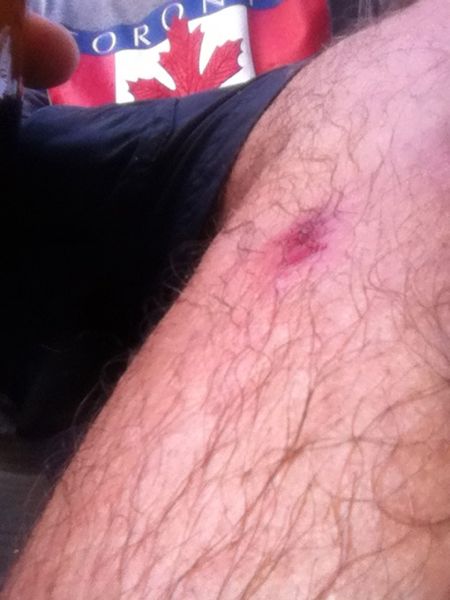
Beers are 3 for $12EC (which makes a beer less than $1.50US) Dinner is a hearty Grenadian "oil down" or a chicken leg for EC$10 (which is $3.70) All very affordable!
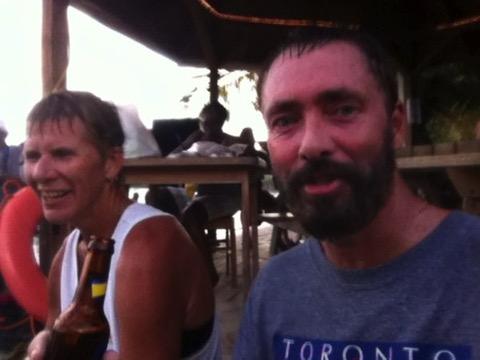
Where will the next Hash be? Always fun and new! If you have a Hashing Club near you they could be a fun way to meet people, see the local area, and of course drink beer and have fun!
Grenada - J'Ouvert Carnival
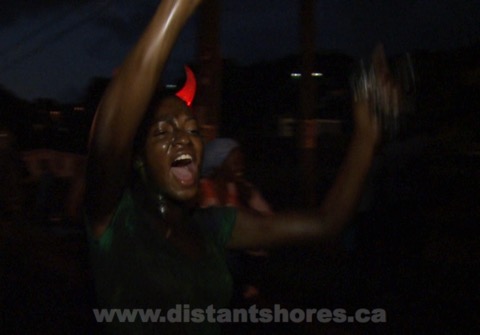
Wear some old clothes as almost no one goes unscathed - however most people ask if you want some paint first... red anyone??
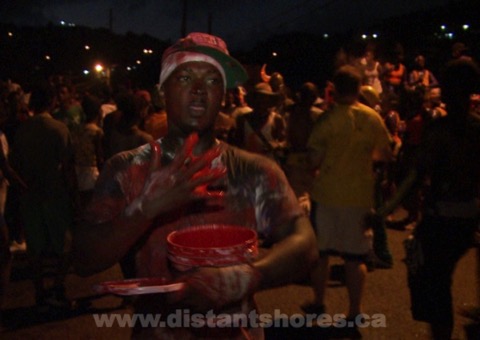
Traditional outfit has horned helmets, and body smeared with motor oil or molasses (we saw mainly used motor oil).
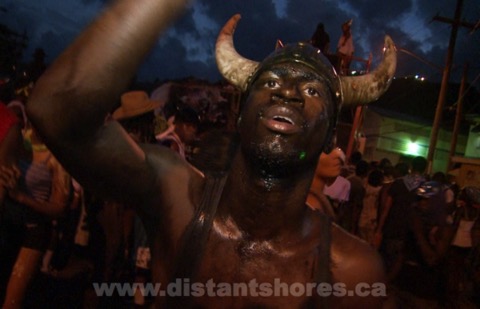
MANY thousands of revellers take part. Trucks with sound systems lead individual "bands" and you can join a band if you like. More on that later... This is the Carib beer "band"
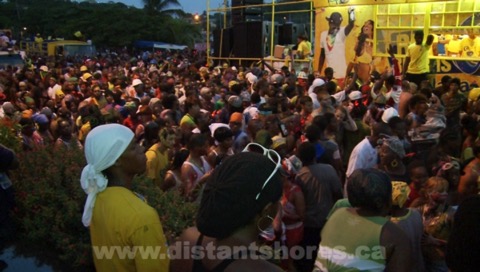
Many of Grenada’s "St Georges University" medical and veterinary students attend and participate.
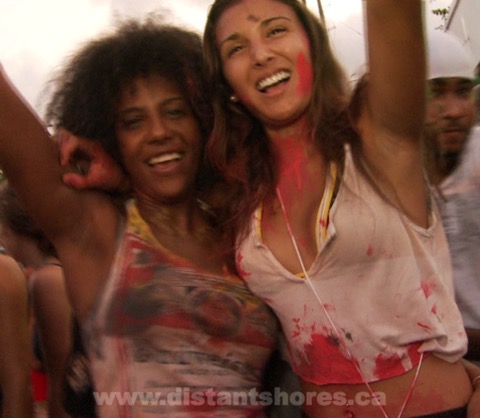
Silver and Gold body paint looks excellent!
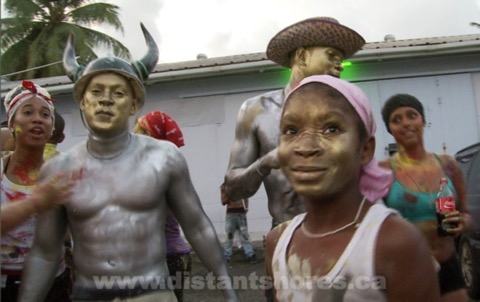
Paul decides to go for the gold!
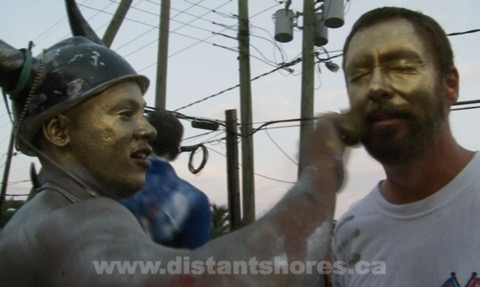
Hopefully this will wash off!
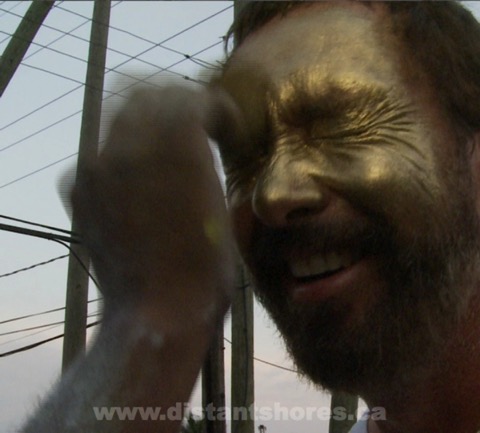
The golden look! Veterinary student in the horns has added some red paint!

Silver band!
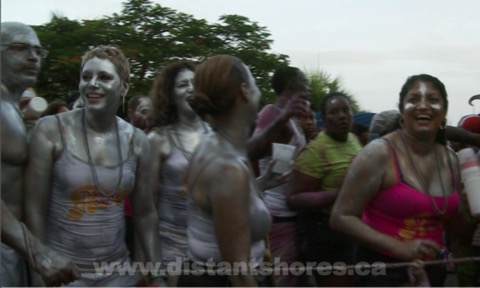
Passing revellers interact with the crowd and offer to add to the costume...

Dancing revellers approach Paul to say hello!

Shake your bungee!!
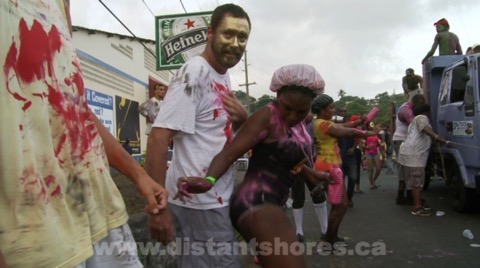

"What a freindly island this is" says Paul

Grenada has solved the question of what to do with used motor oil... the "Black and Greasy" Jab-Jab band approaches...

10W40?
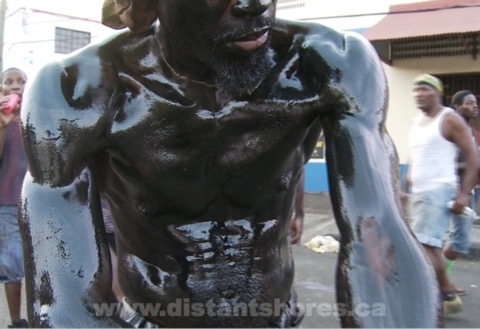
If you do choose this option it is a good idea to put on some lard or baby oil as a barrier first!
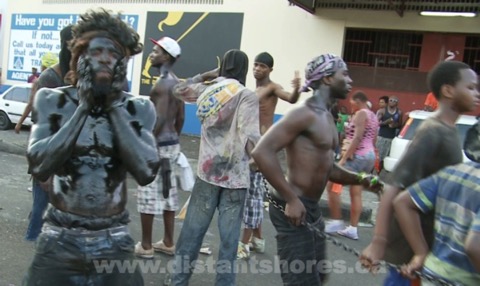
Mud is another traditional coating, and many carry chains!
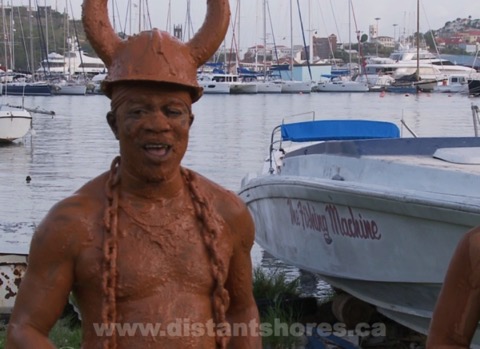
I have now "paid EC20 to get the band kit from the truck on the left. This included the attractive hat, a pot of paint, a shirt and a nice waterproof phone case! Fellow cruiser Lynn adds purple paint.
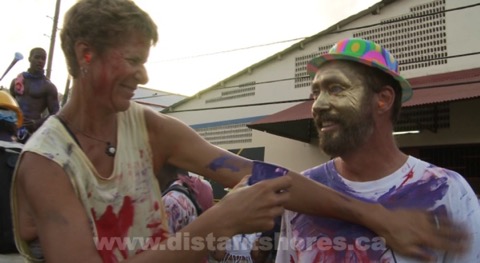
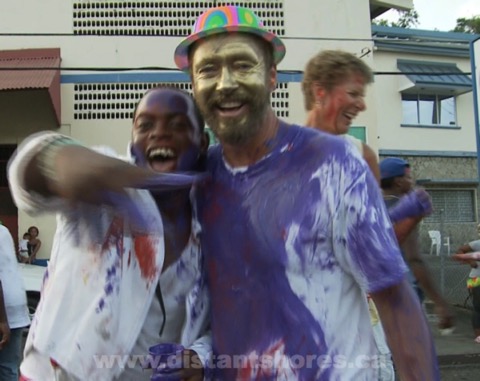
Sheryl doesn’t escape ... Paul offers a "painty" hug and Jab-Jab offers additional motor oil from behind!
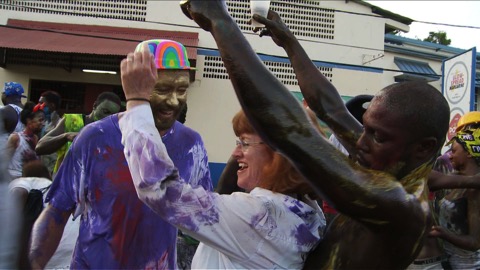
Paints are latex and will wash off later...
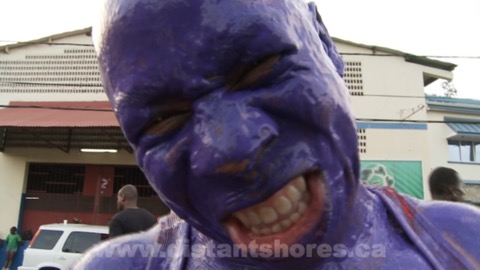

Motor oil will be much harder to get off...
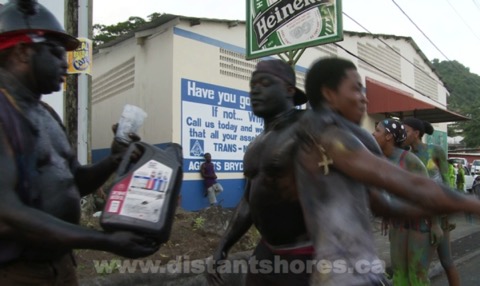
We discover the Chocolate band!!! Yes real chocolate made on the island. You can eat the stuff right out of the paint pots, or just pour it on!!
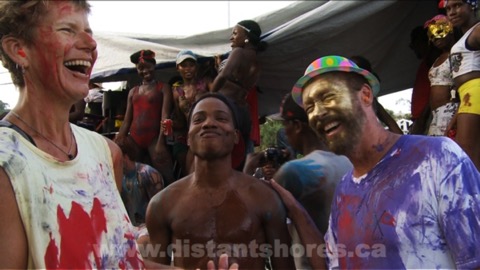
700am we are back at the Marina. Marina security guards have set up a J’Ouvert cleaning station with some soap and a hose... How thoughtful!!!
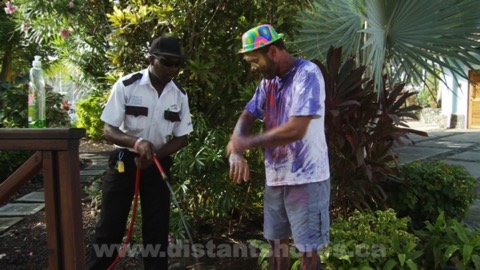
Grenadines - Bequia to Tobago Cays
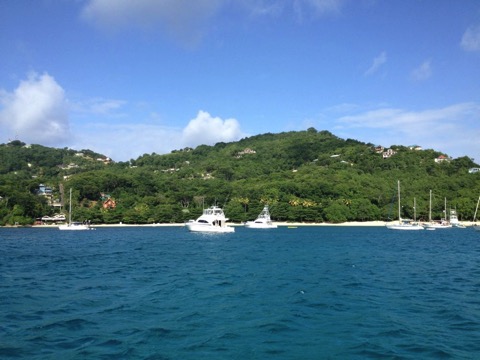
We made landfall at Bequia at sunset and anchored off Princess Margaret Beach in Admiralty Bay, Bequia’s main anchorage. Although pretty it can be a little rolly here in certain conditions so it’s actually better and more convenient to anchor closer in towards the town.
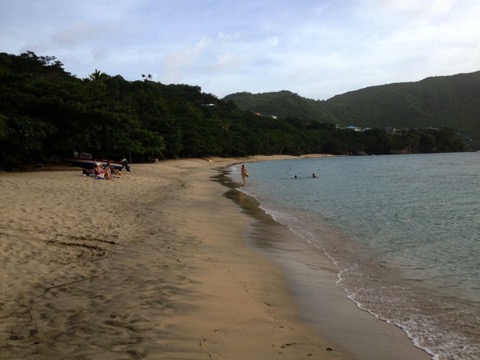
On our first day ashore the weather wasn’t good. It bucketed rain for most of the day so we didn’t take any photos in the charming town of Port Elizabeth where we went to clear-in. The Customs and Immigration office is conveniently located right near the town’s main dinghy dock, opposite the ferry dock. For more information click here. We’ll be doing more filming in Bequia in the fall so will have lots of great photos to show you then. However on the second day we had a nice stroll along Princess Margaret Beach.
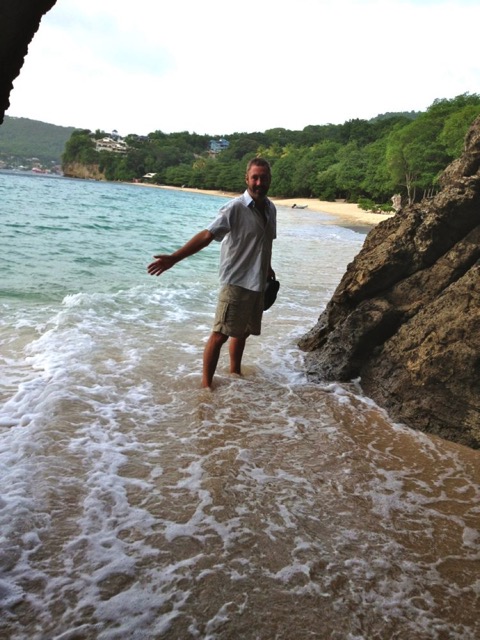
There are caves and grottoes at the south end of the beach that are fun to explore.
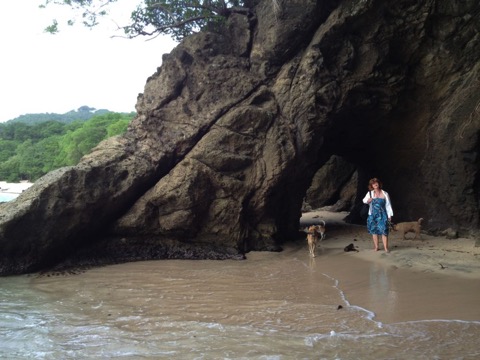
We were accompanied by 3 local dogs as we went for our walk, all friendly.
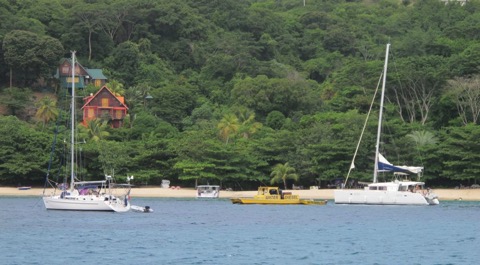
Bequia really caters to yachts. There is a boat that comes around daily that can fill your fuel and water tanks right at anchor. Bequia is a popular destination for charter boats and cruising sailors alike so although it’s only a tiny place there are several chandleries, sailmakers, etc. and lots of upscale restaurants and food shops. You can get just about anything here.
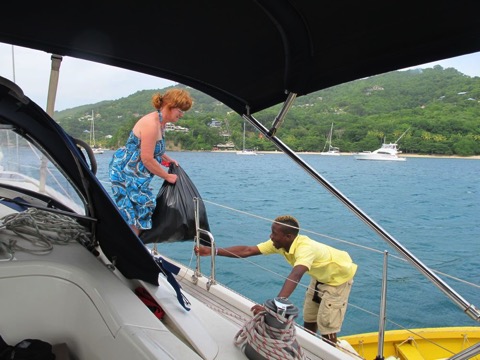
The guys on the fuel/water boat will also take away your garbage. They charge $5 EC or about $2 US to collect a large bag. A great service!
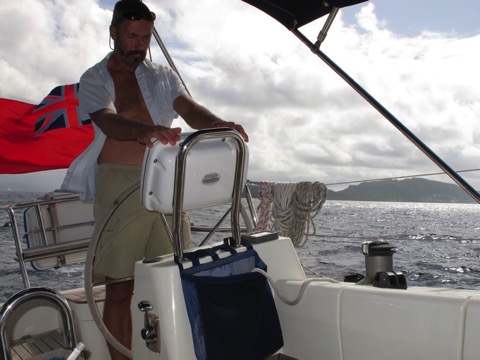
On Sunday July 21st we left Bequia and sailed 25 nm miles south through the Grenadines passing Mustique, Canouan and Mayreau - destination the Tobago Cays.
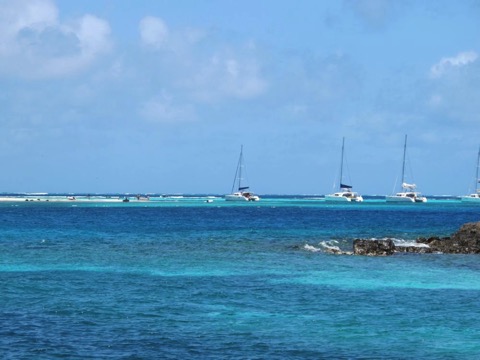
The Tobago Cays are a group of several little uninhabited islets in the protection of the huge Horseshoe Reef. Our last visit here was 21 years ago and we were delighted to see that it hadn’t changed much. It is now a national park with park fees of 10 EC ($4 US) per person per day which is collected by a very friendly park warden.
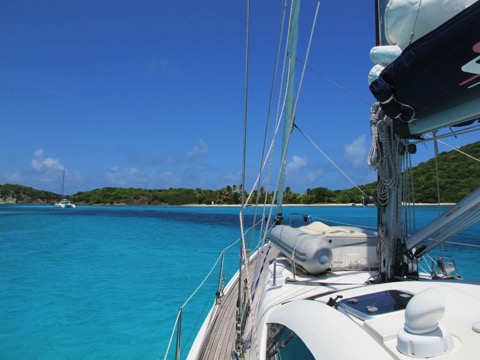
If you have followed our adventures over the years you know we love the Bahamas and the beautiful swimming pool blue water there. The water surrounding the Tobago Cays is the closest we have ever seen to the Bahamas water. Ribbons of blue hues varying with the depth of the water are a joy to the eye.
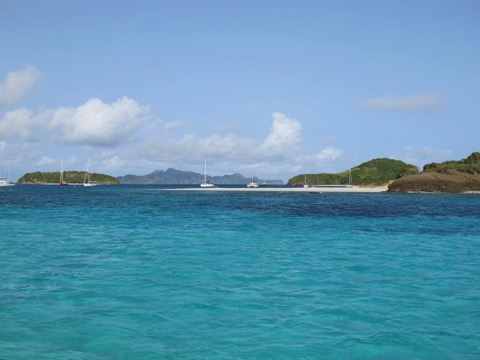
The beaches are sugar white sand and you can often see turtles on them and in the surrounding water. Since the Tobago Cays are a protected area you are not allowed to fish but local boat vendors come by and sell fresh fish and conch they’ve caught elsewhere.
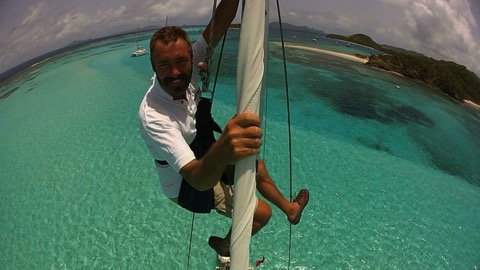
Paul just had to climb up the mast to get an aerial view.
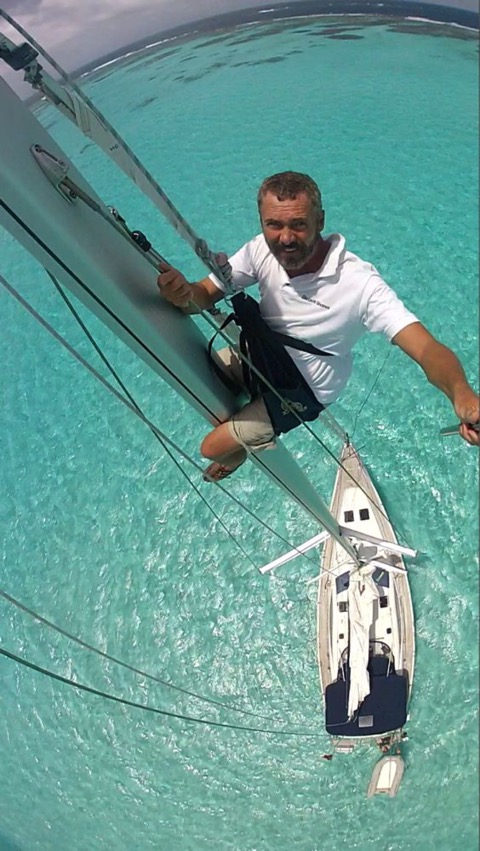
It’s a long way up our mast! You can see Horseshoe Reef in the background. The reefs are all that is protecting you from the swells of the open Atlantic Ocean in the Tobago Cays. Anchored behind the reef you are looking straight towards Africa! The snorkelling is good on the reefs but you do have to be careful of the currents. There are mooring balls to tie your dinghy up to so you don’t risk damaging the coral with your dinghy anchor.
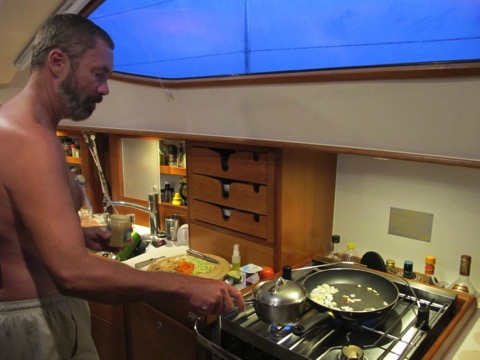
After all the fresh air, sunshine, and snorkelling we had a good appetite so Paul made a delicious curry for dinner. Both Paul and I love to cook!
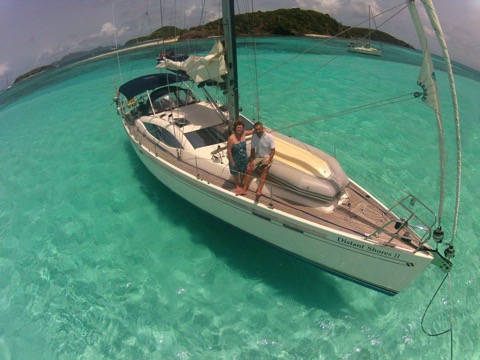
We spent 2 days and nights anchored in the Tobago Cays and then went on to explore another favourite Grenadine island, Union Island, to the south. But more on that next time...
More News
Interview on The Sailing Podcast
We recently did an interview with David Anderson on TheSailingPodcast.com discussing the highlights of our 23 years of cruising, ways to earn a living while cruising, and our recent experiences participating in the ARC (Atlantic Rally for Cruisers). Click here to listen.
Kind regards,
Sheryl and Paul Shard
Aboard SY Distant Shores II
Tobago Cays, St. Vincent and the Grenadines
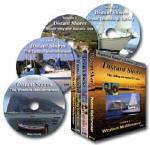
Click here to check out our DVDs for more cruising adventures and tips!
Distant Shores TV Show Facebook
Distant Shores TV Show Twitter
St. Lucia to Bequia
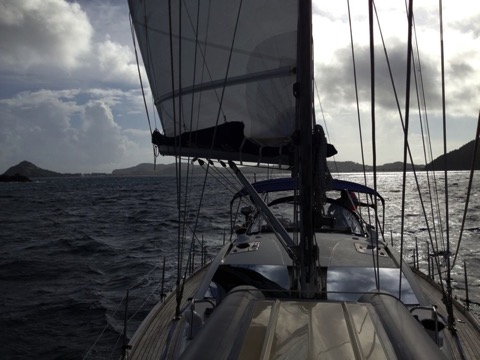
So early morning on Wednesday July 17, just 5 days after our arrival, we set sail from the Rodney Bay anchorage headed for the island of Bequia in St. Vincent and the Grenadines.
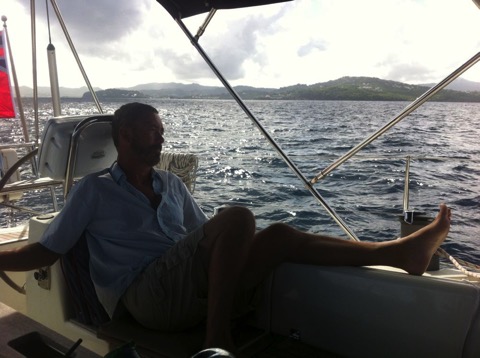
It was another morning of relaxed sailing as we travelled along the leeside of St. Lucia passing the port of Castries doing 7.5 kts under main and genoa. When sailing here in the Windward Islands of the Caribbean there is almost always a nice breeze on the beam. Love those trade winds!
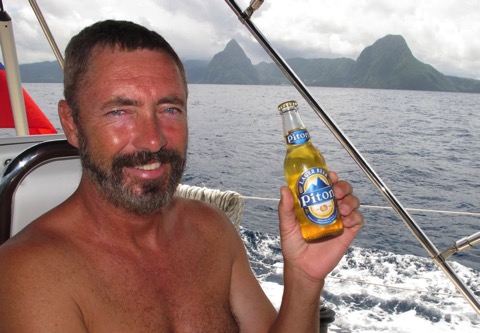
Towards the south end of St. Lucia are the Pitons, famous twin peaks. The local beer is named after them.
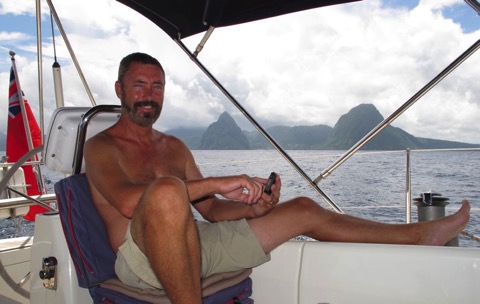
We still had a good signal on our iPhone as we sailed. We have a local sim card in it from Digicel that includes a data plan so we could post updates to the Distant Shores TV social media sites (Twitter and Facebook) as we sailed along the autopilot steering while we both stood watch.
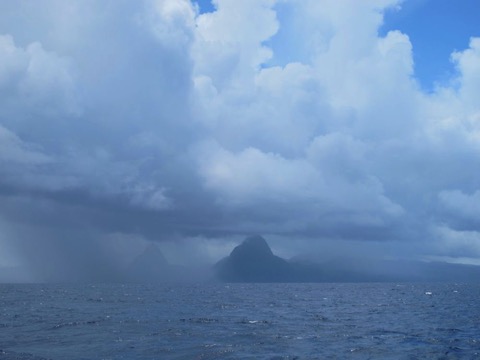
Just as we passed by the Pitons a big squall came zooming across the island heading out to sea just missing us!
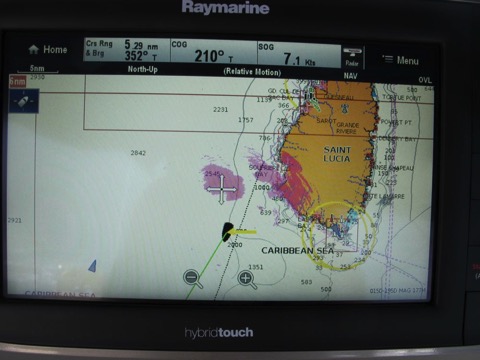
We have a radar overlay on our Raymarine chartplotter which shows the squalls (the pinky purple blotches) indicating the squalls passing behind us as they roll off the Pitons. We’re now entering the St. Vincent Channel at the south end of St. Lucia so will be in open water for about 30 nm.
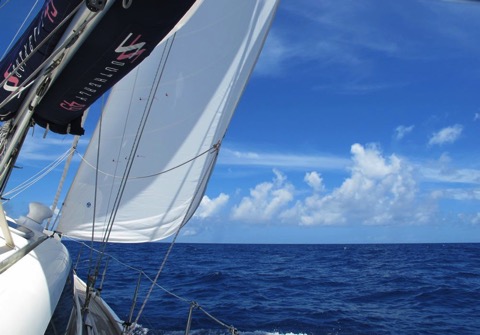
Although there are squalls behind us, the view ahead is clear and sunny. We have a great sail across the channel to the north end of St. Vincent.
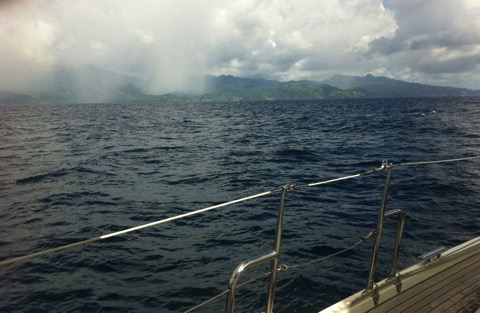
When we get to St. Vincent we see lots of rain showers along the coast of the island but fortunately none come out to sea.
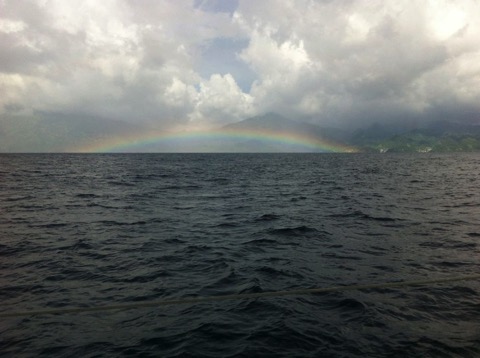
We saw this amazing low-level rainbow as we sail along!
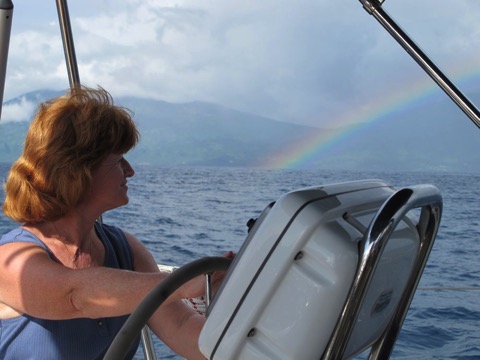
In fact we saw lots of rainbows as we sailed past St. Vincent. Magical!
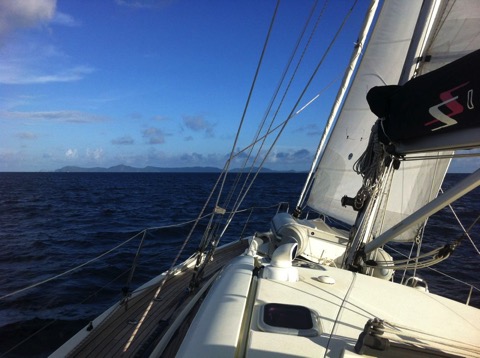
In the late afternoon we reached the south end of St. Vincent and headed out into the Bequia Channel. Now close-hauled we furled in the genoa and furled out our small self-tacking jib which is great in these conditions. Just 9 nm to go to Bequia in the Grenadines!
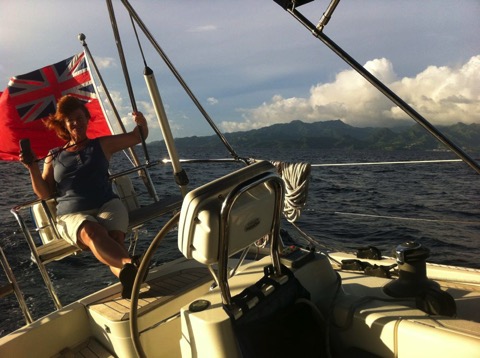
Sheryl on the stern rail bench steering with the Raymarine autopilot remote. St. Vincent in the background.
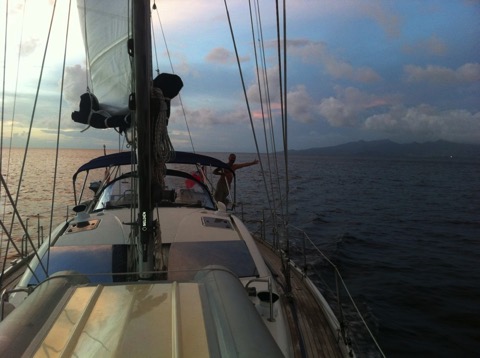
We make landfall in Bequia at around 1830, just before sunset.
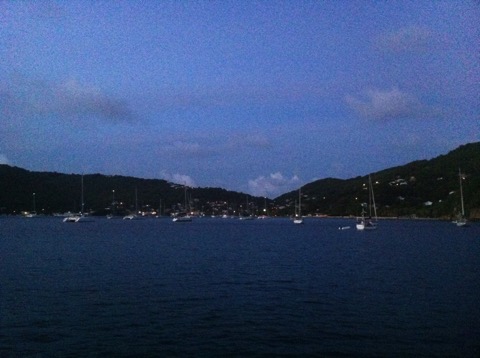
It’s been 21 years since we were last here anchored in Admiralty Bay in Bequia, St. Vincent and the Grenadines! Many fond memories.
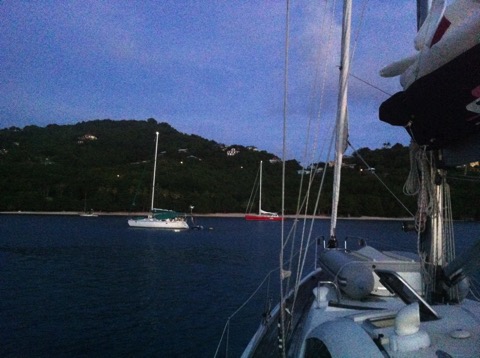
We anchor off Princess Margaret Beach and have dinner on board in the cockpit. Customs and Immigration is closed until tomorrow so we’ll go ashore and clear-in first thing in the morning...
Have a good evening, Everyone!
Sheryl and Paul Shard
Aboard SV Distant Shores II
Bequia, St. Vincent and the Grenadines
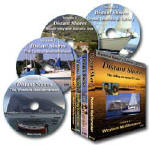
Click here to check out our DVDs for more cruising adventures and tips!
Distant Shores TV Show Facebook
Distant Shores TV Show Twitter
St. Lucia - Carnival
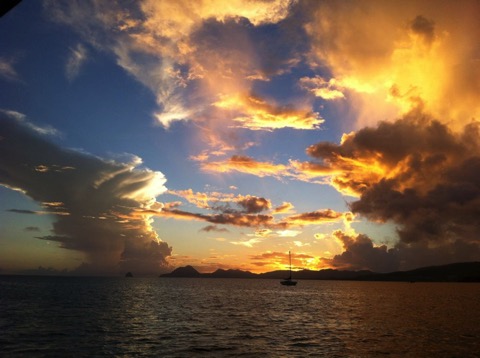
We had spent over 3 weeks cruising around the French island of Martinique and were now looking forward to a return visit to St. Lucia, the next island to the south. Carnival festivities would be starting in St. Lucia in a few days so it was a perfect time to be there.
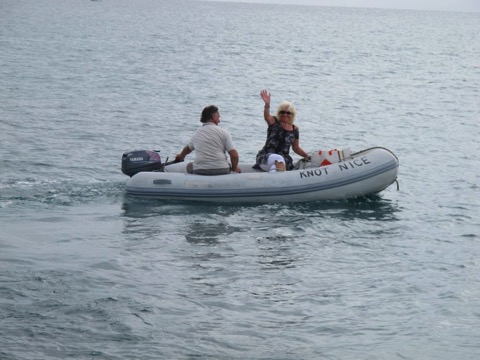
We raised anchor in Marin at 0730 on July 12 and as we did a dinghy shot out towards us from across the anchorage. It was our French sailing friends, Jean-Noel and Babette from SY Julie Premiere who we had first met 6 months earlier in Morocco, coming to say goodbye. Babette passed us a bottle of excellent French wine with instructions to open it later and remember the happy times we had all spent together. Our friends are staying in Martinique to work for a while so we won’t be meeting up with them on the cruising circuit for another couple of seasons.
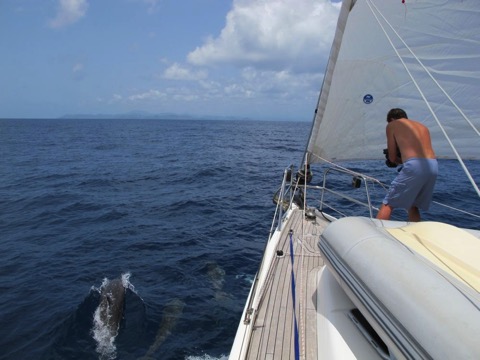
To reach St. Lucia we had only to sail 25 nm across the St. Lucia Channel to Rodney Bay, our destination on the northwest corner of the island. It was nice that the winds were light since we'd just re-rigged the sails after taking them down during Tropical Storm Chantal a week ago. it was a good opportunity to make sure that everything was as it should be in gentle conditions.
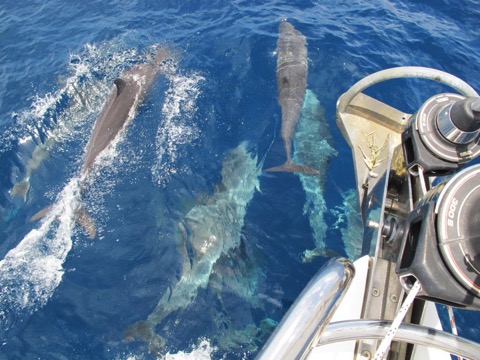
Dolphins came to play at the bow of the boat as we sailed along adding further to the sense of contentment we were feeling this day.
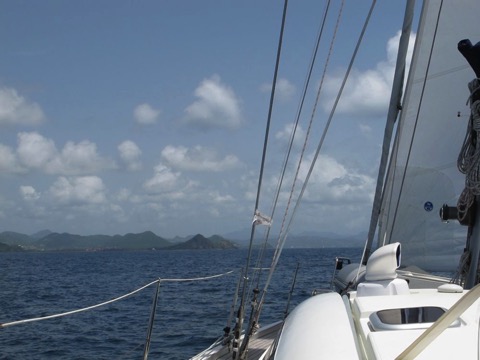
Pigeon Island, which protects the north side of Rodney Bay, soon appeared on the horizon. The last time we had sailed past Pigeon Island had been in December when after 15 days at sea sailing from the Canary Islands of Spain we had crossed the finish line for the Atlantic Rally for Cruisers (ARC) completing our 5th transatlantic crossing.
Clearing-in at St. Lucia
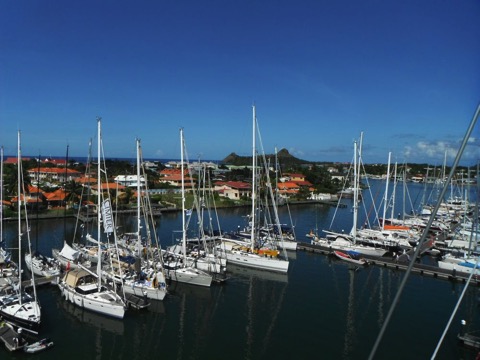
To clear-in we went into the Rodney Bay Marina, one of the IGY group of marinas found throughout the Caribbean which are all lovely and well equipped.
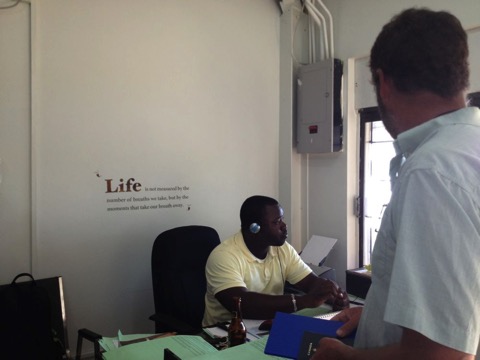
Customs, Immigration and Port Authority officials are all in one office right in the marina found upstairs next to the marina office. Information on clearing in with your boat can be found here.

We liked the saying that the port authority officer had painted on the wall behind his desk: "Life is not measured by the number of breaths we take, but by the moments that take our breath away."
Marina Services
Rodney Bay Marina has every type of yacht service and facility you can imagine along with restaurants, boutiques, ATM and bank, laundry services, a swimming pool, a florist and a couple of nice spas. Following 15 “fast and furious” days at sea on our transatlantic crossing in December, I visited one of the spas and the ladies there gave me a morning of pampering which completely restored my sense of well-being. So naturally I had to go and say hello and have a pedicure on this visit. It's good to treat yourself to pampering every once and a while.
When Paul and I had been at the marina following the ARC, we'd had some sail repair work done by the local sailmaker, Kenny Abernaty of Rodney Bay Sails (Mobile: +1 (758) 584-0291 or rodneybaysails@hotmail.com) Kenny had done an excellent job at very reasonable rates so while we were there on this visit we took in our mainsail cover to have the zippers re-stitched. After 3 years of exposure to the sun and wind some of the stitching was disintegrating. We dropped off the sail first thing in the morning and Kenny had it done before lunchtime.
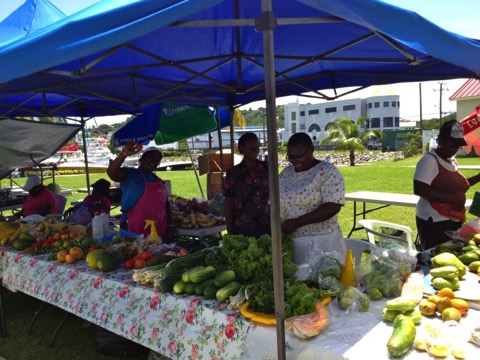
Saturday is market day at Rodney Bay Marina. It's such a treat to be able to buy fresh locally grown produce right in the marina and have a chat with the friendly vendors that run the market.
Lucian Friends
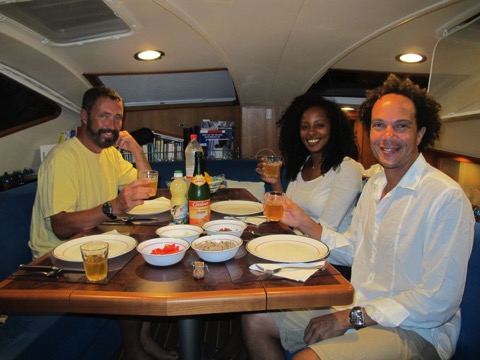
We also caught up with local friends including Sean Compton, a Lucian architect and owner of Melon Design, who serves on the ARC Planning Committee. We'd met Sean through the ARC (Atlantic Rally for Cruisers) and when after the rally we’d sailed north from St. Lucia up through the islands to St. Maarten to meet the family for New Years, Sean and his girlfriend, Vern, had joined us for a fun-fllled week of sailing and lessons in local cuisine.
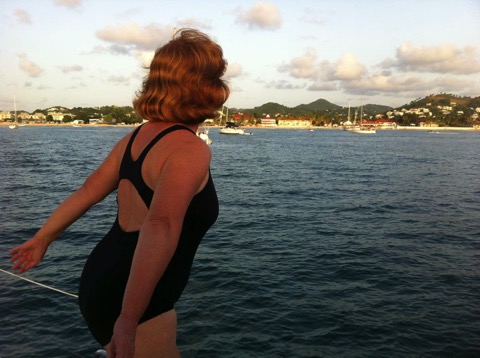
With our chores done and water tanks topped up we left the marina to anchor outside in Rodney Bay where we could swim and enjoy the festive beach atmosphere. Sheryl’s auburn hair is going strawberry blonde in the tropical sun!
Communications
The marina offered good wi-fi. Out at anchor we used our cell phone with a local sim card as a modem using a plan through Digicel that made our iPhone a personal hot spot. This was good since it meant we can be online while walking around allowing us to update our social media sites (Facebook and Twitter) with photos of events when they actually happen. The Digicel office is across the street from the Rodney Bay marina. In the Rodney Bay anchorage we were also able to pick up free wi-fi from one of the beach bars at the south end of the beach but it was a very weak signal so we prefered to use our phone to get internet access on board.
Lucian Carnival
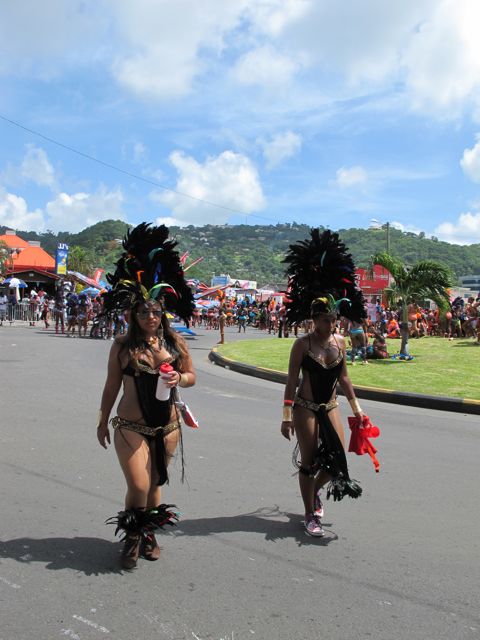
Monday July 15 was the Lucian Carnival so we hopped on one of the local buses that stop in front of the marina and headed into Castries, the capital city where the parade was to end in front of the city market. We’d been told that the parade started at 9 a.m. and would arrive in Castries at about 11 a.m. so we got there about 10 a.m. to get a shady spot along the route. However, for most of the morning we saw costumed dancers strolling casually around town and the parade didn’t actually get to Castries until about 1:00 p.m. (You may recall that the same thing happened to us the day we went into Phillipsburg to see the St. Maarten Carnival!)
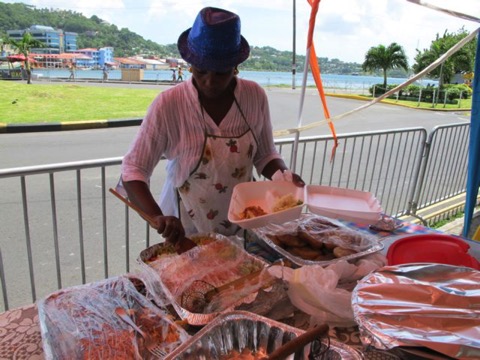
Well at least we had a good spot to watch the parade. While we waited we watched this woman and her friend prepare fresh food before our eyes for their street food stand.
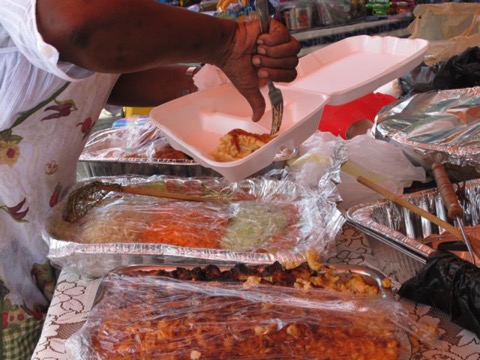
They did it all by hand and right at the roadside – chopping and grating salads and vegetables...
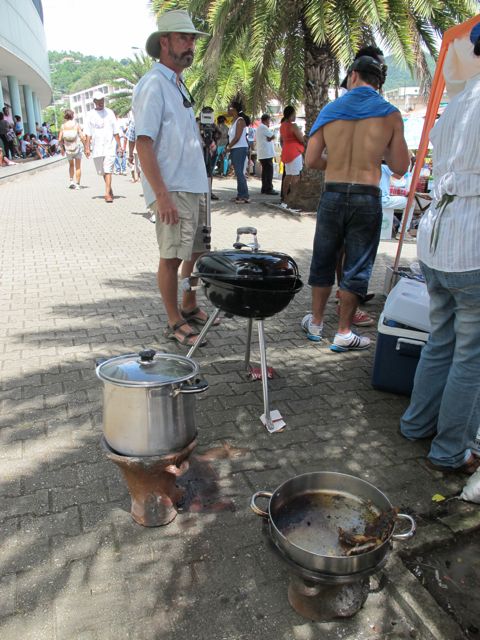
...boiling potatoes and roasting bread fruit, BBQ’ing chicken, frying fish and making sauces in pots and pressure cookers on traditional charcoal stoves set up on the sidewalk.
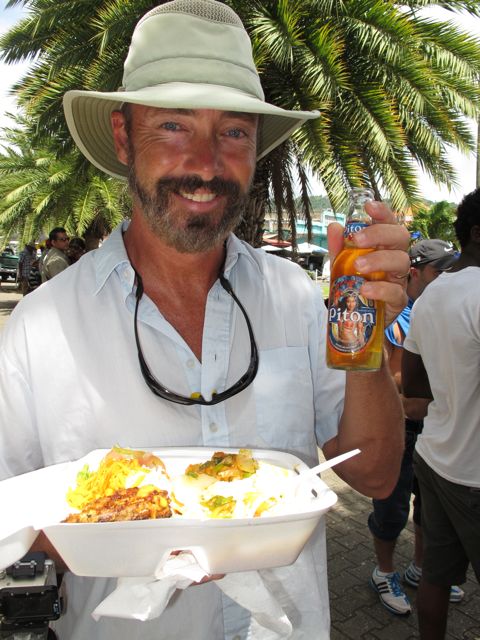
We got so hungry sitting there watching them all morning we were first in line when everything was finished! It was noon and still the Carnival Parade hadn’t arrived. However the local Piton beer being served had a special Carnival label on it so we knew we had the right day.
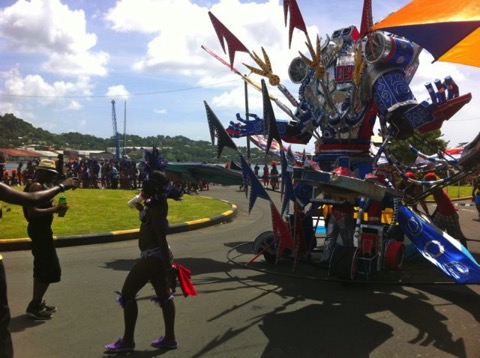
Finally the large floats and bands of dancers began to arrive about 1:00 p.m.
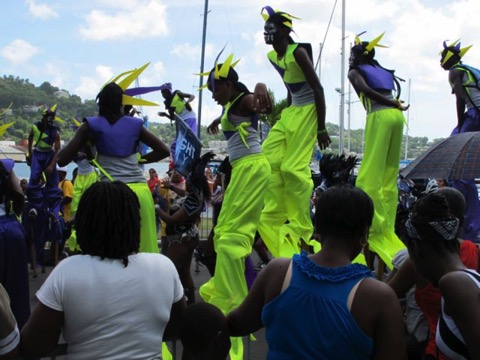
We were impressed with this band who walked the whole parade route on stilts!
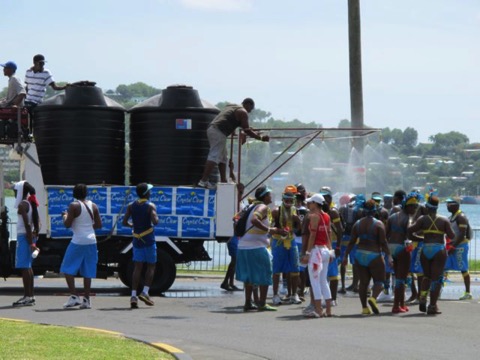
It was a hot day and the dancers were out in the blazing sun so this water truck shadowed the parade and offered the participants refreshing showers of fresh water to keep them cool.
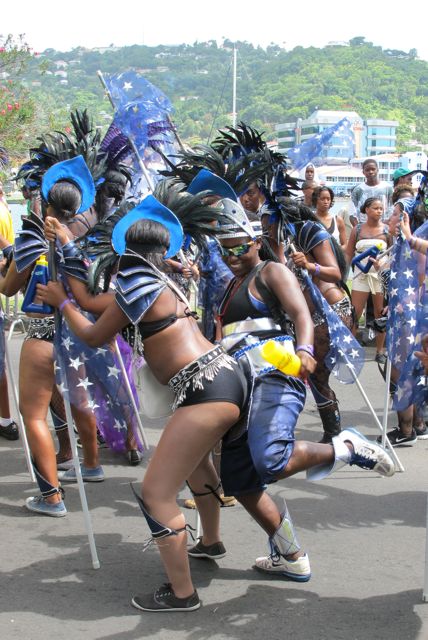
There were large gaps in the parade, sometimes of almost half an hour, while the group arriving had their costumes judged in front of the market. Lots of rum was being consumed and everyone was having good silly fun.
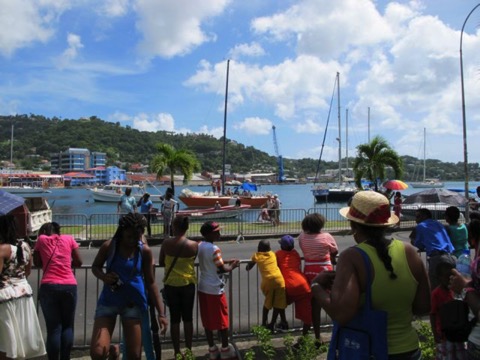
Here the parade spectators - both on the roadside and on boats out in the Castries anchorage - wait for the next band to arrive. The boats in the anchorage had a front row seat.
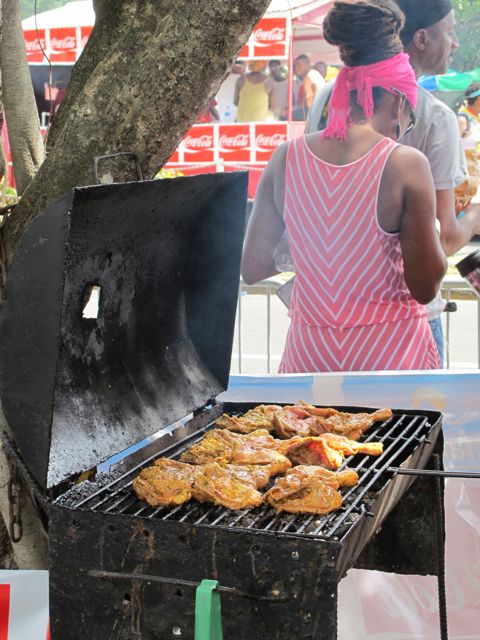
It was actually kind of fun because with the large gaps in the parade the spectators created an on-going street party to keep themselves amused. Families brought chairs and picnics plus there were lots of vendors selling interesting street food.
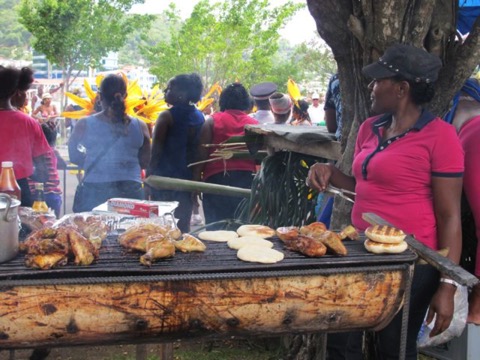
The parade actually became background to the local party. In the photo above, the women is BBQ’ing chicken and fish as well as grilling "bakes" a type of local bread that is baked, grilled, or fried. It’s a bit like an English muffin.
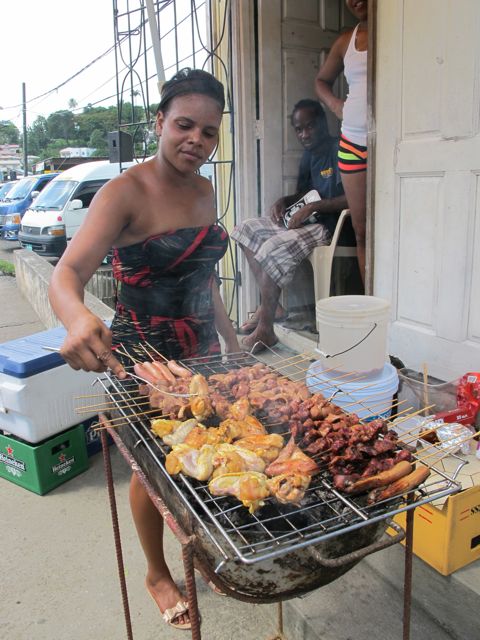
It seemed as if everyone was cooking. One of the popular local foods was grilled kidneys.
It was all really fun but by 3:00 p.m. our shady spot had become too sunny so we didn’t stay to the end (finish time was 7:00 p.m.!) but we had a great day, met a lot of great people, and got to experience a local event. Since it’s off-season this is not an event for tourists. It’s a day when the people of the island relax, kick pack, and just enjoy each others company. We felt privileged to be there and to be included.
Wishing you all a good week,
Sheryl and Paul Shard
Aboard SV Distant Shores II
Rodney Bay, St. Lucia
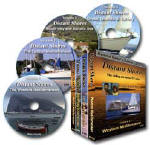
Click here to check out our DVDs for more cruising adventures and tips!
Distant Shores TV Show Facebook
Distant Shores TV Show Twitter
Martinique - After the Storm
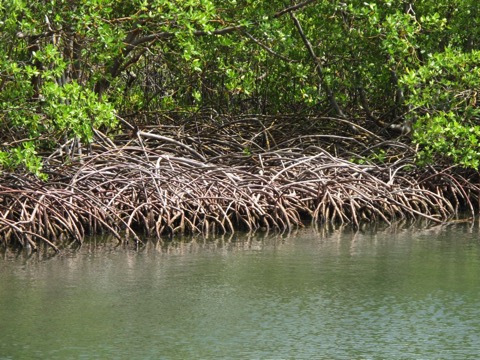
In my last newsletter we had been cruising on the south and east coasts of Martinique when we got word that Tropical Storm Chantal was headed in our direction. I referred you to several detailed reports that Paul wrote for his Tech Blog about how we prepared and fared, and this week he has posted another one for you, Tropical Storm Moves Off, about the aftermath of the storm which I also invite you to read.
Housekeeping after Tropical Storm Chantal
Tropical Storm Chantal blew through by lunchtime on July 9/13 and everyone anchored in the mangrove gave a sigh of relief and basically just rested for the afternoon (unless they had damage to contend with which fortunately we didn’t). You experience a big adrenaline crash after dealing with situations like this. Then we got really hungry!
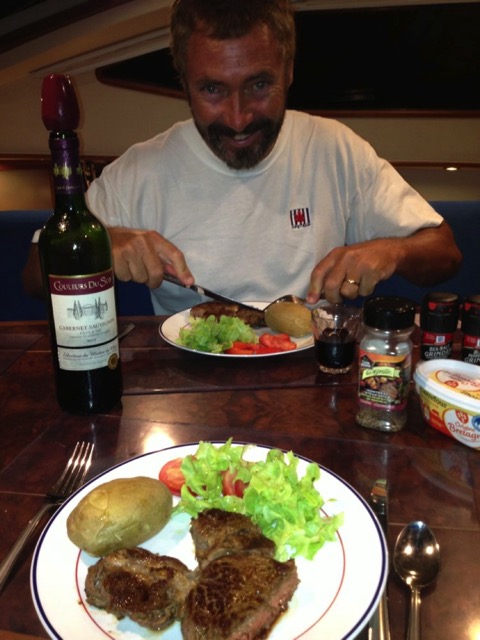
We felt like celebrating so Paul jumped in the dinghy and came back from town with steaks and a bottle of French wine. We slept well that night.
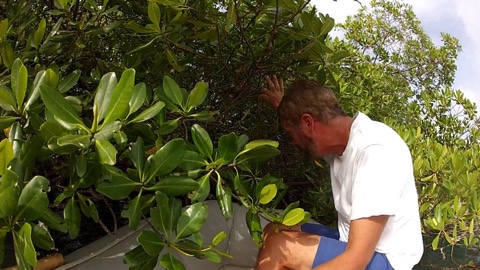
The next morning was spent untying the spiderweb of lines we had tied onto the mangrove roots.
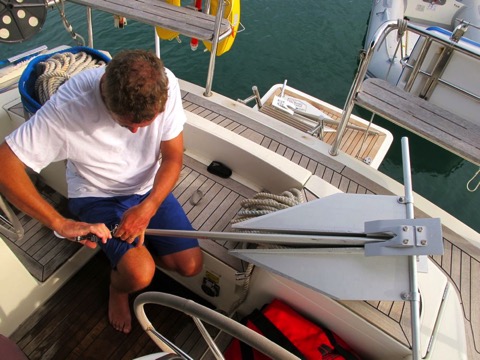
Then we had 3 anchors to raise - our 33kg Rocna anchor, a Fortress FX37 and Fortress FX23. They were really hard to get up (a good thing!) now that they were firmly wedged into the muddy sand bottom of the lagoon after taking the force of the 50-60 kt winds during the tropical storm.
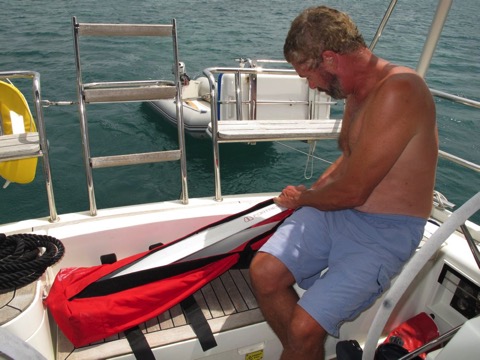
The Fortress anchors make excellent secondary anchors since they are aluminum so strong but lightweight and stow compactly in canvas bags which are easy to carry. The additional anchor rodes we keep coiled, clean and dry in canvas bags in a large sail/fender locker in the bow of the boat.
Health Issues
Now that the storm had passed and we had no damage or injuries, my main concern now was a health and safety issue. In the Caribbean islands you are vulnerable to catching dengue fever and dengue hemorrhagic fever (sometimes fatal) which are viral diseases transmitted by aedes aeypti, a domestic day-biting mosquito.
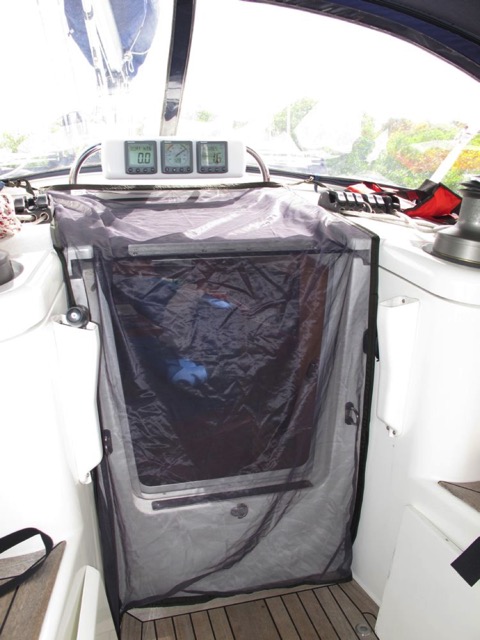
Mosquito net covering companionway hatch aboard Distant Shores II. Photo by Sheryl Shard
Despite precautions (tropical strength insect repellent with deet and screens/mosquito nets on the boat) we both had gotten a lot of mosquito bites crawling around the mangroves in the heat.
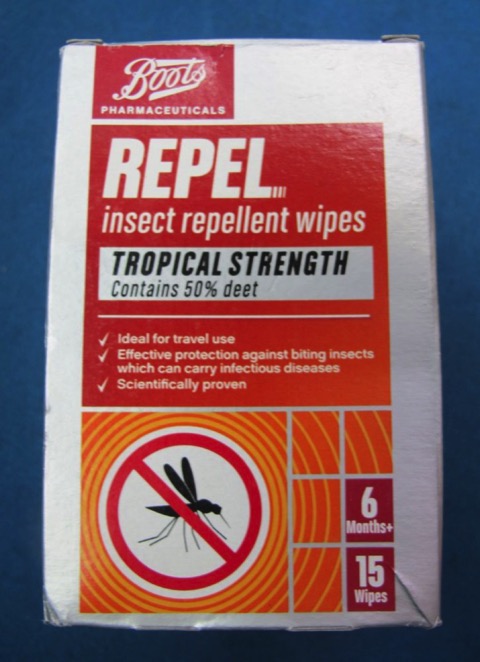
Be sure to keep a supply of tropical strength insect repellent containing deet on board when cruising in the Caribbean.
Symptoms of dengue fever occur after a 2-7 day incubation period and may include high fever, severe headache, joint and muscle pain. If you suffer from any of these symptoms a few days after getting bitten don't take aspirin (there is a risk of bleeding) and see a doctor immediately. So I was watching us both for symptoms and am happy to say that all is well!
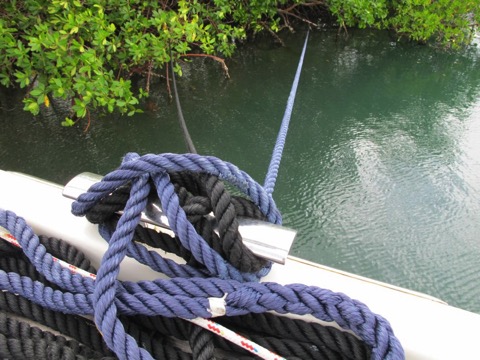
Another issue I hadn't even thought about was the risk of rats coming on board by crawling up the lines we had tied into the mangroves! Some local sailors ,who spend the summer working in Marin and leave their boat tied into the mangroves all the time, mentioned this to us later. Our friends cut out the bottom of large water bottles and thread them into the lines they tie ashore so that if rats do come up the lines they can't get past the scoop made by the water bottles. I've heard of people threading metal pie plates into their dock lines to create barriers to crawling creatures as well. You see fancy versions of this on cruise ships. I'm happy to report that we had no stow-aways after being in the mangroves! I'm glad I didn't know about this concern at the time. I'd have been awake all night!
Marin
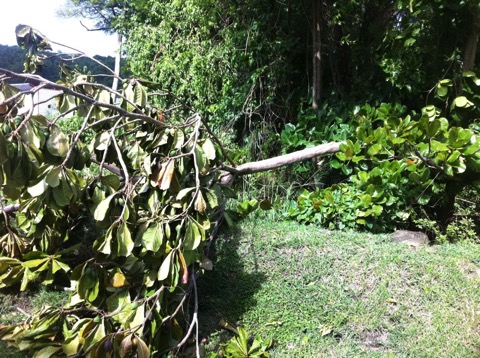
Once untied, we headed back out into the fresh air and open space of the main harbour of Marin. Boats here didn't fare as well during the storm since anchors broke loose and the drifting boats created a domino effect by bouncing into other boats and fouling their anchors, setting them adrift as well. Lots of trees were down ashore too.
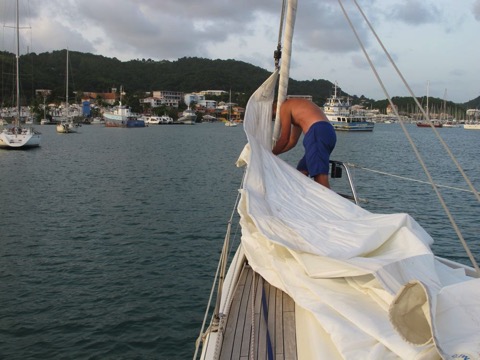
Order had now been restored and finding a clear spot in the anchorage we started putting the sails back up and preparing to head south to St. Lucia.
Communications
In Marin there is bay-wide high speed internet available from the Marin Marina. You buy vouchers for several hours, days or months from the main office (they speak English) so we were well connected in Marin. We could do uploads to our website and make skype phone calls without difficulty. There are also lots of internet cafes around town.
Provisioning
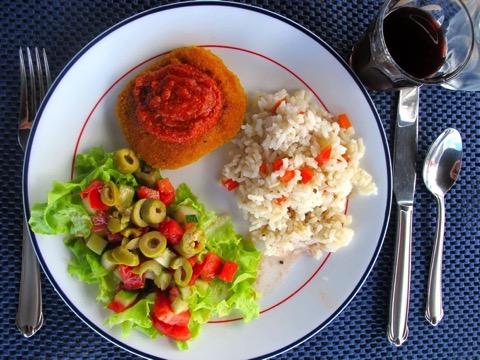
Before leaving Marin I wanted to do some more stocking up. Martinque is a French island so was a good place to add to our stock of good French wine, cheeses, and specialty European products that I had discovered when we cruised through the French canals last summer.
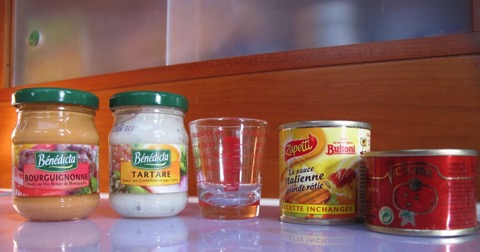
An example was little tiny jars or cans of delicious sauces perfect for 1 meal for 2 people on a sail boat. These are not exactly environmental but store well and can make a meal at sea on a passage a real treat and you don't have to deal with ½ a can of tomato sauce in a rolling boat. (I do stock large cans as well and store unused portions in Lock 'n Lock™ plastic containers when we're at anchor or just coastal cruising.)
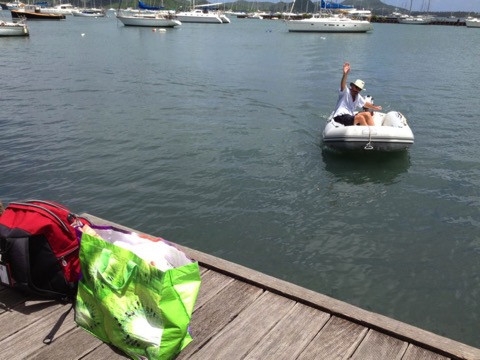
There are several good grocery stores in Marin with nearby dinghy docks – Carrefoure, and 2 discount grocery stores called Leader Price and Dia which are good for stocking up on beverages, snacks and dry goods. Their meat and produce were pretty good too but I found Carrefoure to be the best since it had more selection.
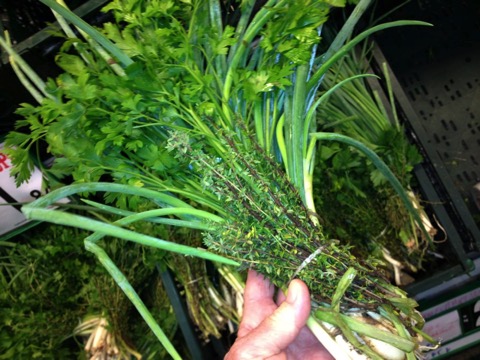
In the grocery stores in Martinique you can buy herb bundles (bouquet garni). Here is a bundle of thyme, parsley and green onions.
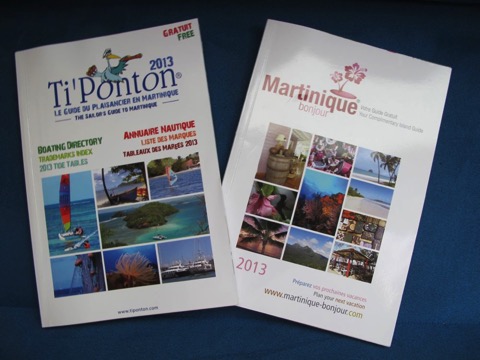
Marin is a huge base for many yacht charter companies so there are all kinds of specialty food stores and provisioning services here as well. All are listed in the free guide “Ti'Ponton: The Sailor's Guide to Martinque” as well as all yacht services and chandleries. You can pick it up many places in town including the marina. It is written in English and French. Another useful free guide is “Martinique Bonjour” with tourist information. The section on Martinique in Chris Doyle's, Sailors Guide to the Windward Islands, the cruising guide we have been using, also lists provisioning options plus yacht services and chandleries. Chris also gives sketch charts showing the dinghy docks closest these facilities.
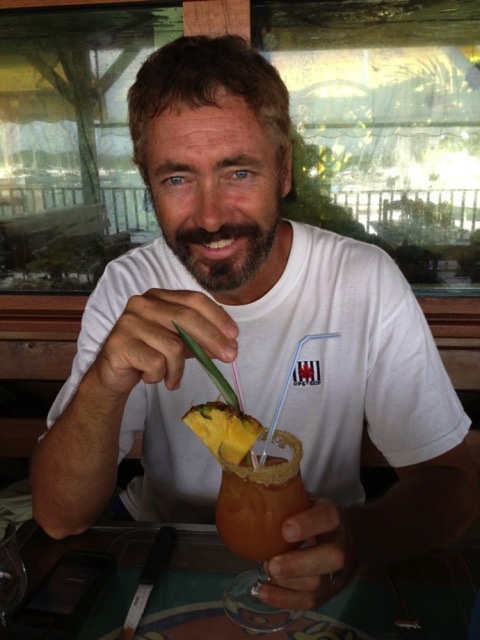
Once our chores were done and provisions stored we decided once again to celebrate our safe handling of Tropical Storm Chantal this time with lunch ashore at Mango Bay Restaurant and Bar, a waterfront place local friends had recommended.
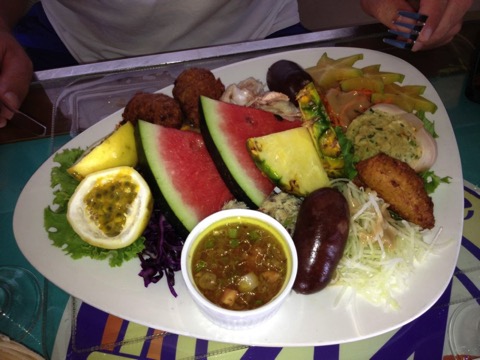
Fruity cocktails and a sampler plate of local goodies was the order of the day.
Clearing Out from Martinique
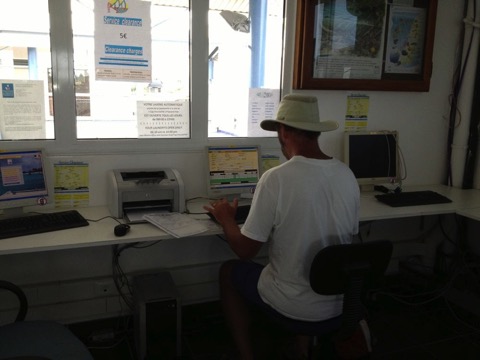
Next we went to clear out from Martinique so that we could leave early the next morning on July 12 for St. Lucia. This was done at a do-it-yourself Customs and Immigrations computer located in the marina office in Marin. There is a 5 euro administrative charge. The marina receptionist checks your papers and stamps your printed clearance papers once you have filled in the details. Although convenient, the process can be slightly challenging since form is in French and you are working with an AZERTY keyboard used on computers in French territories so letters are in different places on the keyboard. For information on Customs and Immigration for Martinique click here.
We had arrived in Martinique on June 16th in St. Pierre. What a wonderful, and rather exciting, 3 ½ week cruise around this French island in the Caribbean!
More News
DS episodes - Atlantic Rally for Cruisers (ARC)
We've just completed post-production on 2 new episodes of Distant Shores about cruising in the Canary Islands and our transatlantic passage as participants in the Atlantic Rally for Cruisers (ARC). These episodes are the first 2 of 3 episodes covering the ARC, all part of Season 9. The “Distant Shores Season 9 DVD - France, Morocco and the Atlantic Rally for Cruisers” will be available in August 2013. However individual episodes are available now online as HD digital downloads on Vimeo.
Port Credit In-Water Boat Show August 23-25, 2013
We'll be flying to Canada at the end of August to conduct seminars about “A Summer Cruise through the French Canals” at the Port Credit In-water Boat Show, Mississauga (near Toronto), Canada.
Friday August 23 at 1:30 - 2:30 p.m.
Saturday August 24 at 3:00 – 4:00 p.m.
Sunday August 25 at 3:00 – 4:00 p.m.
Information and directions here
That's it for this week...
Wishing you Fair Winds,
Sheryl and Paul
Aboard SY Distant Shores II
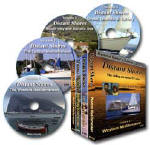
Click here to check out our DVDs for more cruising adventures and tips!
Distant Shores TV Show Facebook
Distant Shores TV Show Twitter
Martinique - South and East Coasts
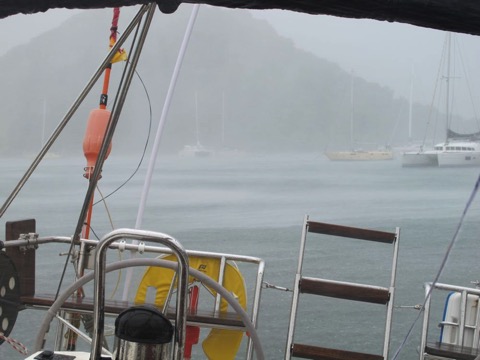
We've had a rather exciting time during the last few days in Martinique as Tropical Storm Chantal blew through the islands on Tuesday! We have just untangled the boat from the mangroves where we had tied ourselves onto the mangrove roots in a spiderweb of lines and anchors to protect the boat from the 50+ kn winds. Paul has written a few detailed reports in his Tech Blog about how we set up the boat for the storm and how we fared as Chantal vented her fury, so I refer you to those for the Tropical Storm update:
Tropical Storm Arrives
Securing in a Mangrove
Tropical Storm Chantal is coming
My newsletter is about our cruising adventures preceding the storm as we sailed to some lovely places on the the south and east coasts of Martinique.
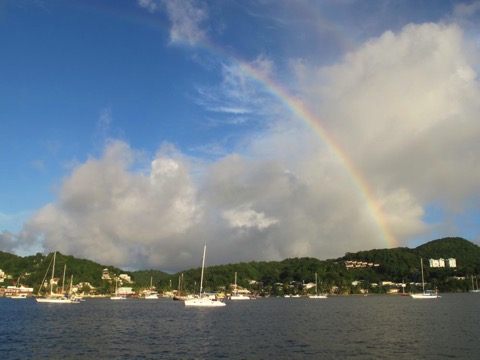
Anchored off the seaside village of Ste. Anne. Photo by Sheryl Shard
Ste. Anne & Marin
After sailing down the west coast of Martinique (see previous newsletter) we arrived at the south coast at the seaside town of Ste. Anne.
There is an enormous anchorage here which is the outer harbour of Marin, the yachting capital of the Eastern Caribbean. Every kind of yachting facility and service can be found in Marin and its inner harbour, Cul de Sac Marin, is also huge with over 1,000 boats there.
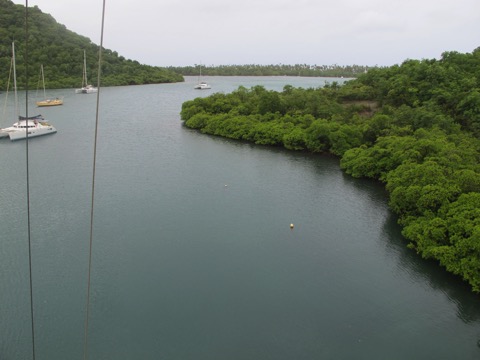
Better yet, it's a huge hurricane hole with several mangrove creeks running off it so for summer cruising during Hurricane Season it's a nice place to be close to.
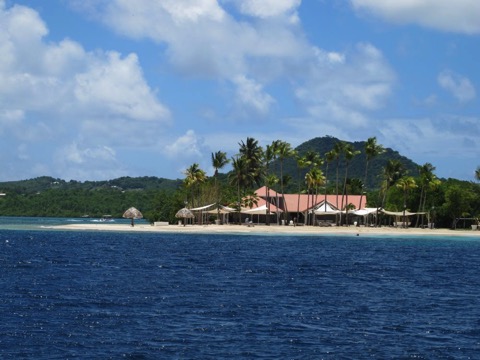
Outside in the anchorage off Ste. Anne, which is a quiet little town built around the village church, there are many lovely white sand beaches and the atmosphere is relaxed yet festive with numerous beach bars.
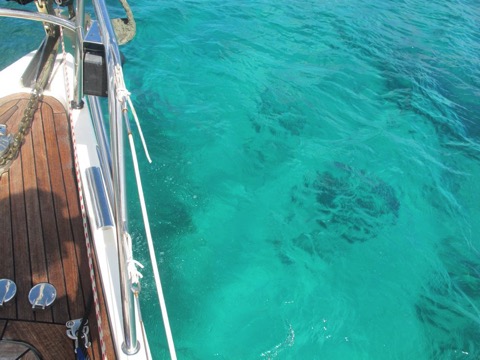
Ste. Anne has lovely clear water for swimming and snorkelling.
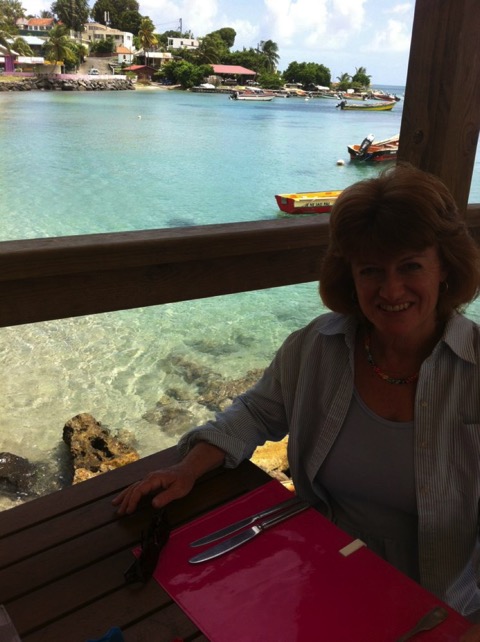
In Ste. Anne there are a couple of small grocery stores, a vegetable and fish market, a post office and bank that both have ATM's, several internet cafes that frequently aren't working, a couple of really good dinghy docks with free garbage disposal at the main pier, and many boutiques and souvenir shops for fun shopping.
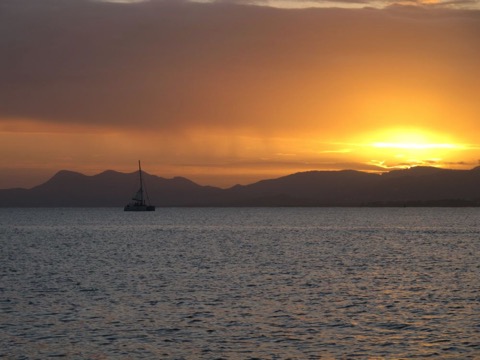
We have been spent many nice days at anchor here while we work on our latest assignments taking breaks to go snorkelling and enjoying beautiful sunsets in the evening.
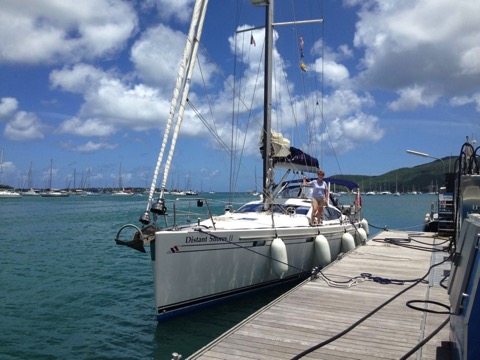
When we need more supplies or a visit to a chandlery we just raise anchor and in 15 minutes are in Marin where we can fill our water tanks at the fuel dock at the huge marina there and anchor while we run to several good grocery stores, phone centres, etc. When our chores are done it's an easy run back to peaceful Ste. Anne.
When we left the island of St. Maaretn/St Martin in June we felt as if it was the end of the season with yachts migrating back to Europe, north to the US and Canada, and south to Grenada and Trinidad for Hurricane Season. But here in Martinique the season is on-going. Marin has numerous active charter fleets and lots of places around the island to cruise to, local boating families are now on summer holidays, and the French live-aboard cruisers are basing themselves here as they do annual maintenance or get seasonal work to improve their cruising funds. (I will write more about Working While Cruising in a future Life On Board article.)
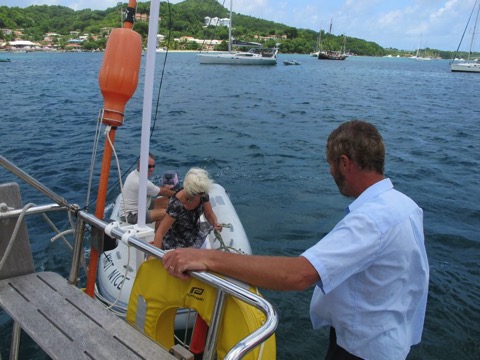
When we arrived in Ste. Anne on June 20th we were greeted by a group of French sailors that we had shared a dock with in Rabat, Morocco, 6 months previously.
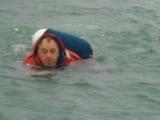
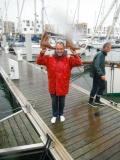
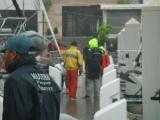
Jean-Noel saves the day in Rabat, Morocco, by swimming lines across the harbour to the opposite pontoon. This is where we first met and are now having a reunion in Martinique on the other side of the Atlantic Ocean - and dealing with another storm together!
We had ridden out a bad storm with them in Rabat (related to weather weirdness following Hurricane Sandy) where Jean-Noel of Julie 1re swam across the harbour to the opposite pontoon to secure our boats from the strong crosswinds that had broken the pontoon in several places.
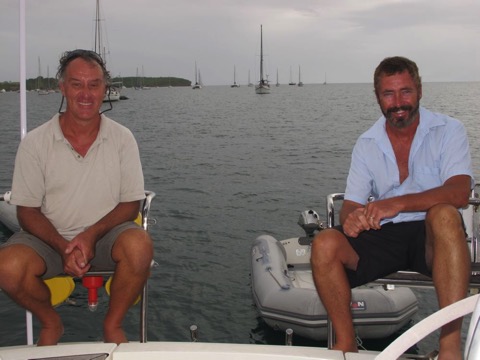
Our French friends had been sailing together in a casual flotilla of 3 or 4 boats and, while we sailed west from Morocco to the Canary Islands and across to the Caribbean, their route to the Caribbean had been to continue south visiting more ports along the west coast of Morocco before heading offshore to the Cape Verde Islands, then Senegal, then French Guyana from where they jumped off for the islands of the Caribbean. This seems to be the preferred route of French-speaking sailors just as our route is preferred transatlantic route for most English-speaking sailors (with some overlaps in the Cape Verde Islands for example.) Language and cultural familiarity seem to be the determining factors in these choices as well as wind and currents.
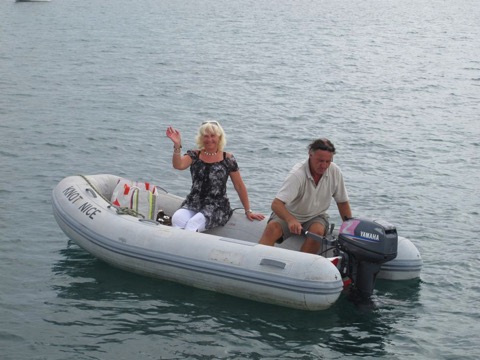
Babette and Jean- Noel, French friends aboard SY Julie 1re.
Our friends were making Martinique their base while they worked for the season. Babette, a nurse, had gotten contract work for several months filling in for women on maternity leave, etc. Her husband, Jean-Noel, an engineer, was working at the shipyard in Marin as well as doing yacht deliveries. And Virginie of SY Marjalou was working as a waitress at a local restaurant while her husband David made repairs and modifications to their boat, their fulltime home, for the coming winter sailing season. All were enjoying the break and the sociability of their new jobs in a new community. Working is fun if it is part of an adventure!
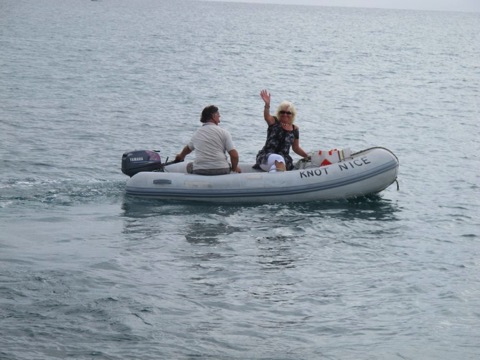
Many of our cruising friends with shallow-draft yachts had waxed poetic about cruising the east coast of Martinique that is wild and natural and full of quiet coves and bays that you often have to yourself. But the east coast is the windward side of the island which is open to the ocean swells of the Atlantic. This means you have to wait for calm conditions to sail safely into these anchorages since you enter with seas behind you. Many of them have bars at the entrance which can be dangerous in large seas and because of this you must cruise here fully provisioned with food and water in case the weather turns suddenly and you get trapped here for a few days.
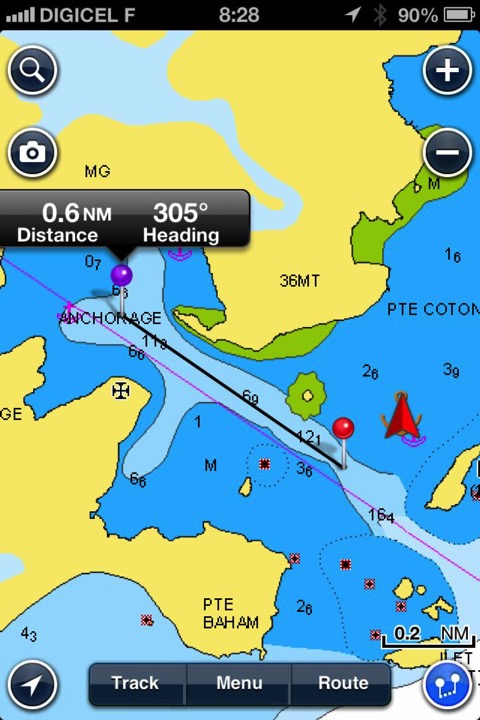
Courtesy Navionics Mobile
So last Saturday. July 6, we finally got the conditions we were looking for and raised anchor from Ste Anne to spend the weekend in quiet solitude – or so we thought! It was an absolutely beautiful blue-sky day and as we headed around Point Dunkerque to sail past the gorgeous stretches of white sand beaches on the south coast there was a parade of charter yachts, speed boats and jet skies headed the same way! Uh oh. Was everyone taking advantage of the weather and heading for the east coast for the weekend too?!
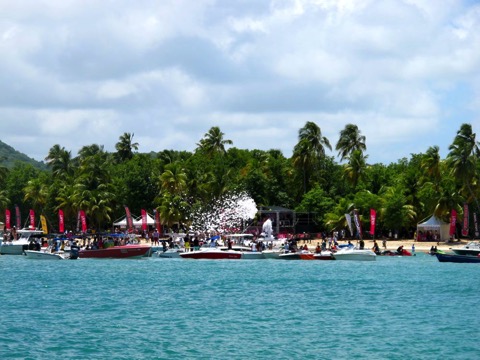
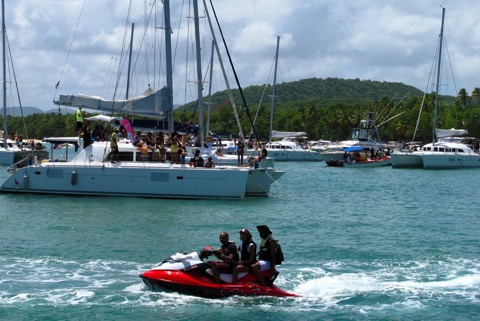
However, when we reached Anse des Salines we saw that they all stopped there since there was a huge beach festival going on. The largest raft-up of small power boats we'd every seen, probably more than 50 boats (later we saw that stern moorings had been laid out to make this safe) was strung out in front of the beach with probably another 50 or so yachts anchored further out. Music was blaring, people were dancing on the beach, bubble machines were filling the air with sparkling bubbles and foam, and lots of Martinique rum was being consumed – at 1030 in the morning! What was up? We had to stop and get the story. Turns out it was Mercury Day, the island's biggest beach party sponsored by the company Mercury that manufactures outboard motors.
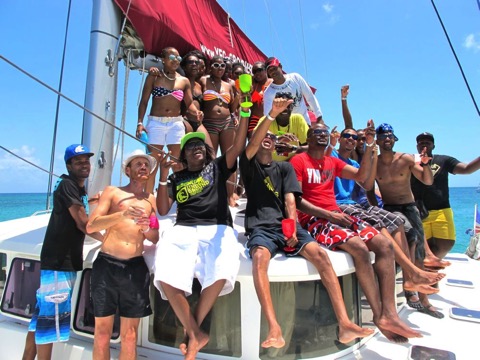
After partying for a couple of hours we said goodbye to new friends and continued on around the corner to the east coast.
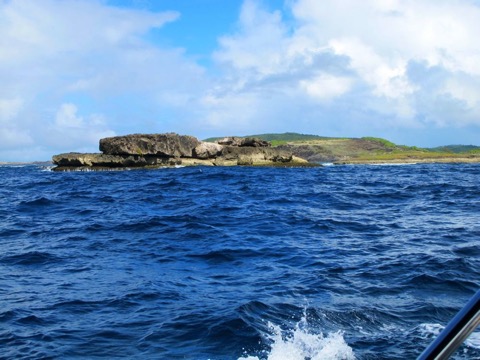
What a change in scenery! It was rough and wild exposed to the Atlantic swells.
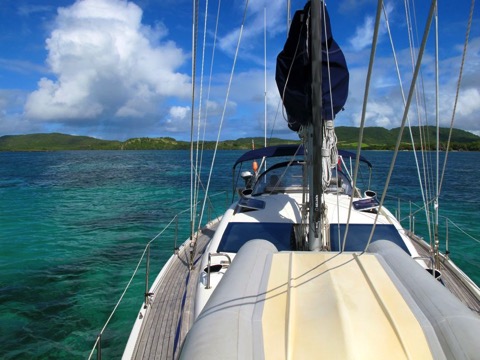
But today it was lovely and we had no problem navigating into Baie des Anglais.
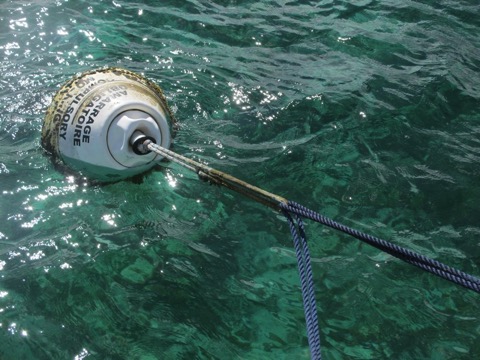
However when we got into the anchorage we discovered it was now a nature reserve and anchoring no longer allowed in certain areas. But moorings had been laid and we joined 2 catamarans there for the night. We always dive on moorings to make sure they are safe and these looked well maintained.
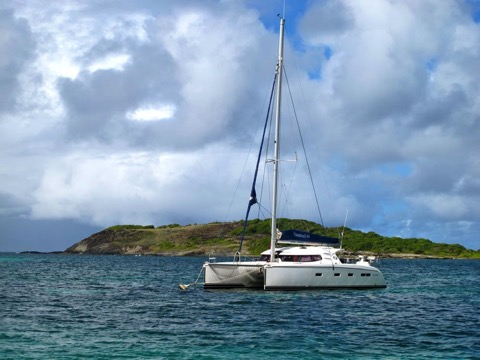
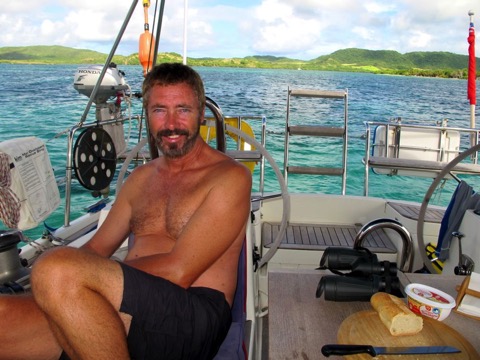
We had a very pleasant weekend there and the Mercury Day party provided quite a contrast to the peacefulness of Baie des Anglais.
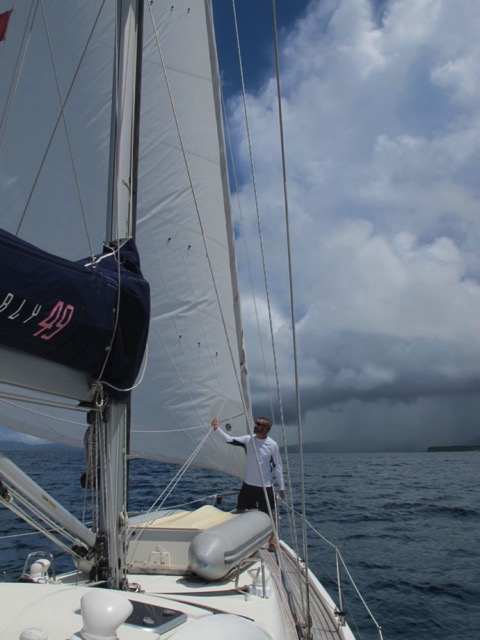
But then we got word that Tropical Storm Chantal was on the way ETA Tuesday so we headed back to the safety of Marin on Sunday afternoon.
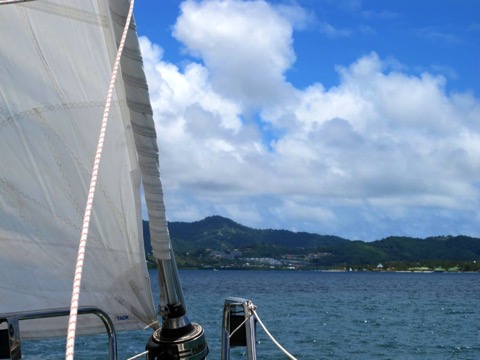
The weather was still great and we had a lovely downwind sail back to Marin past the south coast beaches and right into the harbour.
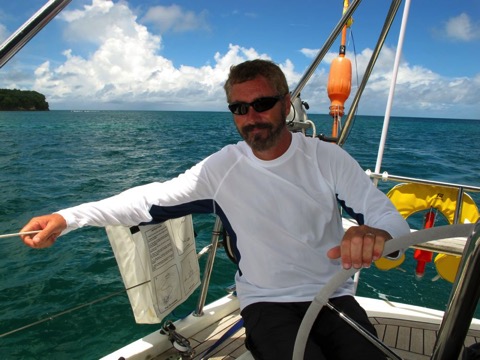
What a weekend!
Warm regards,
Sheryl and Paul
Aboard SV Distant Shores II
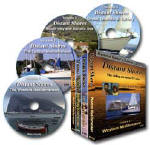
Click here to check out our DVDs for more cruising adventures and tips!
Distant Shores TV Show Facebook
Distant Shores TV Show Twitter
10 Tips for Cooking at Sea
By Sheryl Shard, Copyright 2015. All rights reserved.
Up until now most of my newsletters have focused on our travels with the aim of sharing our experiences to help you plan your own adventures in the many different destinations we have visited during 23 years of international cruising. But one of the most popular boat show seminars we conduct is "Outfitting and Provisioning for Cruising", so I thought for a change that I’d write about something related to this and Life On Board. Today’s topic is Cooking at Sea.
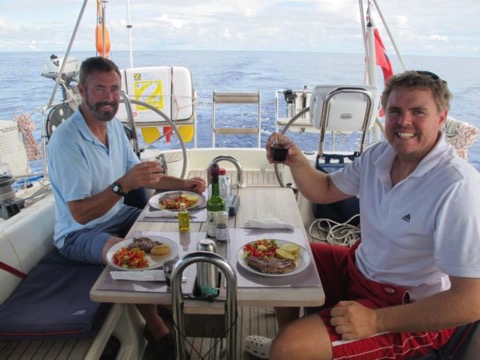
A calm day on the Atlantic with Paul and friend, Matt Heron. After days of rough weather and strenuous watch-keeping during the 2012 Atlantic Rally for Cruising (ARC) it was nice to have a sit-down meal together in the cockpit . Photo by Sheryl Shard
One of the things Paul and I love about cruising is that we have more time to prepare and enjoy delicious meals than when we’re rushing around during our busy lives ashore. We love to shop in foreign markets, experiment with new foods, and entertain friends aboard our Southerly 49 sailboat, Distant Shores II.
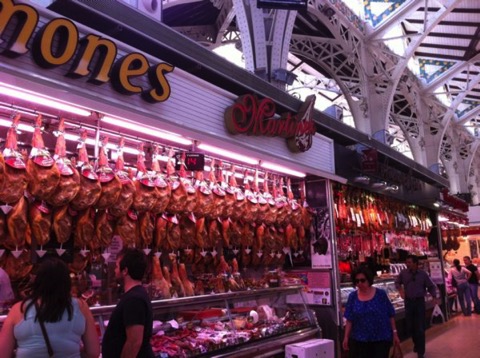
Cured ham at the city market in Valencia, Spain. Photo by Paul Shard.
When on passages, however, food preparation takes on a different meaning and significance. Good nutritious meals are important to maintaining our health and energy at sea, not to mention our sense of well-being when spending weeks in isolation on an ocean crossing. But the physical challenges of passage-making sometimes make meal preparation an energy-depleting exercise. In rough weather it can be downright dangerous.
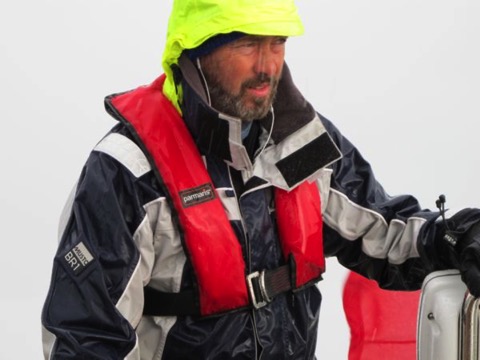
Paul at the helm after wet crossing of the North Sea from Shetland to Norway. Photo by Sheryl Shard
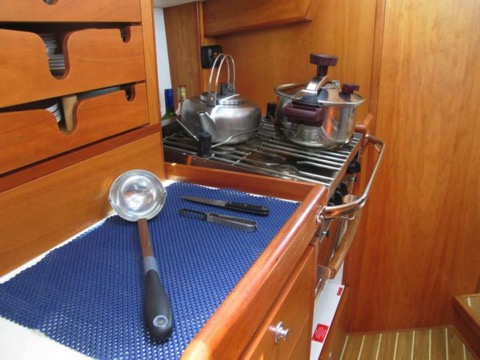
The galley on our Southerly 49 sailboat, Distant Shores II, set up for sea. Photo by Sheryl Shard.
Top 10 tips for Cooking at Sea
1. Prepare meals ahead of time: Before leaving on a passage, we try to prepare as many meals as possible before we leave the dock. It takes a few days for your body to adjust to around-the-clock watch routines so make everything easy. Like many long-distance sailors, Paul is especially susceptible to seasickness during the first 3 days of a passage so we plan light, easily digestible foods.
2. Store everything you need for meal preparation near the galley: If everything is close at hand, you will do a better job of preparing good meals since it will be less tiring than running here and there digging deep in lockers on a pitching boat. You will also be less likely to fall or injure yourself.
3. Know what you’ve got and where it is: Don’t waste your time and energy digging through lockers unnecessarily. Keep a good inventory list so you know exactly what you’ve got and where it is.
4. Top everything up before you leave the dock: Running out of dish detergent, having to change a toilet paper roll or finding the flour canister empty can bring me to tears if a storm is raging. Topping everything up before you leave the dock reduces effort and irritation.
5. Clean the boat like crazy: Odours can do you in if you’re on the verge of “mal de mar”. Make sure there are no sour sponges, dirty dish towels, gruesome laundry or icebox gremlins waiting to turn your stomach. Do your best to clean up spills so you don’t slip and fall. Check your fresh produce supply regularly so you’re not caught out by a rotting potato or mildewed melon.
6. Add safety features and use them: The safer you feel in the galley, the more pleasant your galley tasks will be. There should be lots of handholds in the galley and a galley strap at the stove so when the going gets rough the chef doesn’t land in the soup. We have pot clamps on our gimballed propane stove to keep things where they should be. We have a stainless steel safety bar in front of the stove (between the cook and “the cooker”) for added protection from burns. At sea I also cover our countertops with non-skid mats to keep bowls and utensils from flying around.
7. Keep it simple: When the weather is rough, it’s really better to stay out of the galley, if possible. Design meals to be quick and easy. We snack a lot on passages, especially in foul weather, often having several small meals rather than three major productions per day. It’s easier on the digestion and easier on the cook.
8. Come up for air: Stick your head out the companionway occasionally if you’re going to be in the galley for a while. It clears your head and makes you feel better.
9. Make clean-up easy: Design your meals so clean-up isn’t a major chore. One-pot dinners served on paper plates makes life easier for everyone when the going gets rough.
10. Make time to sit together and eat: Being only 2 people on a yacht most times while underway can make it tempting to alternate long watches and pass each other like ships in the night. Help your relationship and avoid loneliness by sitting and eating together. Even if it is only for 10 minutes, take the time to catch up and ask each other how you're feeling.
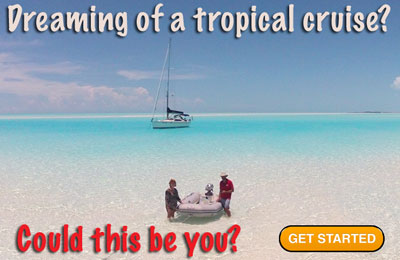
Join our email list and get hints, technical articles and tips plus videos to help you achieve your cruising dreams.
- FREE 1/2 hour video on cruising the Exuma Islands in the Bahamas
- Technical Blog shows you how to deal with issues facing the cruising sailor
- Destination information from some of the world's best cruising areas
- Special discounts and promotions
Click Here to Sign up
You Might also like the following...
Tropical Storm Chantal Arrives
Making Money While Cruising
Maintaining a Homebase
About the Southerly 49
Top 10 Canal Journeys
Martinique
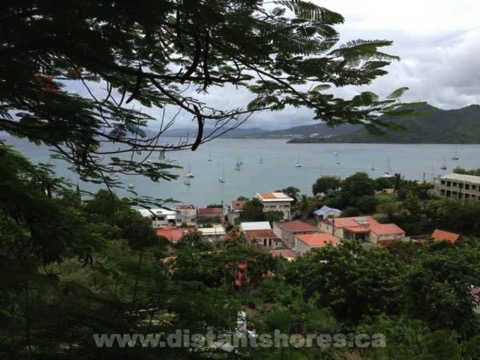
Town of Ste. Anne on the south coast of Martinique
Greetings from the French island of Martinique! July 1st was our national day so yesterday Paul and I celebrated Canada Day anchored off the quaint town of Ste. Anne on the south coast.
We arrived in Martinique, the largest of the Windward Islands, after a great week exploring Dominica, the island to the north (see previous newsletter) and the most southern Caribbean island in the Leeward Islands group.
Leaving Dominica
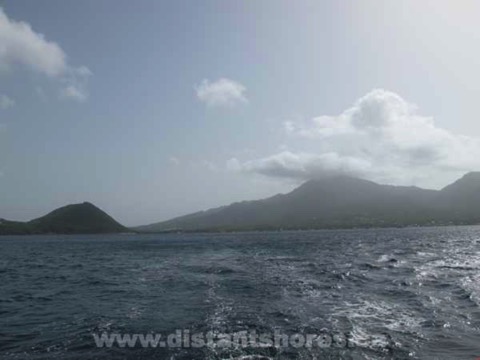
On Sunday June 16 we said goodbye to Dominica and, leaving Portsmouth at 0830, we motored in a southwesterly direction in the lee of the island.
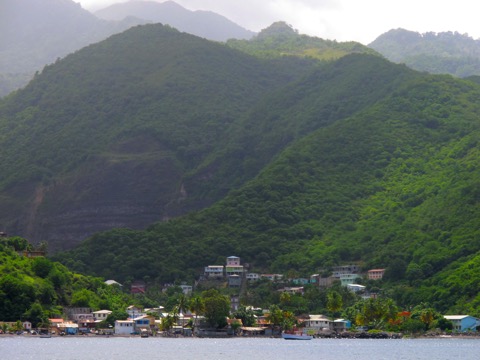
It was a pleasant morning since we kept in fairly close to shore to enjoy the view of the picturesque fishing villages along the dramatic mountainous coast. Our destination was the town of St. Pierre, about 55 nm onwards which is a port of entry on the northwest coast of Martinique. (Note: We didn't need to clear-out when we left Dominica because when you clear-in you are automatically cleared-out two weeks later. You only have to visit Customs and Immigration to clear-out if you stay longer than 2 weeks. Very convenient and welcoming!)
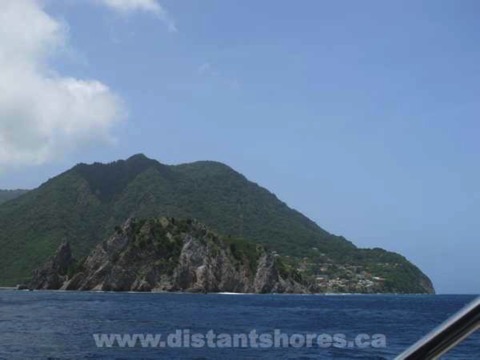
Four hours out from Portsmouth at 1230, we arrived at Scott's Head, a rocky outcrop at the southwest corner of Dominica, and headed out into open water sailing close-hauled for 20 nm across the Martinque Channel. There is an “acceleration zone” here where the wind speed is accelerated as it whirl around the mountainous end of the island. A similar thing happens with the currents. The seas can look rather exciting at this point but smooth out once you get away from land. We had headwinds of 20 knots with gusts to 30 knots, borderline conditions for making this a comfortable passage, and were prepared to turn back and stay the night anchored off Roseau, the capital city of Dominica, if the seas were too nasty. We plowed on but Distant Shores II, our Southerly 49 sailboat, sliced through the seas and we made good progress.
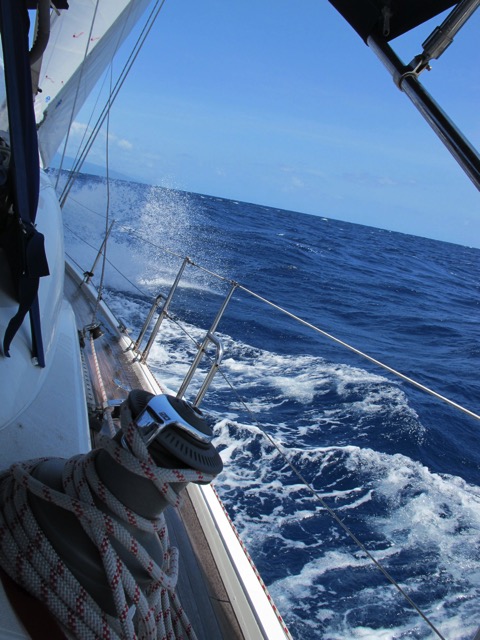
The Martinique Channel divides the Leeward Islands of the Caribbean from the Windward Islands (although some sources include Guadeloupe and Dominica as part of the Windward Islands and make the dividing line further north).
Why are they called the Leeward and Windward Islands? In days of old when sailing ships were the commercial vessels of the time, ships sailing from Europe to the New World would follow the transatlantic currents and prevailing trade winds that blow east to west for the fastest voyage possible. This route would bring ships to roughly the dividing line between the Windward and Leeward Islands so named since the islands to the north were more to leeward for the sailing ships and the group to the south were to windward.
Our main resource for this part of our voyage south through the Caribbean is Chris Doyle's cruising guide, the 2013-2014 Sailors Guide to Windward Islands, and Chris defines the Windward Islands as Martinique, St. Lucia, St. Vincent and the Grenadines, and Grenada.
St. Pierre
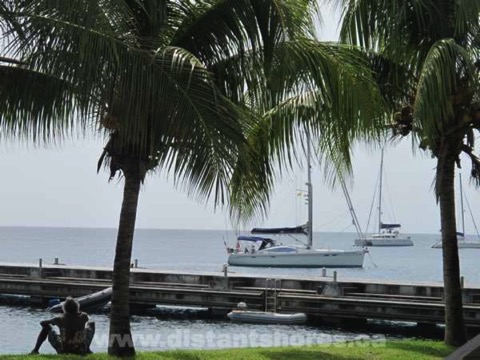
After a good beat across the Martinique Channel we arrived at the picturesque town of St. Pierre at the foot of the Mt. Pelée volcano at around 5:00 p.m. - just in time for sundowners in the cockpit.
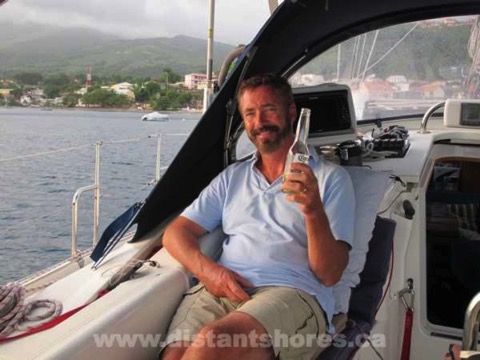
We anchored off the town quay leaving room for the ferry that comes to the quay. There is a shelf with comfortable depths of 3-8 m (10-25 feet) just off the town and then it drops off quickly to very deep water, so you need to be sure to get your anchor down securely on this shallow shelf. We anchored in 4 m (13 feet) with good holding. This is a good overnight anchorage except in heavy northerly swells.
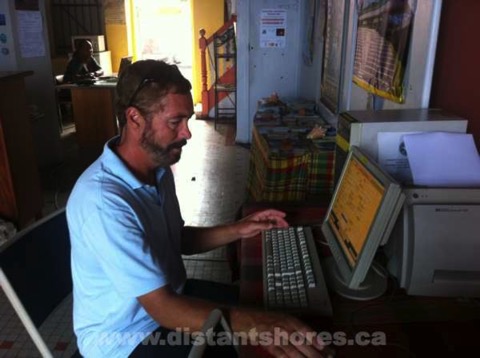
Clearing-in is done at the tourist office at the waterfront which is open Monday-Friday 9 a.m. to 2 p.m. so we waited and didn't go ashore until the next morning. The process is very easy and casual. There is a designated computer at the Tourist Office for Customs and Immigration and you fill in the documents yourself which require information from your ship's papers and crew passports. We brought all these documents with us since it's customary to show them to some kind of official but here it's the tourist office receptionist who welcomes you and she said she didn't need to see them. There were no administrative charges since it was a government office. We had the same experience in St. Martin and Guadeloupe, the other French Islands we've visited. In Deshaies in Guadeloupe, the DIY Customs and Immigration computer is in one of the local bars, so you can have a drink while you fill out the forms!
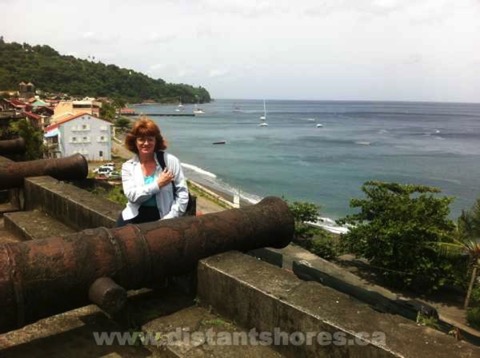
The history of St. Pierre is quite fascinating. In the late 1800's and early 1900's it was known as the “Paris of the Caribbean”. With a population of 30,000 people it was a prosperous town due to the success of the plantations surrounding St. Pierre. The shipments of rum, coffee, sugar and cocoa made several of the plantation owners multimillionaires. St. Pierre was the commercial, social and cultural centre of Martinique.
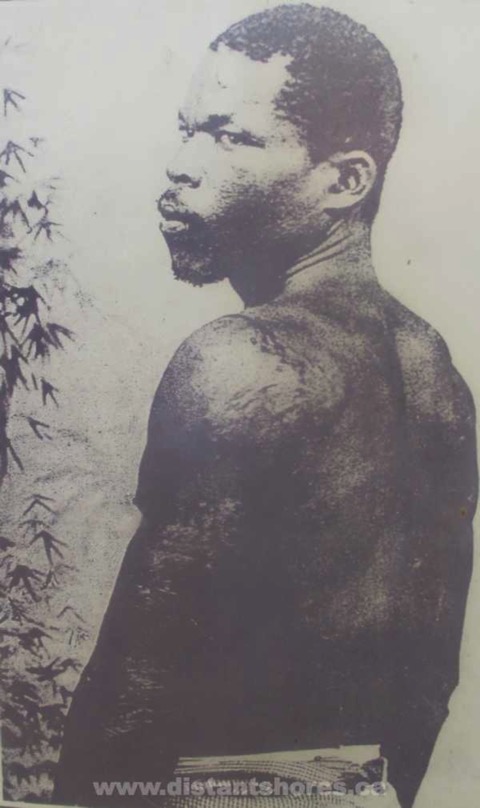
Cyparis, one of two survivors of the volcanic eruption of May 8 1902. He was later hired by the Barnum & Bailey circus.
But this ended abruptly when on Ascension Day, the 8th of May 1902, the Mt. Pelée erupted and a fireball with the explosive power greater than an atomic bomb blasted the town killing all but 2 people. One was a prisoner named Cyparis, imprisoned for murder in a stone cell. The thickness of the walls saved him but he was still badly burned.
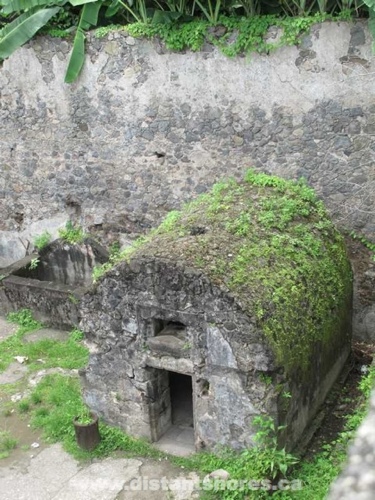
We visited the museum on the waterfront that tells the story in French and English, then visited the cell that Cyparis survived in for 3 days until he was found by rescuers.
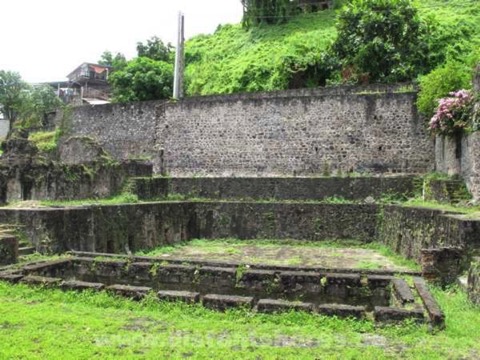
We also visited the remains of the once beautiful old theatre. Today the population of St. Pierre is about 5,000.
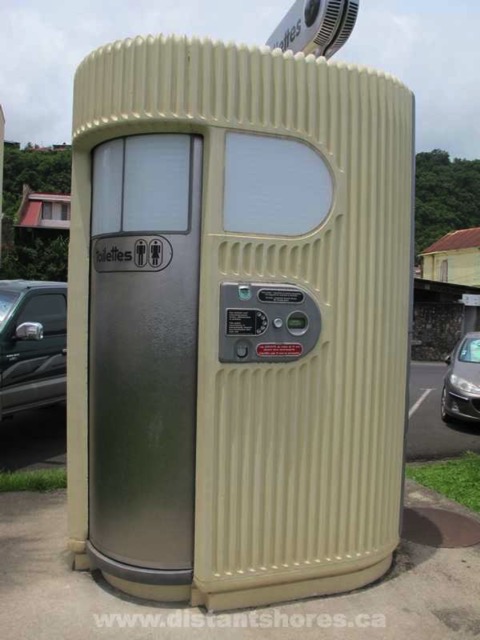
In French territories there are clean public washrooms everywhere. Here’s an example of coin-operated curbside toilettes.
Menu du Jour
You may recall that at this time last summer we were taking Distant Shores II through the canals of France. One of the things we enjoyed in France was that lunchtime is a sacred hour. Everything shuts down promptly for 1-2 hours at mid-day and people sit down to a proper relaxing meal. During the work week most restaurants offer a Menu du Jour (Menu of the Day) which has a starter, a main course, a dessert, and a glass of wine. Sometimes a cheese plate is included and tea or coffee. The Menu du Jour is excellent value so we were happy to discover that the same tradition is honoured in the French islands of the Caribbean.
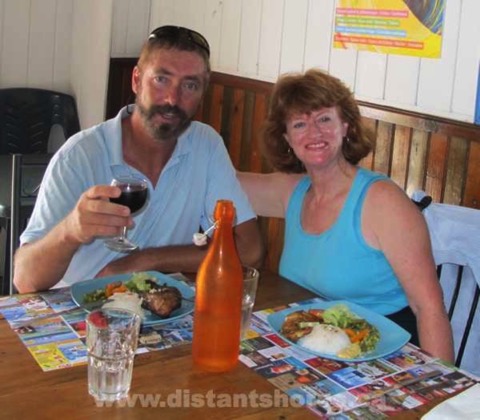
In St Pierre we enjoyed a delicious mid-day meal at a little restaurant close to the waterfront called Le Switch. It was quite plain looking from the street but it was full of working people, not just tourists, always a good sign. We were welcomed in warmly by the women running the restaurant and everyone sitting at tables gave us a friendly “bonjour” (good day) then helped explain in bits of French and English what the Menu du Jour was.
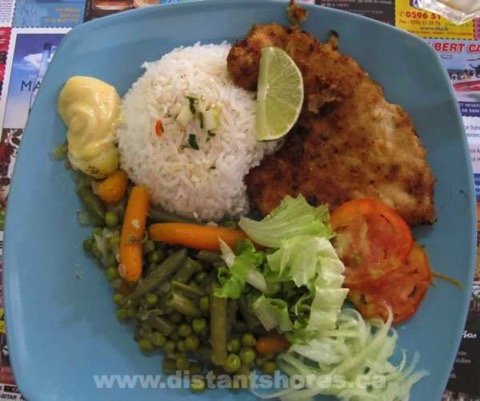
We had a choice of BBQ chicken or fresh-caught fish with sides, salad, dessert and a glass of wine. The cost of each 3 course meal was 8 euros (around $10 US), wine was extra, and we had fun watching and talking to the local people there. Everyone was laughing and joking and talking to one another the entire time. Such a great atmosphere! And the food was really good too. Cooked with love.
Wi-fi Woes
Internet access is pretty important to the cruising lifestyle these days, at least to those of us that communicate by e-mail and skype, do research and check weather forecasts online. Most cruisers maintain a blog, website and/or social media sites to keep folks at home updated on their whereabouts and adventures too. So our afternoon plan was to buy a voucher from the restaurant La Vague on the waterfront that advertised in our cruising guide that they offered an internet service for sailors at anchor. We'd seen the signal and should have been able to sign up for it on the boat via PayPal but the link wasn't working. The news wasn't good when we went in to the restaurant. The system was down and the person that usually looked after it was on vacation. There were no other internet cafes in town that we could find. In Dominica, we were able to get really good internet service on the boat through a service called Hot Hot Hot Spot which also covered islands further south. There were several other options too. We were going to the capital city of Fort-de-France the next day so decided that one day away from internet wouldn't be too bad.
Fort de France
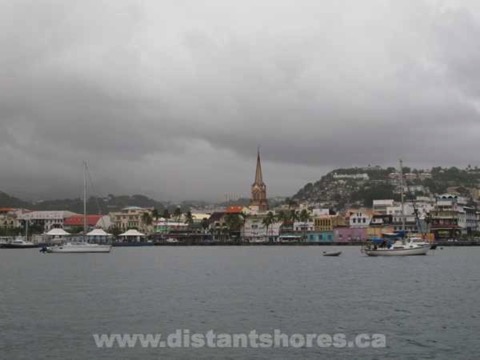
Tuesday June 18 we raised anchor and motored along the windless lee of the island from St Pierre to Fort de France where we anchored off the newly renovated waterfront of the city with a nice park and promenade and welcoming dinghy dock. In the anchorage were other boats we had seen up-island heading south like us. The southbound migration for Hurricane Season was underway.
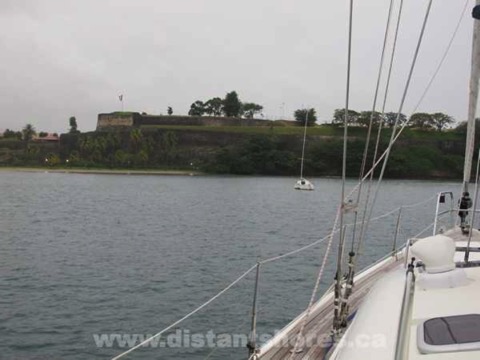
At our bow was Fort St Louis. Off our stern was a very modern skyscraper! It was such a shock to see it because, since arriving in the Caribbean in December, I don't think we've seen a building more than a few storeys tall. The anchorage was good except for the constant ferry wakes during the day.
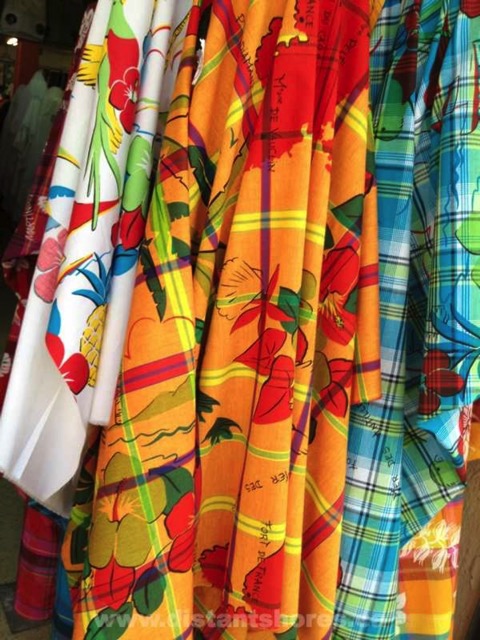
Beautiful fabric stores and fashion boutiques are a-plenty in the city of Fort-de-France
Our mission in Fort de France simply to get our wi-fi set up and do a bit of grocery shopping in the large supermarkets there. All we needed was a local Pay-as-You-Go data sim card for the Huawei E586 device that we use to connect to our computers for internet access onboard. It is a modem and portable local hotspot. Digicel is a Caribbean communications company that we had used in both St Lucia and the BVI with success so we went to the Digicel office to start the process. Well to make a long story short, we went back and forth to that store for 2 days and had no luck getting it to work. Our French isn't good and no one spoke English so that made things all the more difficult, I'm sure. In between we tried 3 internet cafes – none of them working or they only allowed you to use their computers which wouldn't work for the jobs we were sending. The only success we had was at the McDonalds on the waterfront right near the dinghy dock, not very satisfactory when we had a lot of things happening that required frequent back-and-forth correspondence. We didn’t want our time in Fort-de-France to spent sitting for hours in a McDonalds.
Fort de France to Ste Anne
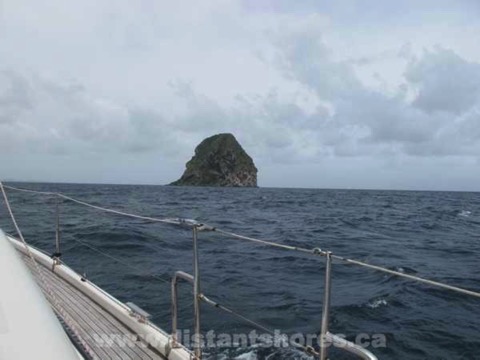
So on Thursday June 20 we raised anchor and left, internet free. How could a struggling country like Dominica have great wif-fi service and not the very developed sophisticated island of Martinique, a French department? Go figure. Getting out to sea helped us feel better. That is the great thing about sailing! It puts everything in perspective. It was a rougher sail than we expected as we rounded around to the south coast the strong headwinds.
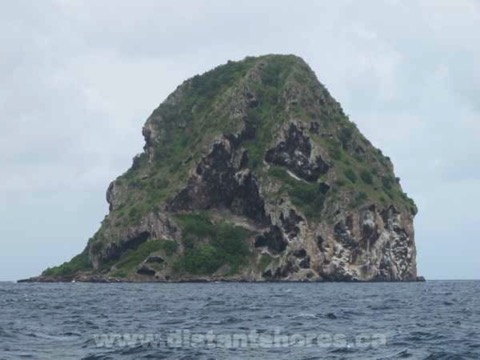
We passed the famous Diamond Rock that was captured by the British during the rule of Napoleon and named HMS Diamond Rock since they fired on French ships bringing supplies to Martinique. They held it for 18 months.
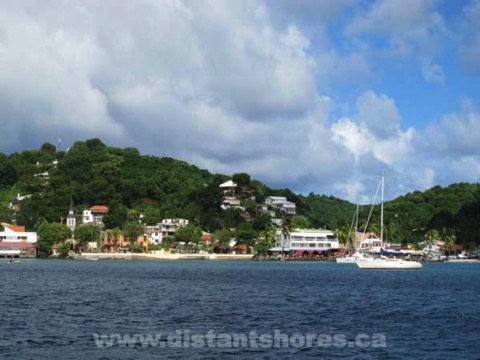
The seas and headwinds knocked down our speed so we arrived a little later than planned. But still time to go for drinks at the local internet provider, the restaurant La Dunette for 2 pina coladas (12 euros) to use the wifi. The ending to this story - their wi-fi didn’t work! Nor did it work in the 2 other internet cafes in town. It took days to repair. But now it’s flying like lightning and we are back in touch :-)
Until next time,
Sheryl and Paul
Aboard SV Distant Shores II
Ste Anne, Martinique
Dominica
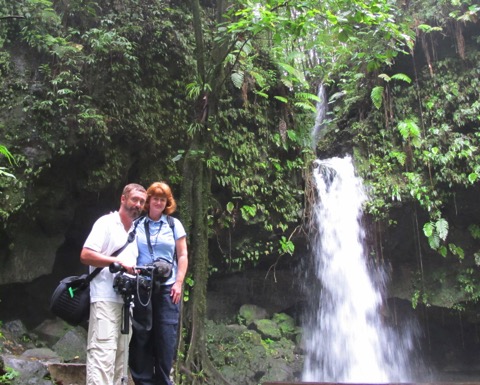
Its mountainous terrain makes it a haven for hikers and the beautiful clear waters make it a treasure for divers too. If you love quiet places and getting out in nature, Dominica is a great place to visit.
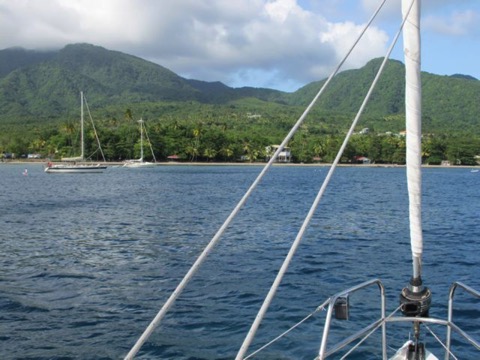
We arrived here aboard our Southerly 49 sailboat, Distant Shores II, on Saturday June 8 after 3-days of island-hopping from St Maarten to Nevis, Nevis to Guadeloupe, and Guadeloupe to Dominica where we’re anchored in Prince Rupert Bay off the town of Portsmouth on the northwest coast of this ruggedly beautiful and luxuriously green island.
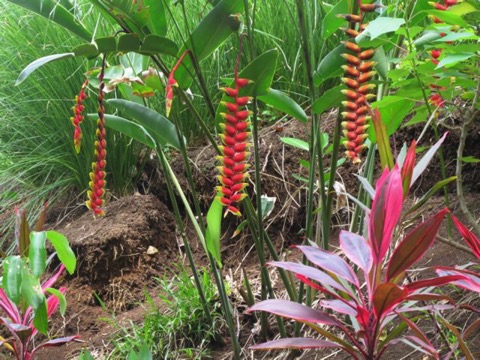
Our first visit to Dominica was 21 years ago (!) on our way home after a 3-year Atlantic Circle aboard our first boat, a Classic 37 sailboat named, "Two-Step". At that time we anchored off the capital city of Roseau (pronounced "rose oh") and were so hassled by overly aggressive "boat boys" - local vendors that come out to your boat on anything that floats, cling to your lifelines, and pester you to buy stuff from them and not anyone else - that we had no peace and vowed never to go back to Dominica!
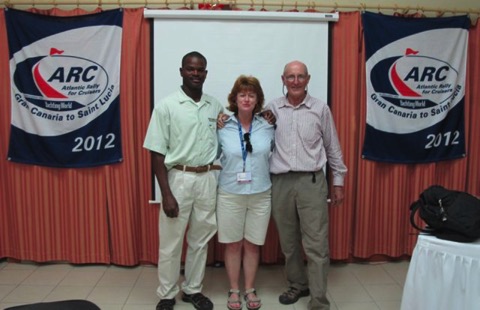
Left to right: Martin Carriere of Dominica, Sheryl Shard, and author Chris Doyle at ARC seminar in St Lucia about Cruising in the Caribbean
However, at the conclusion of the ARC (Atlantic Rally for Cruisers) in December we attended a lecture by Chris Doyle who told us about the huge improvements to yacht security and the yacht services training that locals have been given in Dominica to encourage cruising sailors to visit the island. Chris has cruised the Caribbean for decades and is the author of our favourite cruising guides to the Caribbean. We’re using his Cruising Guide to the Leeward Islands which covers Anguilla through Dominica and Cruising Guide to the Windward Islands which covers Martinique to Grenada. He also has a very good website www.doyleguides.com. We really trust his recommendations. Plus a lot of sailors we were meeting recently said Dominica was their favourite island in the Caribbean. Hmmm. Time to investigate.
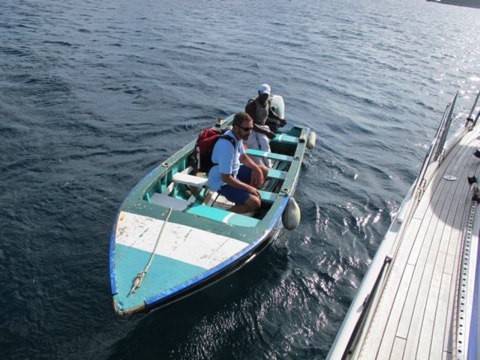
Chris talked about a group called P.A.Y.S. (Portsmouth Association of Yacht Services) based in Portsmouth, Dominica, which are a group of trained certified guides and local businesses that also patrol Prince Rupert Bay 24/7 during the winter sailing season (November to the end of May). They help "yachties" with numerous services from taking garbage to organizing scuba diving outings, plus offer guided tours by boat, especially the wonderful Indian River trip where scenes from Pirates of the Caribbean II were filmed, and island tours by van. He also introduced one of the members, Martin Carriere, who accompanied Chris to St Lucia for the lecture.
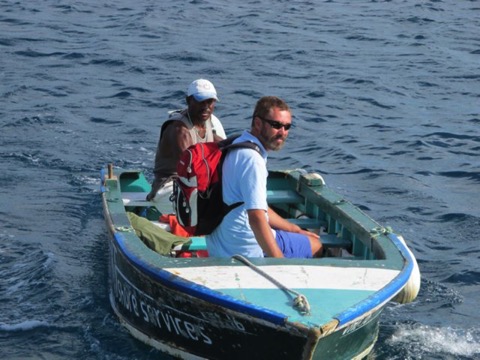
P.A.Y.S members monitor VHF 16 and when you arrive the P.A.Y.S. member on duty will come out and help you anchor or tie to one of the moorings they maintain and answer any questions you might have. They don’t pester. They also advertise in the Doyle guides where you can find the mobile phone numbers of most of the guides and learn their areas of expertise. Some are good fishing guides for example, others know good music venues, some specialize in bird watching, some are great hikers, etc. You can call ahead and your guide of choice will meet you with his boat and run you to customs for clearing in if you’d like, or take your crew to a local restaurant and pick everyone up afterwards if you’d rather use a water taxi service than launch your dinghy if you’re making a late arrival. We did this with Albert who also took 3 bags of laundry for cleaning and brought it back nicely dried and folded the next day for about $8 US per load.
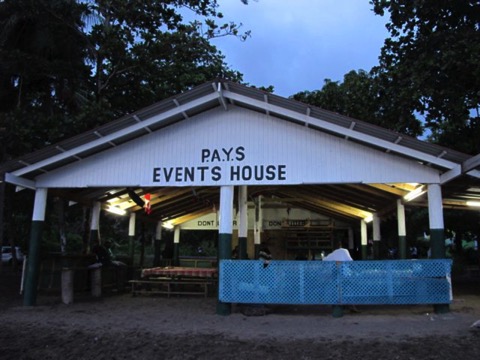
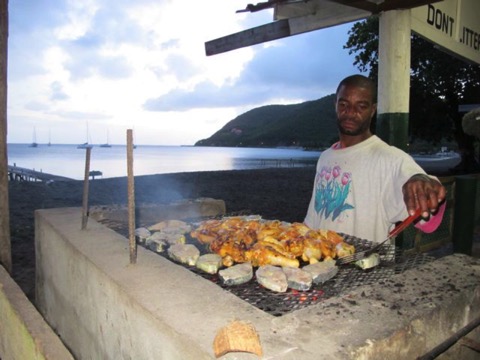
On Sunday nights they hold a fundraising BBQ at the P.A.Y.S. Events House which is a great way to meet other sailors as well as local Dominicans. The tickets are $20 US per person and there is a ton of great food, music, and all you can drink rum punch or fruit punch!
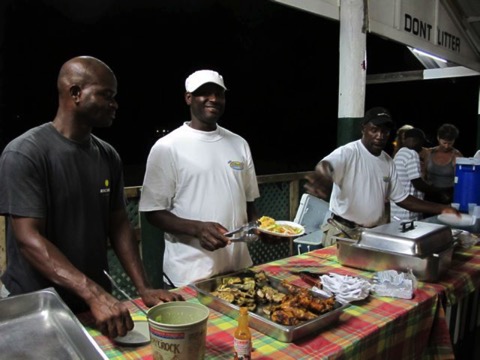
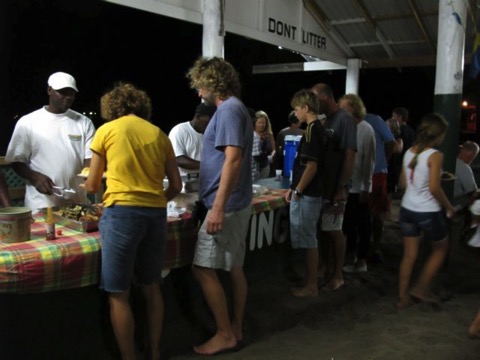
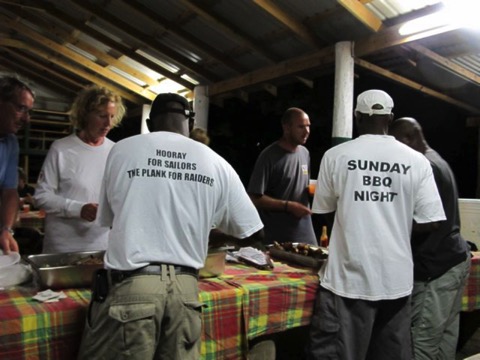
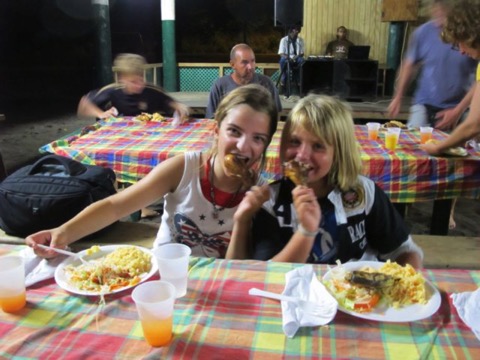
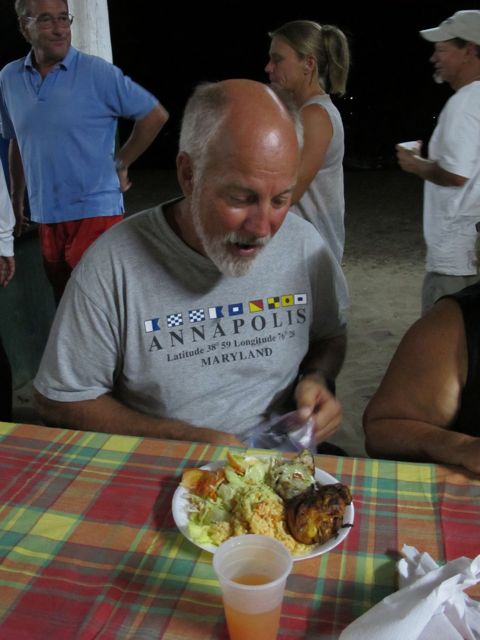
Since it wasn't originally in our plans to visit Dominica, I hadn’t applied for the necessary filming permits in enough advance time. As working journalists and filmmakers we can't just take pictures and videos freely as regular tourists since our images are used commercially for television and magazine publication. And the process is a bit complex in Dominica since there are many different government departments and sites that require different permits and charge different permit fees due to the many National Parks, Reserves, etc. across the island. So on Tuesday I had to make a 1-hour trip into the capital city of Roseau to meet with Samantha Smith, Marketing Director at the Discover Dominica Tourist Authority office, who was extremely helpful and supportive in streamlining the permit process so that we could film an episode of Distant Shores about Dominica. Paul stayed on the boat continuing post-production work while I dressed for a business meeting and rode the bus to town.
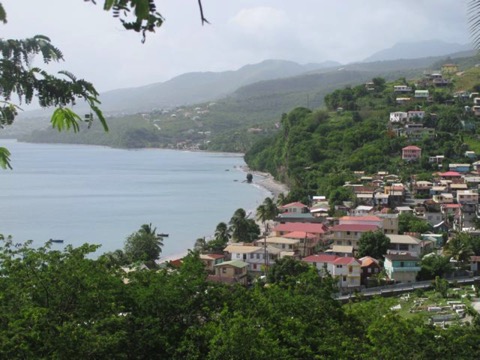
I took one of the local buses, a little 10-person van, which is a great way to meet local people and experience their daily routines. The vans run constantly and the cost was 9 EC (~ $3.50 US dollars) one-way. The route was all along the excellent and newly paved coastal highway so I enjoyed the ride and the beautiful scenery. Everyone I met was helpful and friendly and I felt so glad that we had decided to come back to Dominica. There HAVE been big changes in attitude and economy since our visit over 20 years ago! A lot can happen in a generation!
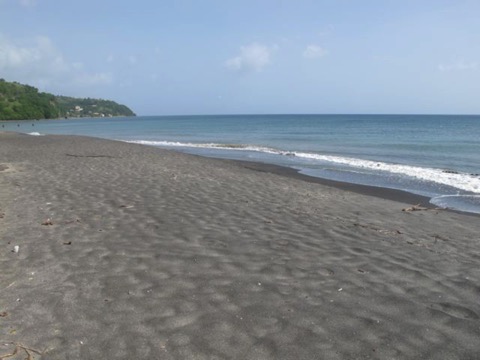
Black volcanic sand beaches
Our filming permits came through on Thursday. Samantha had helped me design a very interesting itinerary for Thursday and Friday with Martin Carriere, the P.A.Y.S member who we'd met at the lecture in St. Lucia, as our guide.
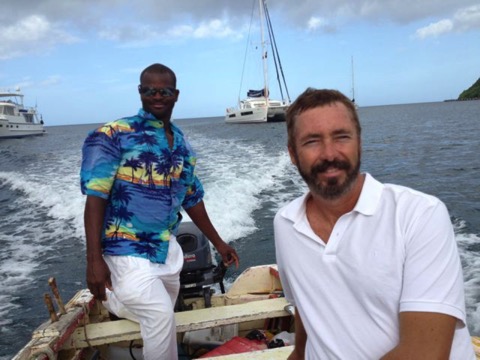
Martin picked us up in his boat, Providence, early Thursday morning and drove us in his van to the northeast coast of the island, a rugged exposed coast on the windward side.
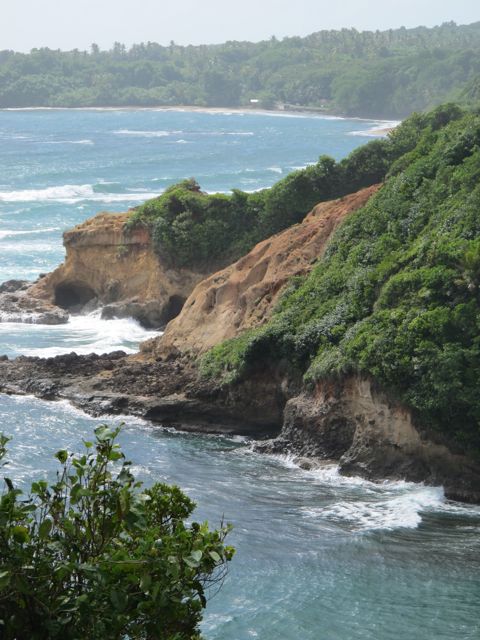
Here we visited the Carib territory where they have set up a traditional village called the Kalinago Barana Autê where you can learn about the history and traditions of the indigenous people of Dominica.
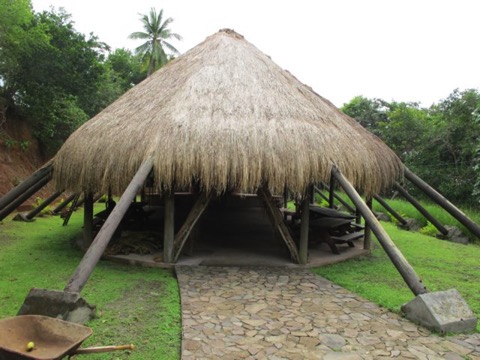
In the high season, November until May, they have music and participatory activities on a regular basis.
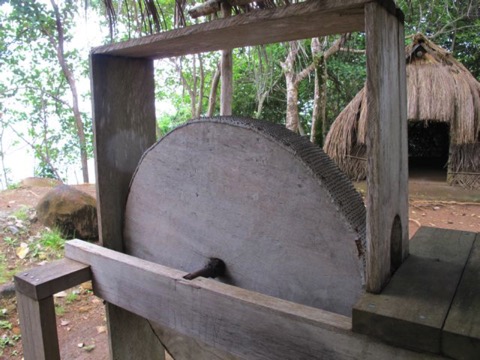
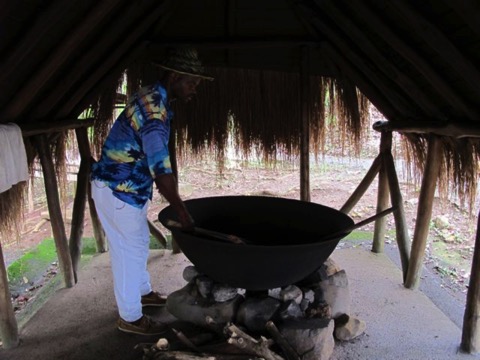
Martin showed us how they grind up cassava root and boil it up to make cassava bread.
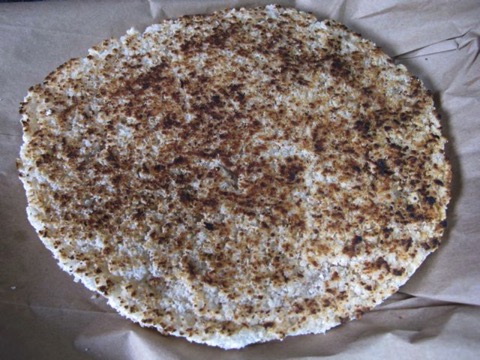
They mix the dried cassava with coconut and and a little salt then cook it on a griddle to make bread. Delicious!
One of Martin's areas of expertise is with local cuisine. He and his wife, Florian, offer cooking classes on a Saturday that start with a tour of the Saturday market in Portsmouth buying ingredients for the meal you will learn to prepare and then eat at the P.A.Y.S. Events House. Unfortunately we weren’t able to organize to attend one of their classes on this visit but hope to in the future. On our island tour Martin made sure we got "a taste of the island."
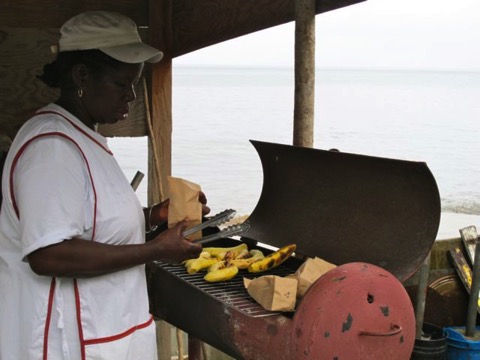
We stopped at roadside stands for a grilled plantain snack - looks like a banana but tastes more like a potato. Healthful and filling.
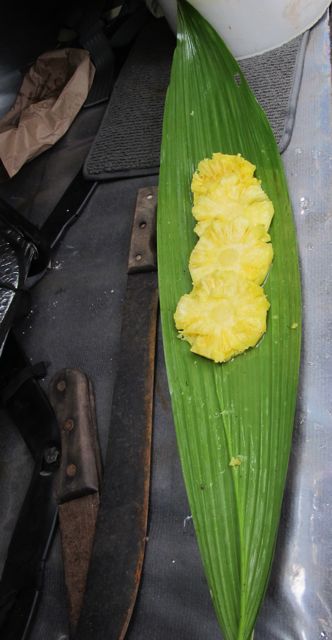
He cut up fresh pineapple.
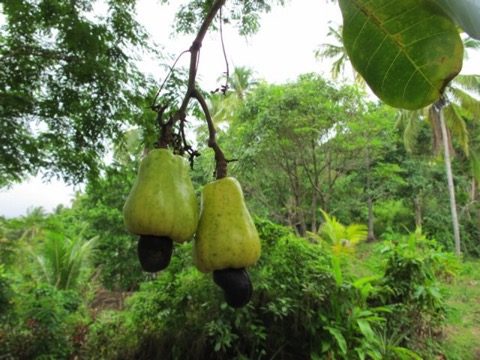
Martin showed us raw cashews. They hang below a plum-like fruit and are deadly when raw. They make your skin and throat swell up. They must be roasted first to be eaten!! The fruit makes a nice juice. Who knew?!!
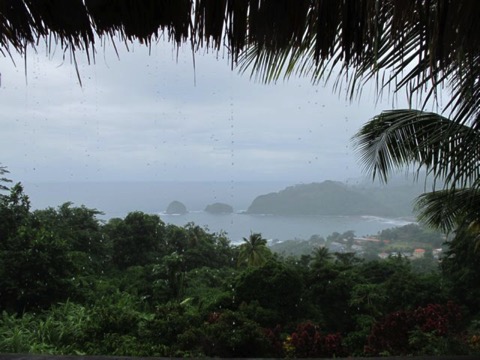
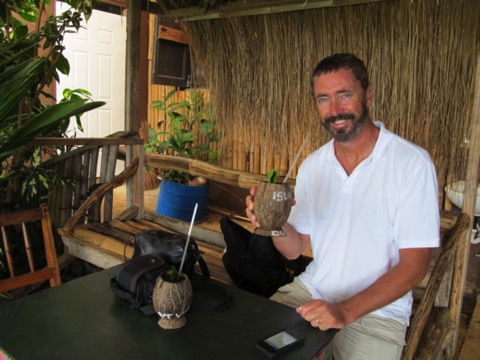
While touring the island of Dominica we stopped often to refresh ourselves with cool drinks (non-alcoholic since we were working) made from local fruits. At the Islet View Restaurant and Bar we tried star fruit juice.
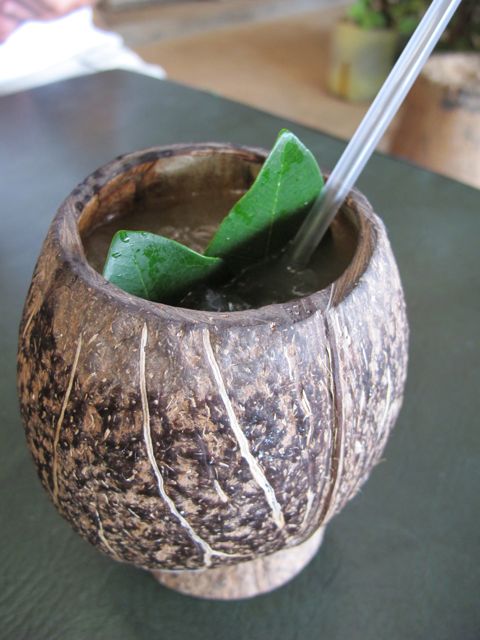
The star fruit juice is served on ice in a coconut and garnished with fresh bay leaves. 3 kinds of bay leaves grow on Dominica - one that's slightly lemon flavoured, one licorice flavoured, and one cinnamon flavoured.
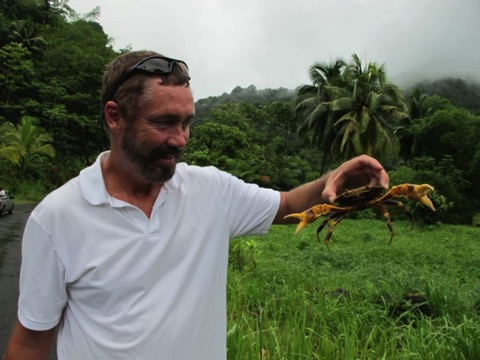
There are lots of species of both land and sea crabs on Dominica. Here Paul proves his ability to catch them with his bare hands. Crabs are used in the local dish called Callaloo. (No crabs were harmed in the making of this episode of Distant Shores. Nor TV presenters.)
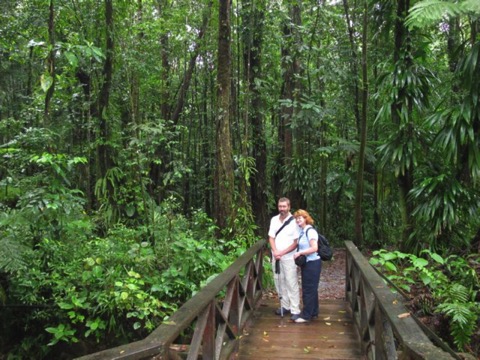
If you love relaxed walking or serious hiking there are numerous trails from easy to advanced through the rain forests of Dominica. Just be prepared - it does in fact rain! Here we are doing on easy 10-minute easy walk to Emerald Pool.
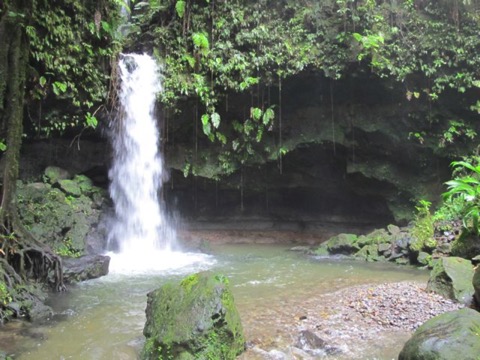
There are said to be 365 waterfalls in Dominica - one for every day of the year! You can swim in many of them.
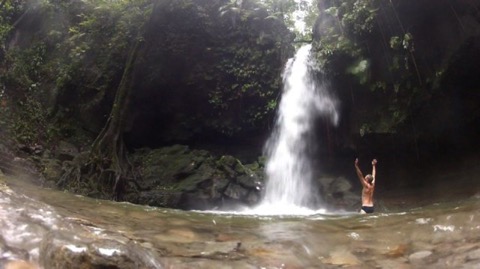
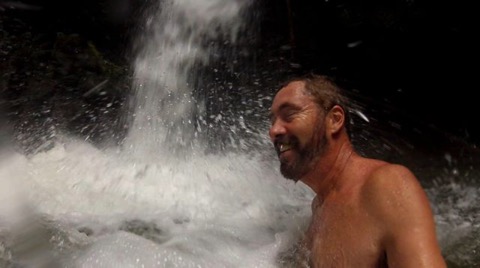
Paul swimming in the Emerald Pool. We had it all to ourselves.
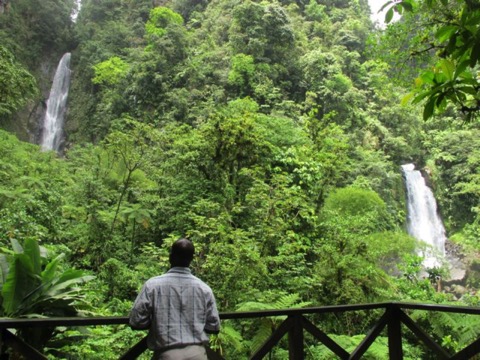
The hike out to Trafalgar Falls is another nice hike to double waterfalls. You can walk right up and swim here too. There are also hot springs. Paradise!
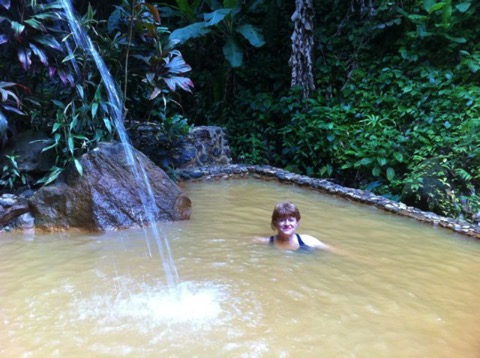
There are nice several spas around the island that make use of natural sulphur hots springs. We stopped at Tia’s Sulphur Springs. Ahhhh.... Good after a day of hiking in the rain.
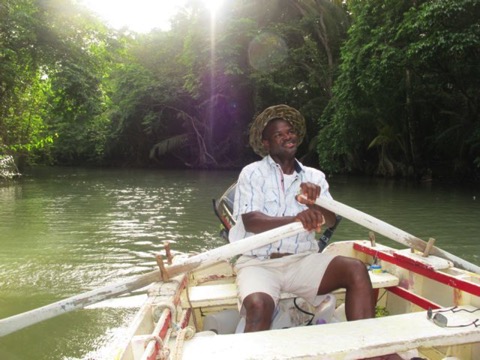
Our favourite activity touring Dominica was the river trip with Martin up the Indian River. Several scenes were shot here for the "Pirates of the Caribbean" movies 1 and 2 for the home of the mystic goddess, Caruso.
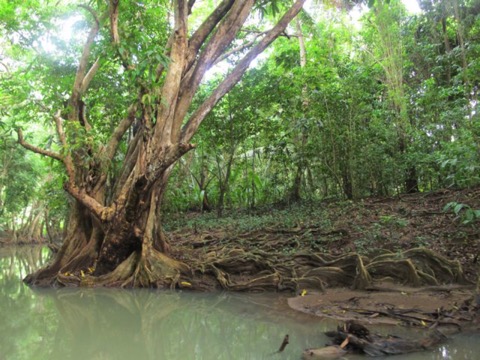
Amazing roots on the bloodwood trees.
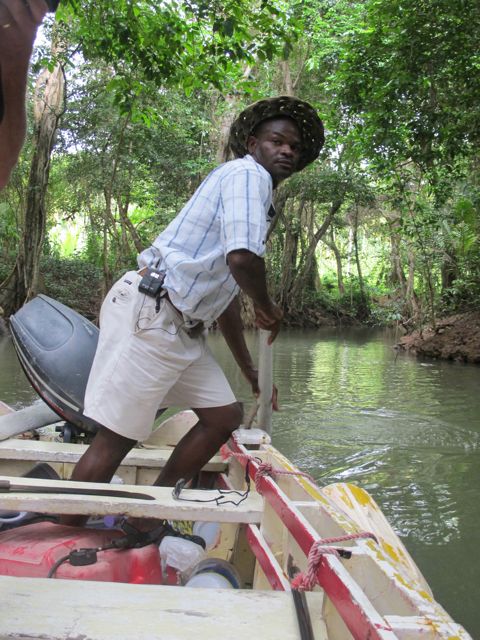
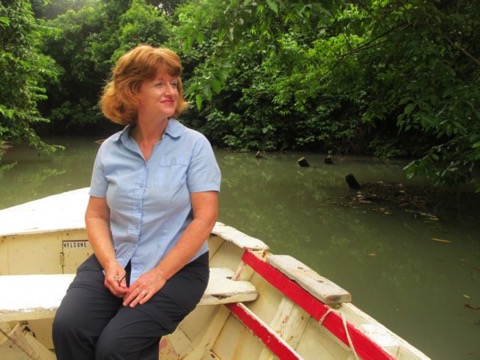
No outboard motors are allowed to be used in the Indian River and you must go with a local guide. No problem.
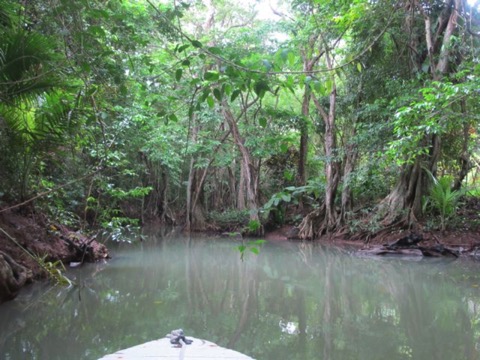
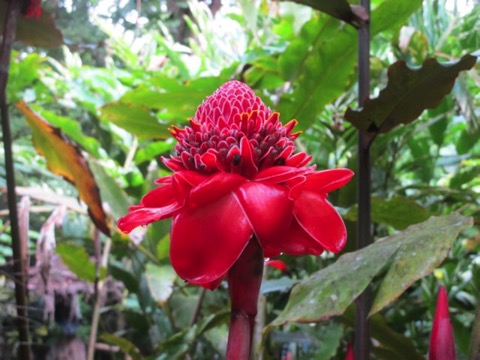
The vegetation is so exotic and Martin shared his knowledge of flora and fauna.
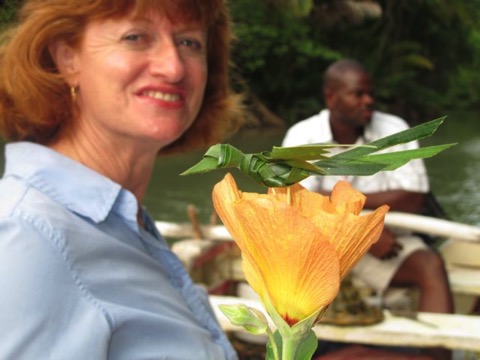
Martin also made me this lovely hummingbird out of palm fronds as a souvenir of Dominica. I don’t think we will ever forget the memorable visit to Dominica. We’re so glad we came back!
The Distant Shores episode on Dominica #115 will be broadcast this summer and available on DVD and download in August 2013.
Departing St Maarten
I, Sheryl, just got back to the boat after a 2-week visit home to Canada for some business meetings and to catch up with family and friends. Paul stayed on board Distant Shores II anchored in Simpson Bay Lagoon working on scripts and rough-editing 2 new episodes of the Distant Shores sailing adventure TV series while I was away. Paul and I have been married for 27 years and this is the longest we’ve ever been apart! Thank goodness for skype and facetime so we could make video calls :-) We had dinner together via skype a few times and whenever I was at a gathering of friends and family we would call up Paul on skype and pass him around. Isn’t technology marvellous!
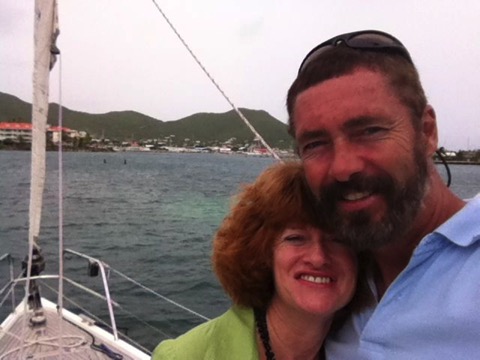
I flew back to St Maarten from Toronto yesterday and Paul met me at the airport and then treated me to lunch at the St Maarten Yacht Club. I had a great time at home but it was so good to be back on board Distant Shores II with Paul.
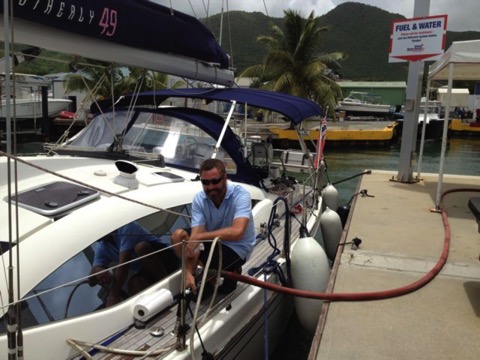
Today was a day of chores. First thing this morning we raised anchor and headed for the fuel dock at Island Water World to top up the fuel and water in preparation to sail to St Kitts and Nevis tomorrow and then continue down-island. IWW generally has the best price on fuel in St Maarten. Today diesel was $1,18 US/litre and water 15¢ per US gallon. If you pay by credit card there is an extra 4% surcharge.
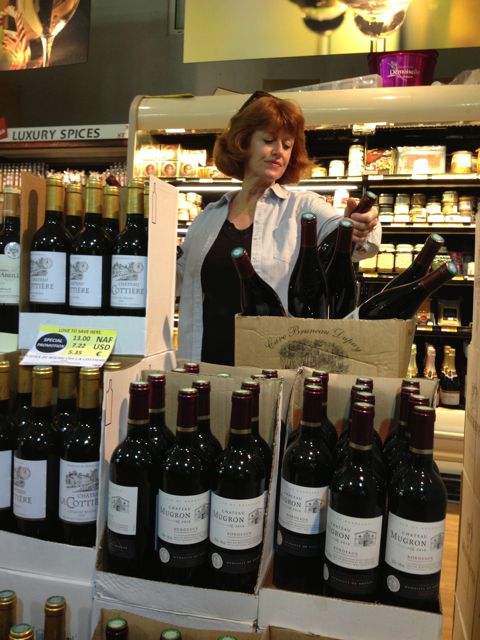
Next on the list was stocking up on provisions. We like to shop at Le Grand Marche in St Maarten. We can take the dinghy to the dinghy dock at Port de Plaisance Marina and walk up from there. There's a very nice selection of European delicacies & wines at good prices since the island is duty-free. For even cheaper prices there is a Cost U Less (similar to Costco or Sam's Club) a bus or taxi ride away but Le Grand Marche is convenient. They give a 5% discount if you're doing a large purchase for the boat and offer free delivery in the store's van to the dinghy dock. We give a few dollars tip the driver who usually helps carry stuff from the quay down the dinghy dock.
As I write to you now, Paul is at Customs and Immigration clearing us out to leave first thing tomorrow morning. I’m on board stowing provisions. I’m protecting the wine bottles in clean socks to prevent breakage. I also group similar items and put them in self-sealing plastic bags. This makes it easier to find things and if anything breaks or leaks, the mess is pretty much contained in the plastic bag.
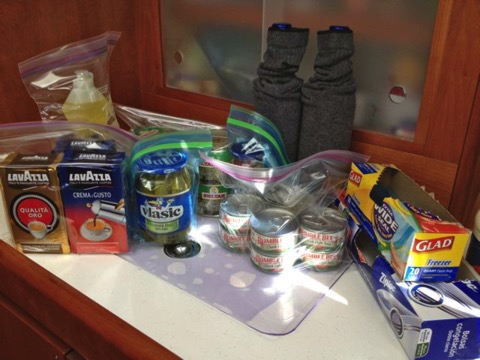
Everything is stowed under in lockers around the boat. Under the bed, under the settees, wherever there is space.
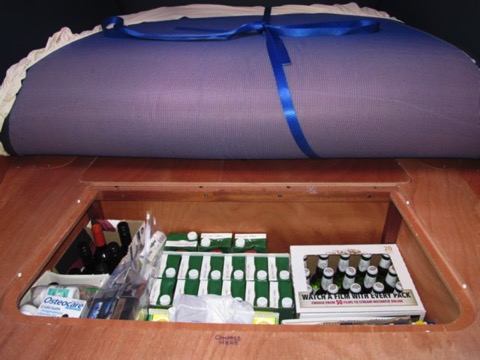
We came out of Simpson Bay Lagoon through the Simpson Bay Bridge at the 4:30 p.m. bridge opening. The opening at 4:30 pm is for outgoing vessels and at 5:30 p.m. it opens for incoming vessels. We are now anchored in Simpson Bay ready to sail off tomorrow morning, all going well.
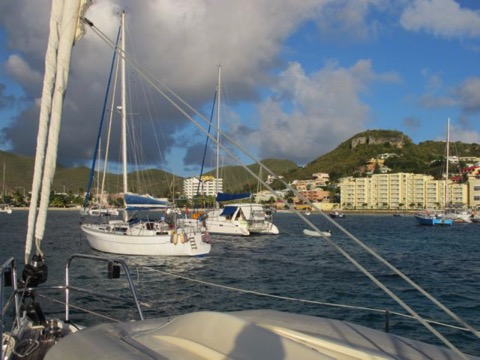
We may be out of touch for a couple of days as we island-hop south but will post again as soon as possible.
We’ll be in touch again soon!
Warm regards,
Sheryl and Paul
Aboard Distant Shores II
St Maarten - Carnival 2013
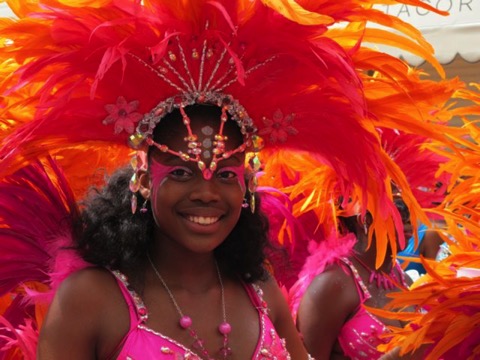
St Maarten Carnival Parade
Hello Everyone!
It's May 1st and therefore the May Day public holiday in the Dutch/French island of St Maarten/St Martin, as it is in many places around the world today, so most businesses are closed and people are enjoying time with friends and family.
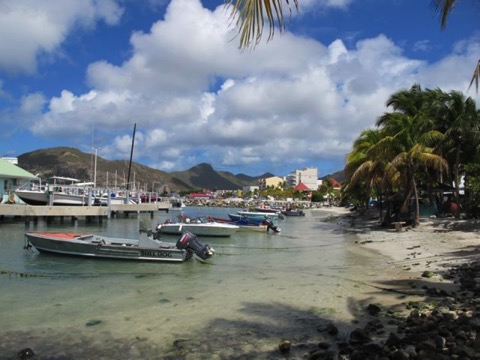
There have been a series of public holidays in St Maarten since we arrived here last Friday sailing from the BVI. Yesterday was the St Maarten Carnival in celebration of the Dutch Queen Beatrix's 75th birthday. She is actually the former queen since she abdicated yesterday and her son Prince Willem-Alexander is now king, so the celebration continues for new reasons.
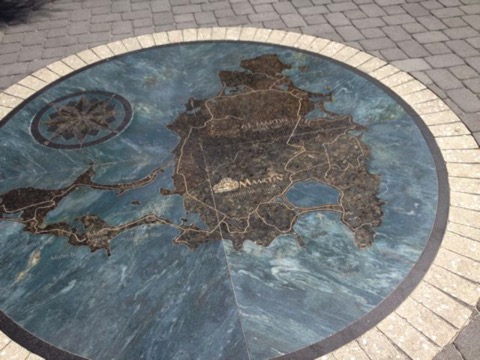
There was a big parade for the St Maarten Carnival in Philipsburg, the capital, so we met up with Canadian friends, Dave and Alex from SV Banyan, at St Maarten Yacht Club at 9:00 a.m. and caught one of the little buses that runs along the main road in front of the club to go and see the parade.
The little local buses in St Maarten are great. You can just flag them down anywhere along the road and for $2 US a person make the 15-20 minute trip into Philipsburg from where we are located near the Simpson Bay Bridge into Simpson Bay Lagoon. The buses are vans that seat about 8-10 people. Just look at the license plate. It says BUS followed by a few numbers. Taxi vans say TAXI on the license plate followed by a few numbers. When you get on the bus it is courteous to say “Good Day” to everyone on board. Tell the bus driver where you want to get off and he'll stop there for you. You can ask to stop anywhere along the route. Everyone is very helpful if you're not too sure where the best place to get off is.
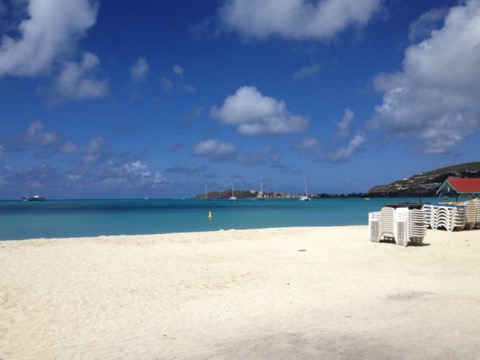
We'd been told that the parade would start at around 11:00-11:30 a.m. and that we should get to Philipsburg early since they'd be closing the road but when we arrived the streets, and even the usually crowded waterfront promenade, were pretty much empty. There were a few people setting up stands who told us the parade didn't start until 1 p.m. but that was further out of town and it wouldn't get to Front Street, where we were now, until around 2 or 3 p.m.!
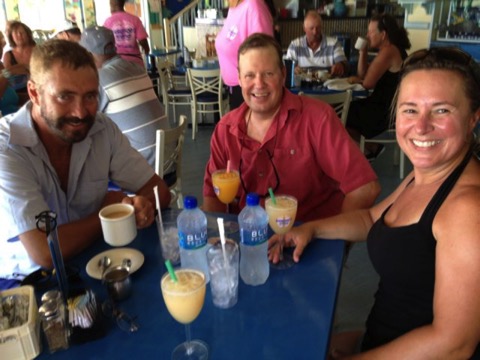
Well, no problem. It was a beautiful morning so we strolled along the promenade and then Paul, Dave, Alex and I went for brunch at one of the pleasant waterfront restaurants. Some of the shops were open too, since Front Street in Philipsburg is a tourist zone and home to many duty free electronics shops, so we were able to pick up an additional computer drive that we needed as we wandered in and out of the stores filling time until the parade started.
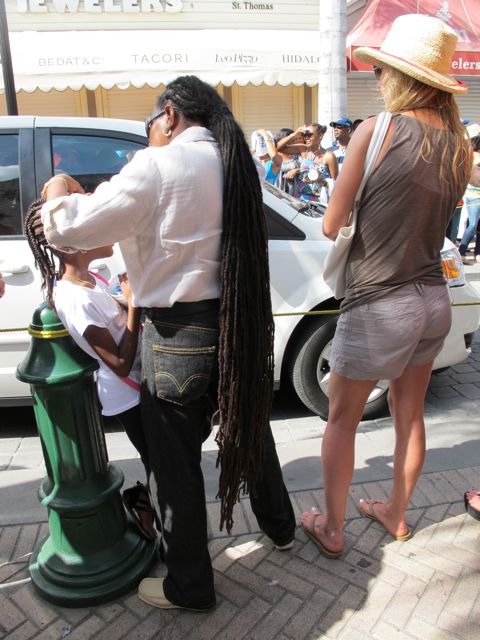
It was well worth the wait! I think more people living in St Maarten participated in the parade than were watching it - and there was a good crowd!
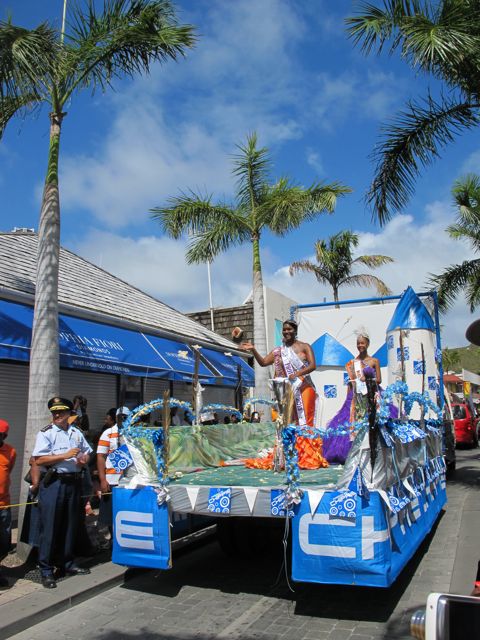
The live bands on floats and troupes of fantastically costumed dancers were amazing!
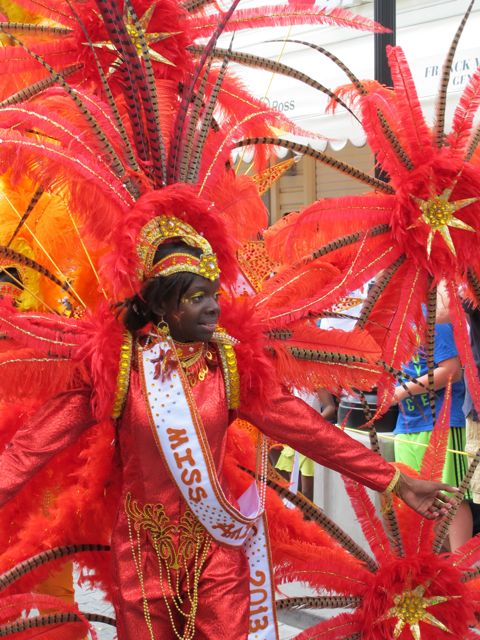
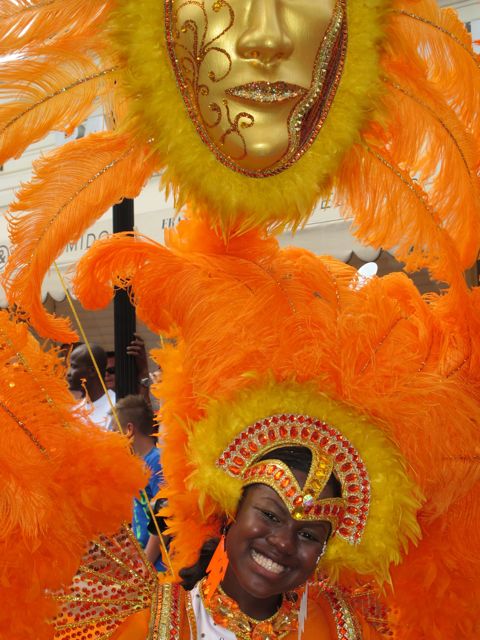
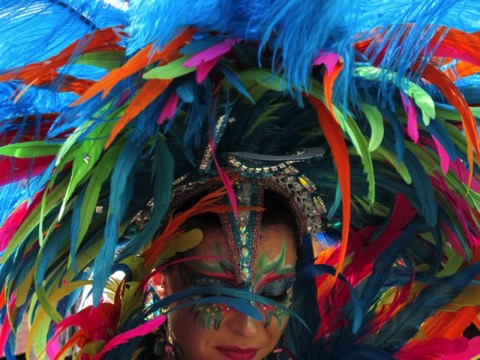
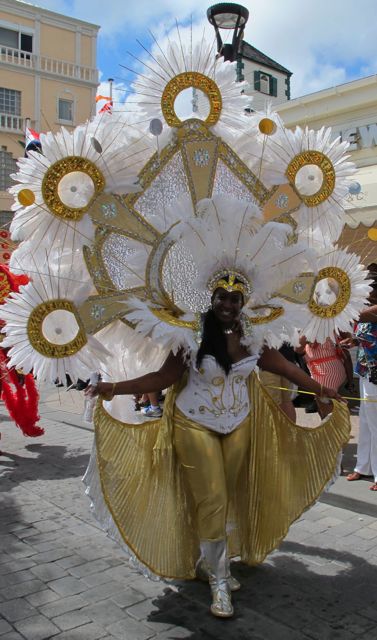
People of all ages participated and since the parade route was so huge everyone attending could get a front row position to watch it somewhere along the streets.
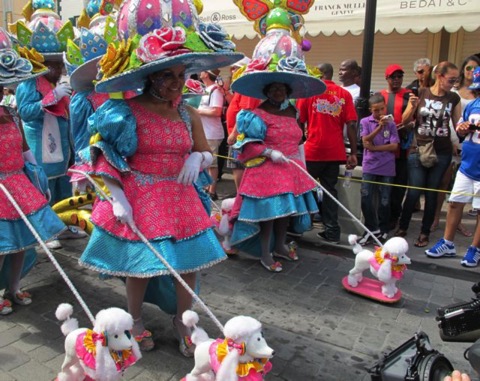
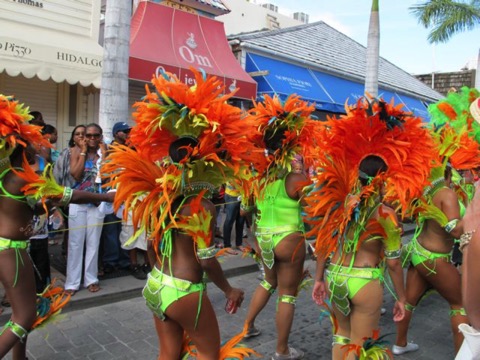
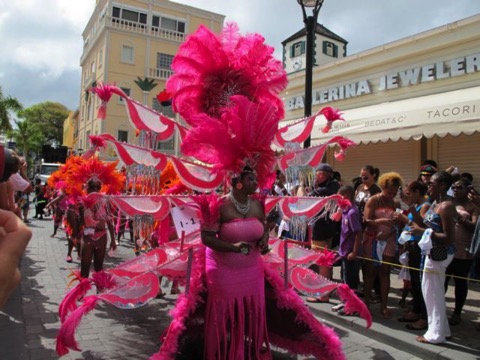
The parade went on for over 2 hours. Wow! What a day!
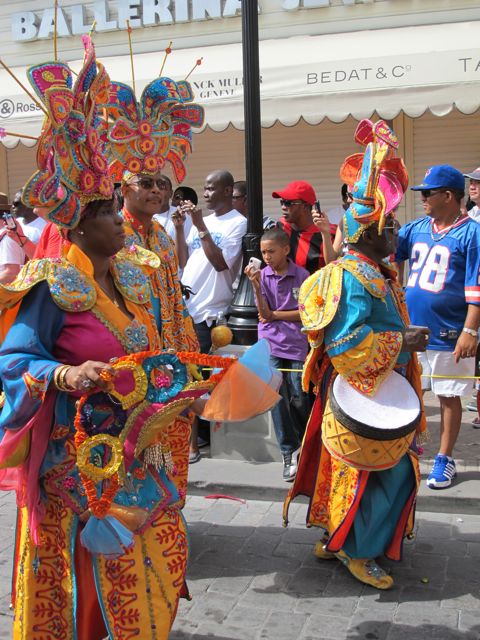
These are just a few photos. The highlights are on video and will be included in a new episode of the Distant Shores sailing TV series.
Alex on SV Banyan is a really good blogger so check out her story and photos as well at http://www.sailblogs.com/member/banyan/
Happy Carnival, Everyone!
Sheryl and Paul
Aboard SV Distant Shores II
Simpson Bay Lagoon
St Maarten
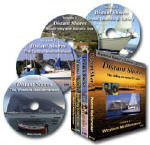
Click here to check out our DVDs for more cruising adventures and tips!
British Virgin Islands to St Maarten
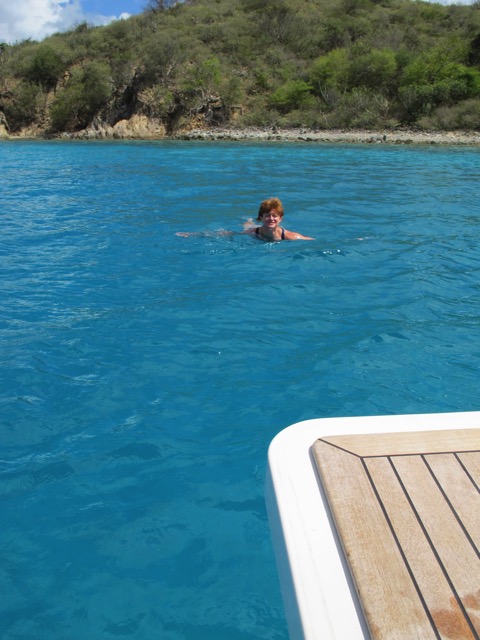
Hello Everyone,
The time arrived at the end of April to conclude our winter respite in the British Virgin Islands and begin the next leg of our voyage - heading south through the Caribbean island chain so that, come summertime which is hurricane season, we would be out of the hurricane belt.
The area of high risk for hurricanes in the Caribbean region, as defined by our yacht insurance company Pantaenius Yacht Insurance, is East of 98°W and West of 60°W, and between the Latitudes 10°N and 30.5°N. The “Named Tropical Storm Clause” in our insurance goes into effect from July 1st to November 15th. Different insurance companies have different limitations so check this out if planning to sail or store your boat in the Caribbean during the summer and autumn months.
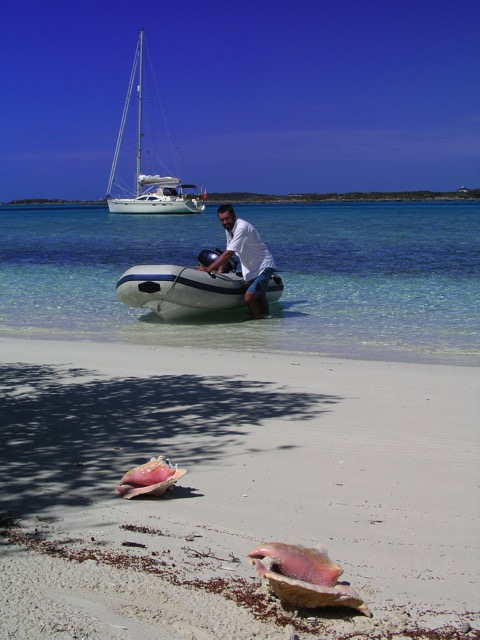
Paul at Pipe Creek, Bahamas
Another option for avoiding hurricanes in the summer would be to sail north through the islands of the Bahamas, one of our favourite cruising grounds as you may have determined by the number of Bahamas Distant Shores episodes we have filmed there, and then north to the Chesapeake Bay, another great cruising ground on the east coast of the USA that we have documented in the show. (Maine and the Canadian Maritimes are other appealing summer destinations for many sailors that cruise in the Caribbean for the winter, as is the Great Loop, a route exploring inland waterways of the USA and Canada.)
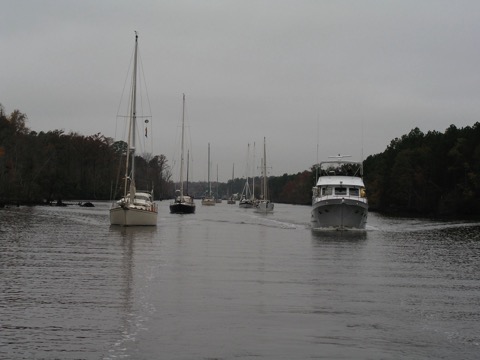
Travelling through the Erie Canal, Chesapeake Bay and Intracoastal Waterway (ICW) in Distant Shores Season 6
We have made the trip up from the Caribbean to the Bahamas, the Chesapeake Bay and home to Canada through the Erie Canal to the Great Lakes and Trent-Severn Waterway in the past and, since next season we are are planning to cruise the western Caribbean, going north would mean a long journey retracing our steps back to the Caribbean in the fall. So we have decided to take the boat south for Hurricane Season this year and explore more of the leeward and windward islands along the way.
The first leg of our journey south from the BVI was to sail back across the Anegada Passage to the Dutch/French island of St Maarten/St Martin, a passage of about 90 nm. In February we did this in the opposite direction, going St Maarten to the BVI, which is generally a nice downwind sail with the current in your favour as well. (See Feb 26/13 newsletter).
But going the other way, from BVI to St Maarten, is a whole different story since you are sailing into the trade winds and with the 1 to 1.5 knot current against you, so you need to plan the eastbound journey a bit more carefully. As cruising sailors we are blessed with hundreds of great sailing days in a year so the general strategy for this passage is to wait for calm conditions, motorsail into it topping up your batteries as you go, and Get It Done. From St Maarten heading south through the island chain your angle of sail is better and you can expect days of great beam-reach sailing with regular trade winds blowing from the east.
Checking the weather forecast on WindGURU we saw light wind conditions predicted for Thursday April 25 and Friday April 26. On Friday, the wind was predicted to be slightly more ENE rather than E and since we were going to set sail from North Sound in Virgin Gorda at the most northern end of the BVI we would have not-bad angle on an ENE wind. If we left very early on Friday morning there was a good chance we'd be able to make the 12-hour passage under sail, at least for part of the day. (Of course you could skip St Maarten altogether and sail southeast to islands further down the chain to avoid a headwind bash but St Maarten is a great place to stock up on provisions, fuel, and chandlery items before sailing down-island so we really wanted to stop there.)
The Cruising Guide to the BVI by Nancy and Simon Scott have a good section on options for sailing south from the BVI to the Leeward Islands of the Caribbean.
A new customs office in the BVI has recently opened in North Sound (also called Gorda Sound) at Gun Creek just across the sound from where we were anchored off Saba Rock so in the late afternoon on Thursday April 25 we motored over to Gun Creek, anchored off the customs quay, and cleared out of the BVI. You can clear out 12 hours before your planned departure.
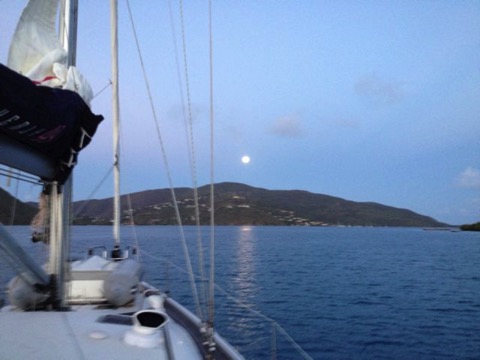
Early the next morning, Friday April 26, we were up at 4:30 a.m. and raised anchor at 5:30 a.m. just as the sun was rising and the full moon was setting over Virgin Gorda, a beautiful farewell image of the BVI.
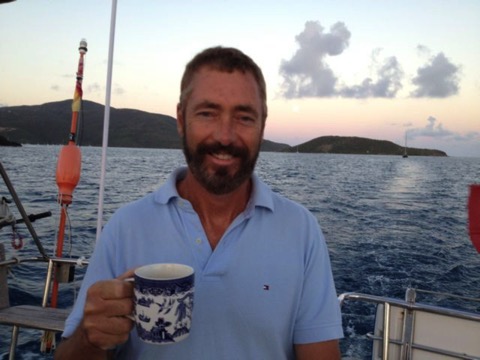
Heading out of the sound into Necker Passage we noticed there were 3 other yachts in our wake. We wouldn't be alone out in the Anegada Passage.
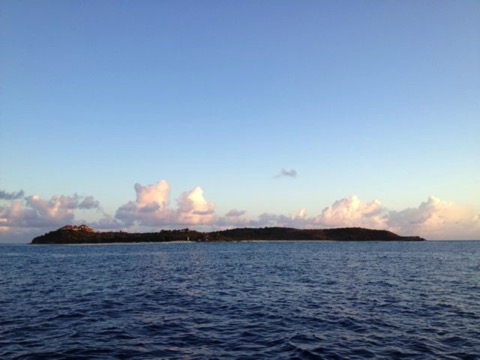
Necker Passage takes you out past Necker Island, the multi-million dollar private resort belonging to Sir Richard Branson, owner of Virgin Airlines and other Virgin Group corporations.
We were soon out into open water, mainsail raised and self-tacking jib ready to unfurl but the wind never did set in from the ENE. It was light and on the nose, due E, the whole day. Motorsailing it was to be. It was a very clear day and Virgin Gorda didn't disappear off our stern until mid-morning. We each stood our watches listening to audio books on our iPhones to pass the time and watching the many sea birds and passing ships. The Anegada Passage is a gateway to the Caribbean for ocean-going ships travelling to and from the rest of the world. 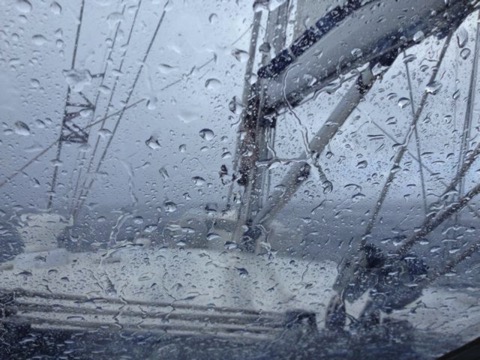
At the half-way point we passed sailboats heading in the opposite direction and the blue skies began to get cloudy. Then the radar started to show patches of squalls developing and by the afternoon we were getting scattered shower – brief and cooling.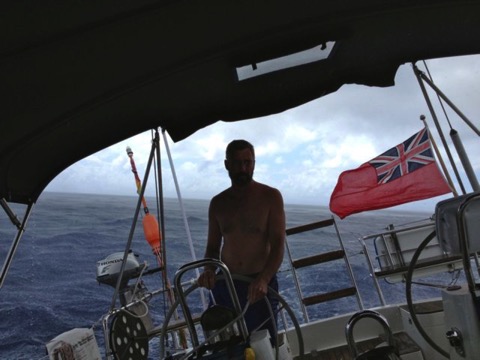
However, just after sighting St Maarten on the horizon in the late afternoon, we got a series of big squalls. No worries. The heavy rain gave the boat a good cleaning washing all the salt off the decks.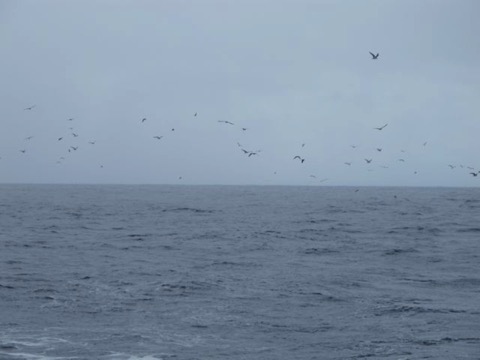
At the same time as the squalls passed we noticed an incredible feeding frenzy going on. Hundreds of sea birds were diving on fish at the surface all around us. Now we're not very good at fishing but we thought if we put out a line in this location we couldn't go wrong. Over the years we've done a lot of fishing with the hand spear but not so much with a line. But now we're getting into it and found a great book to guide us, The Cruiser's Handbook of Fishing by Scott and Wendy Bannerot. We dropped our line but I guess we were a bit late doing it since no fish seemed interested in our lure. Oh well. Better luck next time.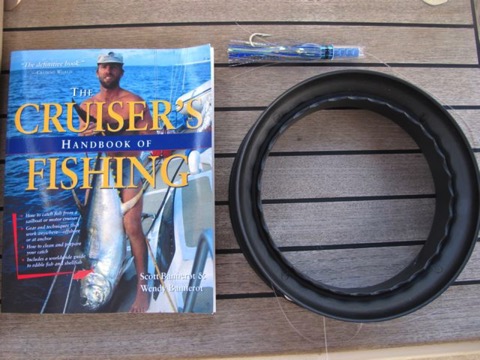
Just after 5:00 p.m. the skies had cleared and we were rounding the south end of St Martin/St Maarten in sunshine under blue skies. By 5:30 p.m. we were dropping the hook in Simpson Bay on the Dutch side of the island just behind SV Banyan owned by Canadian friends, Dave and Alex, who had left the BVI the day before us. 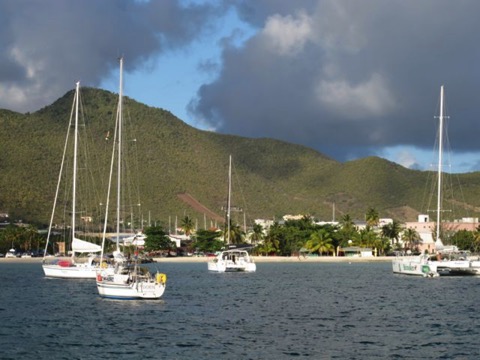
That's the great thing about cruising. You meet so many great people on your travels and encounter them many times in many places. A welcome always awaits you.
Until next time,
Sheryl and Paul
Aboard SV Distant Shores II
Join our email list and get hints, technical articles and tips plus videos to help you achieve your cruising dreams.
- FREE 1/2 hour video on cruising the Exuma Islands in the Bahamas
- Technical Blog shows you how to deal with issues facing the cruising sailor
- Destination information from some of the world's best cruising areas
- Special discounts and promotions
Turtles
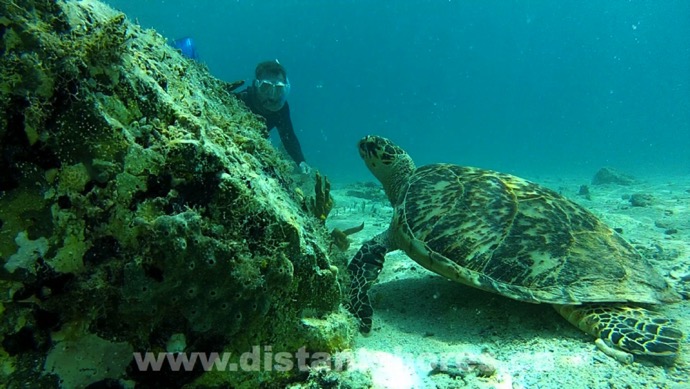
He was cruising the reef and we got to swim with him for more than half an hour!
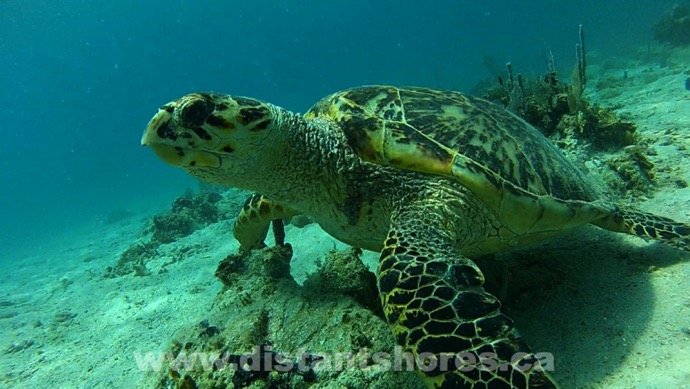
Its about 4 meters deep here. Sheryl comes to take a look.
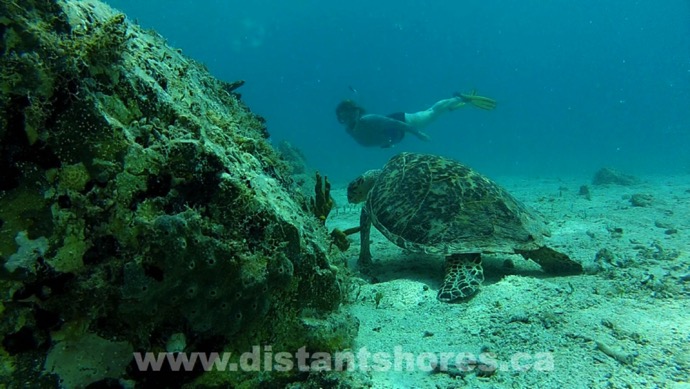
He was browsing on the bottom and got used to me being around.
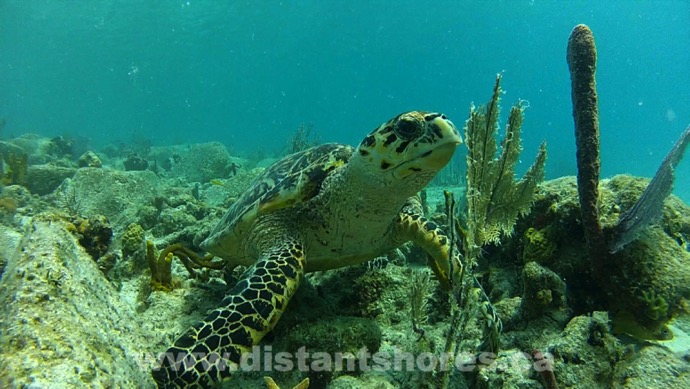
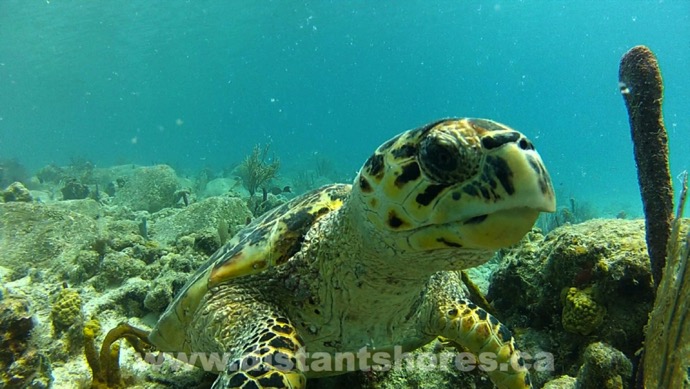
He went back to biting away at corals on the reef.
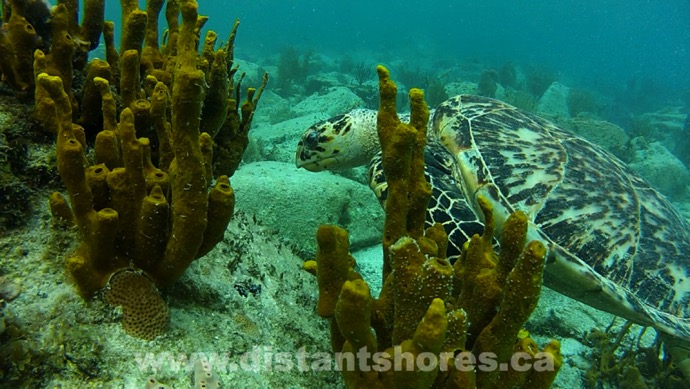
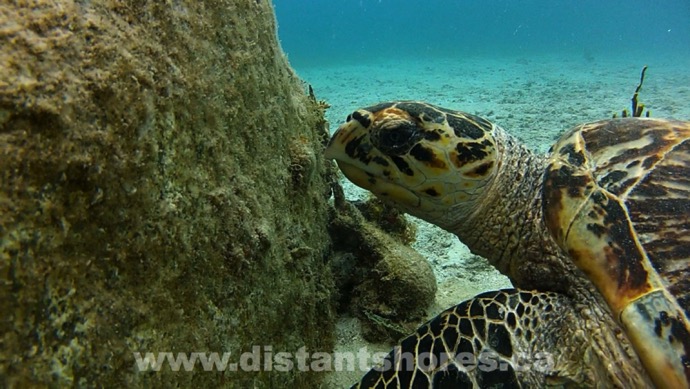
Investigating the camera on the tripod... is it edible?
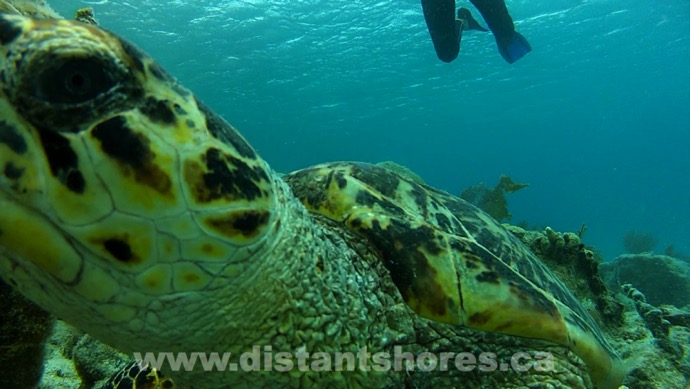

Going up to take a breath - only once every ten minutes or so.

Such a privilege to see an animal like this in the wild!
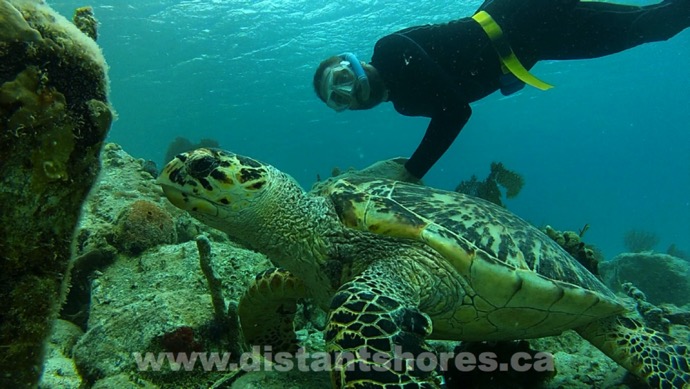
At Anchor BVI
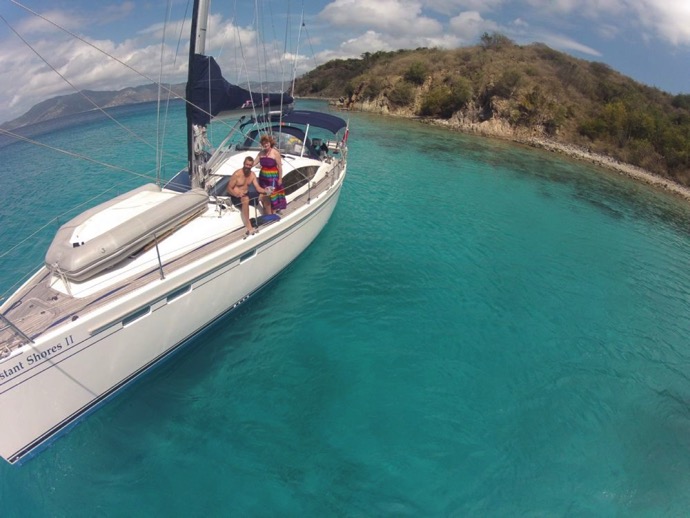
Enjoying the reef.... All around the bay is nice snorkelling in clear water. No swells so it is good for beginners too.
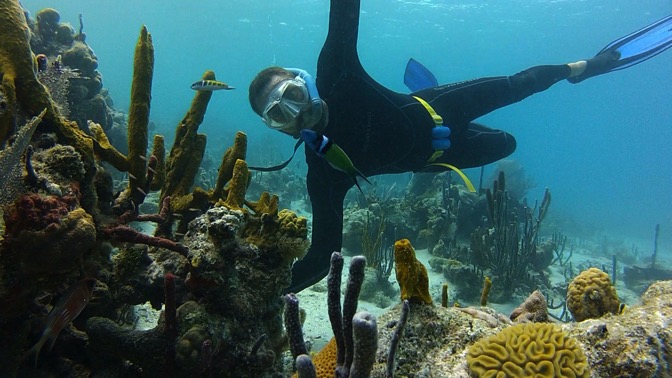
The reef right behind the boat has some great fish and very clear water. This is a trumpetfish.
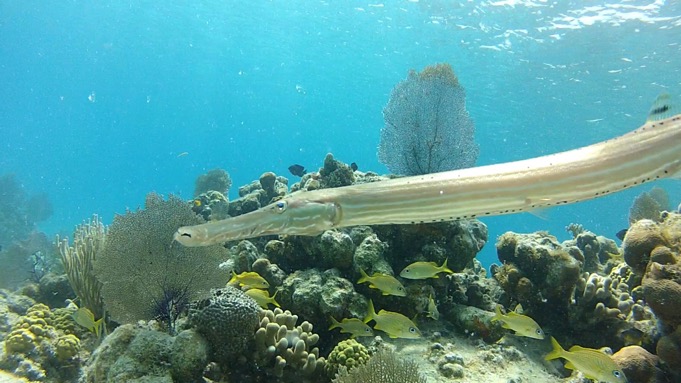
Trumpetfish hang still and pretend they are waving corals...
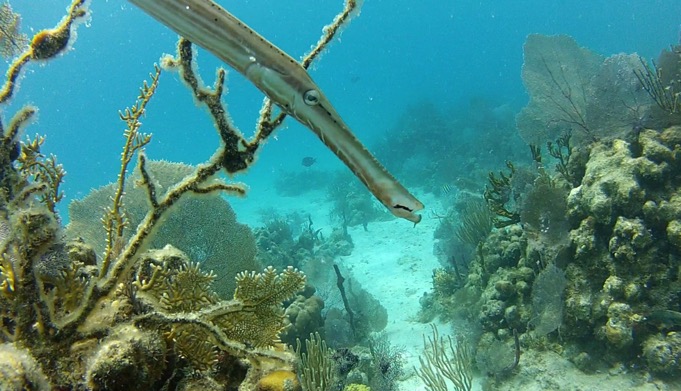
Here’s a Porcupinefish - a member of the Pufferfish family. He’s about half a meter long.
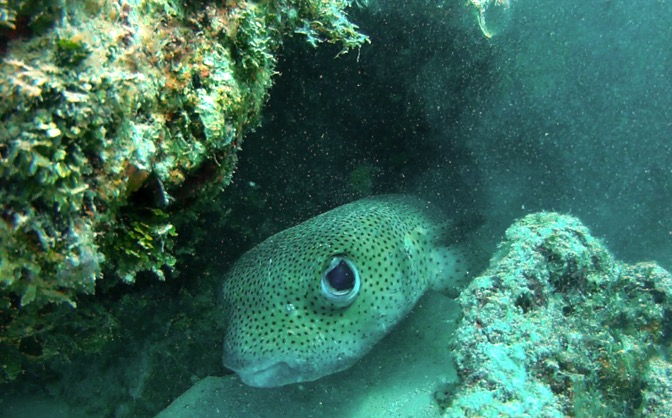
A "Scrawled Filefish". We have only seen these a few times in all our years of diving. They grow up to almost 3 feet long. This fellow is over 2 feet long.
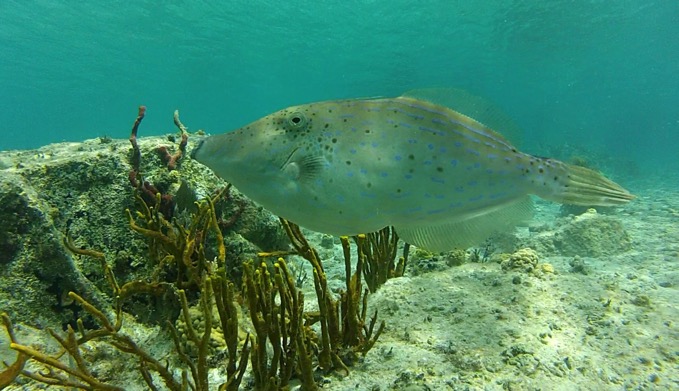
Sheryl swims in a school of silversides.
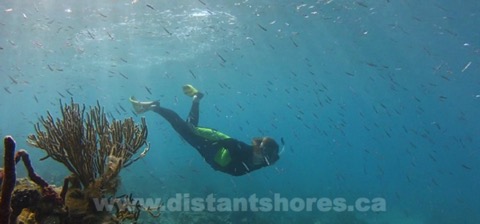
I dive down under the boat. This is a different anchorage - deep water at about 18 meters to the bottom.
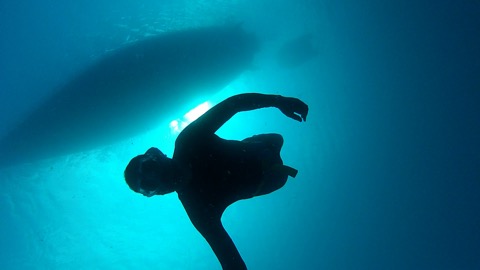
Enjoying the reef.
St Martin to British Virgin Islands
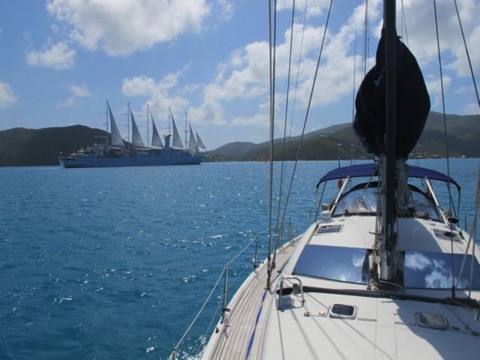
Greetings from the British Virgin Islands!
Our first visit here was in 1985 when Paul and I chartered a CS 36 sailboat with friends to test out our dream of sailing to the tropics. Needless to say, we loved it and did the voyage from Toronto, Canada, on our own boat a few years later. A lifestyle of sailing adventure began and our work as travel documentary filmmakers and writers blossomed. Now, with over 20 years of years of international cruising experience, 90,000 miles of voyages on our sailing resumes, and over 100 X 30-minute episodes of our sailing adventure TV series Distant Shores being broadcast around the world in 24 languages, we are back in the British Virgin Islands(BVI) for probably our 10th visit.
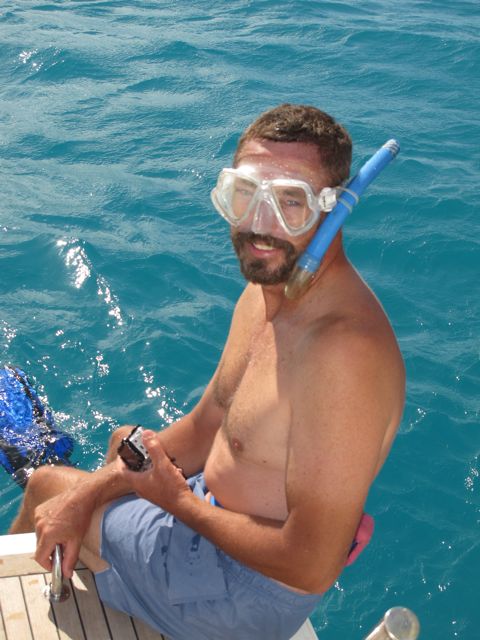
This time we're cruising this beautiful island chain on our 3rd boat, Distant Shores II, a Southerly 49 variable-draft sailboat, which we sailed across the Atlantic Ocean last December as participants in the ARC (Atlantic Rally for Cruisers). We were accompanied by our ever-cheerful Australian friend, Matthew Heron, who is an excellent sailor and, as always, great crew for a passage. It was Paul and my 5th transatlantic crossing and we documented the experience for Distant Shores episode #111 which is still in post-production.
To see a Sneak Peek from this episode about how we dealt with squalls on the transatlantic passage Click Here.
When I last wrote to you, on February 15, we had just re-launched Distant Shores after a couple of weeks of annual maintenance on the French/Dutch island of St Martin/St Maarten. We spent a couple of days at anchor in Simpson Bay Lagoon finishing up projects and then did a big grocery run across the lagoon in our dinghy to stock up on European delicacies and duty free goods for the ship's stores before leaving for the BVI where things can be a bit more pricey although there is great selection.
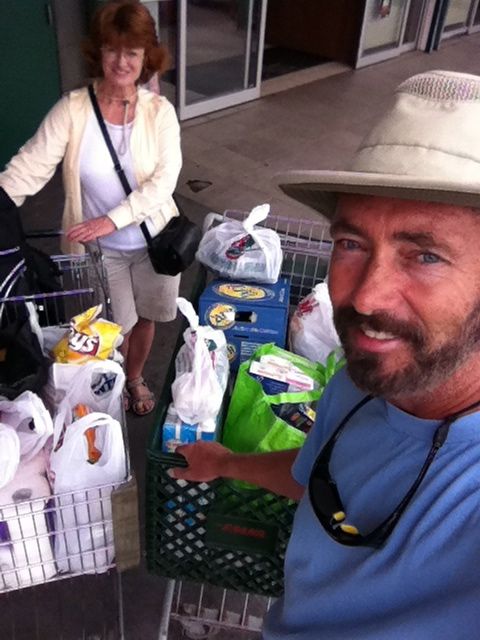
We got rather enthusiastic and when the courtesy delivery van from Grand Marche deposited us at the dinghy dock at Port de Plaisance, we had so much stuff we were afraid we were going to sink the dinghy on the ride back to the boat! Luckily it was a calm day and by going very slowly we arrived safely back at Distant Shores II without losing any of our cargo.
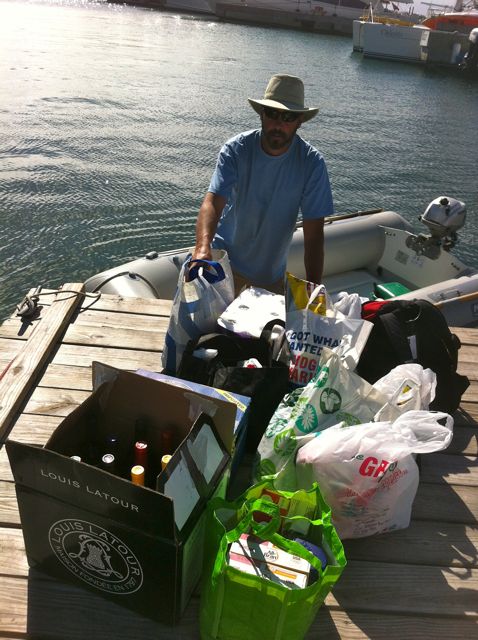
The next day when everything was carefully stowed away in lockers under benches and berths, we headed out of Simpson's Bay Lagoon at the 5:30 p.m. bridge opening at Sandy Ground Bridge on the French side of St Martin. (Sandy Ground Bridge Openings are at 8:15 a.m, 2:30 p.m. except on Sundays, and 5:30 p.m. Outbound traffic before Inbound. Bridge Operator is on VHF Ch 16 or tel. (0590) 590 87 20 43. There are no bridge fees as there are on the bridge on the Dutch side.)
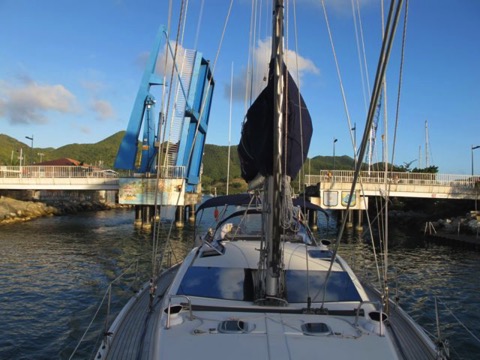
Conditions were good for anchoring off the town of Marigot in Marigot Bay. If there is a big swell from northerly directions it can be very rolly but we had steady east winds. Out in the clear open water off Marigot you can swim off the boat and beaches (the water in the lagoon is too dirty for swimming unfortunately) which was the first thing we did when we were anchored in Marigot Bay. This was followed by a sundowner in the cockpit looking at the lovely view of the town with Fort Louis overlooking all.
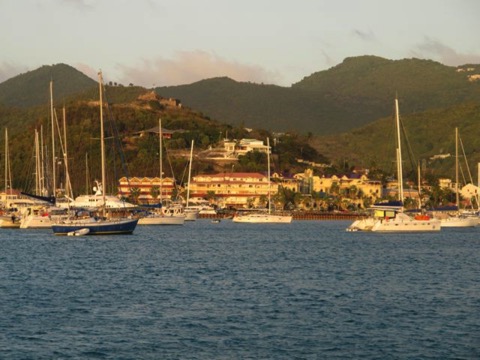
Paul and I try not to work on a Sunday and honour it as a day for family and friends so in the morning we took the dinghy back to St Maarten Shipyard and visited friends Peter, Monika, and their daughter, Claudia, aboard their boat, Tauá. We’d met Peter when working in the yard. His wife and daughter had just arrived from Paris and we were looking forward to meeting them. Like Peter, Monika and Claudia were great company and we ended up taking the bus into town together (you just hail little vans that have a BUS license plate as they pass by. $1 per person) to enjoy Sunday Brunch with them at ZeeBest Restaurant near the Simpson Bay Marina.
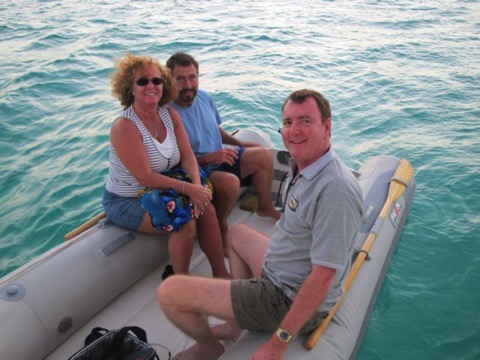
In the afternoon, Paul met up with long-time friends from our York University days, Terry Fraser and Michele Yard Fraser, who he picked up in the dinghy at the Marigot waterfront. Terry and Michele have had a timeshare in St Maarten for many years and know the island well. We had a great afternoon together aboard Distant Shores II and got caught up on everyone's news and adventures.
Back in Marigot Paul cleared us out from St. Martin (you can clear Customs and Immigration on Sundays at Marina Fort Louis, otherwise at the ferry dock or the harbourmasters office at Marina Port La Royale the rest of the week). We were planning to leave early the next morning for the British Virgin Islands.
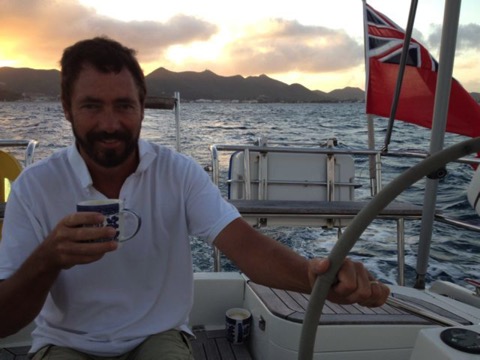
Morning commute aboard Distant Shores II
At 0630 on Monday February 18, we raised anchor and began a 84-mile crossing of the Anegada Passage, a strait that lies between the British Virgin Islands and St Martin plus the neighbouring island of Anguilla.
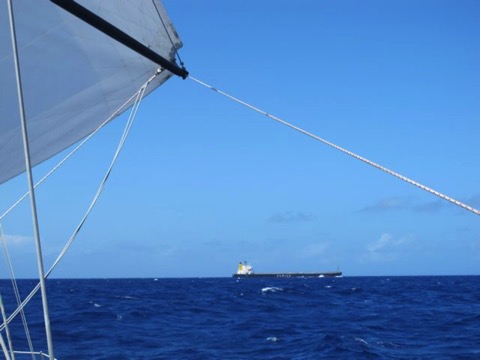
Many large ships enter the Caribbean Sea through this strait so we kept our eyes peeled and throughout the day we saw a lot of them. We had beautiful fresh tradewinds blowing from behind us so we poled out our jib and genoa and sailed wing and wing for the day.
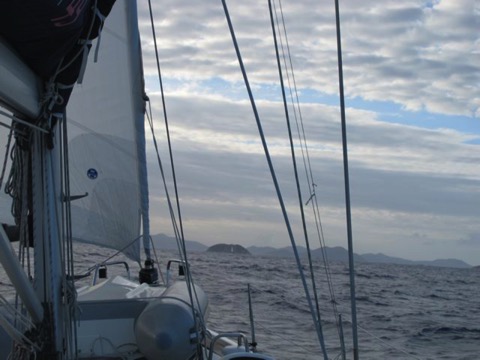
After a great sail, we arrived at Round Rock Passage in the British Virgin Islands 12 hours later, just before sunset so the timing was perfect. From there we made a 20 minute run up to Spanish Town where we anchored for the night. First thing the next morning we cleared-in to the British Virgin Islands at the customs office at Spanish Town ferry dock on Virgin Gorda. Customs offices are open Monday to Friday 8:30am to 4:30pm and Saturday 8:30am to 12:30pm. Closed Sundays and on BVI public holidays. For more info on locations and cruising permit fees Click Here.
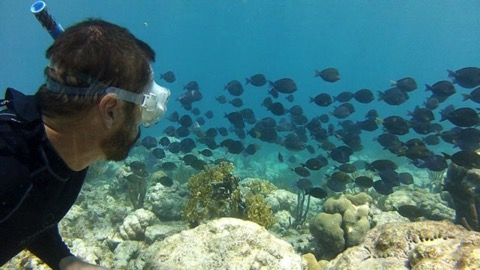
Paul and school of Blue Tangs
We will spend the next couple of weeks break here in the BVI, relaxing at anchor, snorkelling, and working on scripts and editing. We have already filmed 2 episodes of Distant Shores about the BVI, one about bareboat chartering here if that is something that interests you. You can see both BVI episodes in the Distant Shores season 5 DVD collection. For more information or to watch a trailer Click Here.
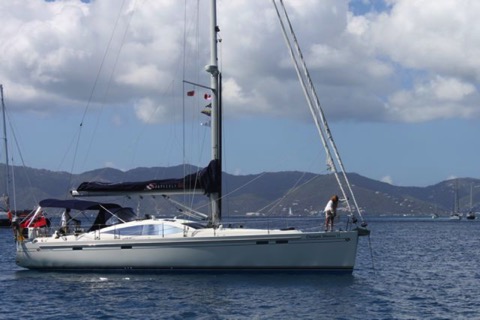
Anchoring in Great Harbour, Peter Island. Photo by Andrew Evans
At the moment, Distant Shores II is anchored in Great Harbour, Peter Island, one of our favourite places for snorkelling. The sun is high so it's a good time to go for a dip and explore the reefs along the shore, so we'll say ciao for now.
Have a great week!
Sheryl and Paul
Aboard Distant Shores II
Great Harbour, Peter Island
British Virgin Islands
Researching Destinations for your Dream Cruise?
Check out the entire Distant Shores Super Pack which now includes the newest episodes in the Caribbean, Turks & Caicos and Bahamas from Season 10.
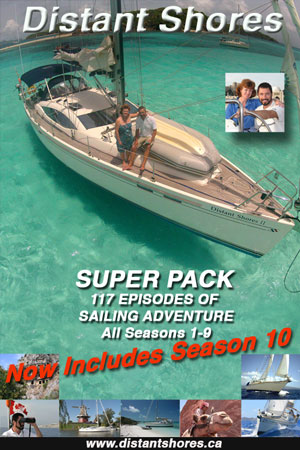
St Martin/St Maarten
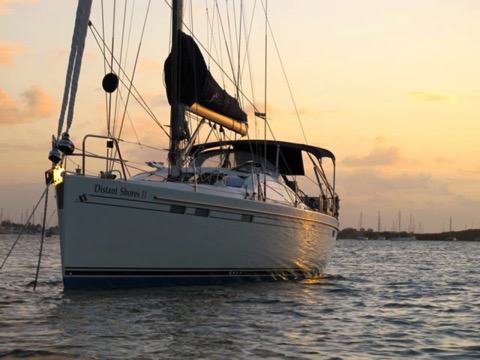
Our Southerly 49, Distant Shores II, is back in the water in St Martin in the Caribbean, after a week of seasonal maintenance on the boat before we continue with a winter season of sailing and filming new episodes for the Distant Shores TV series in the tropics this year. We re-launched the boat on Monday and are now anchored in Simpson Bay Lagoon near Marigot, St Martin (the French side of the island).
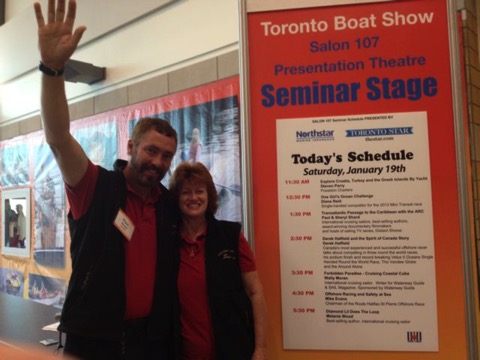
Paul and Sheryl at Toronto International Boat Show January 18-20, 2013
We have only been back in St Martin for 10 days since were home in Canada for 3 weeks doing presentations at the Toronto International Boat Show and other events, then flew back from Toronto on Feb 5.
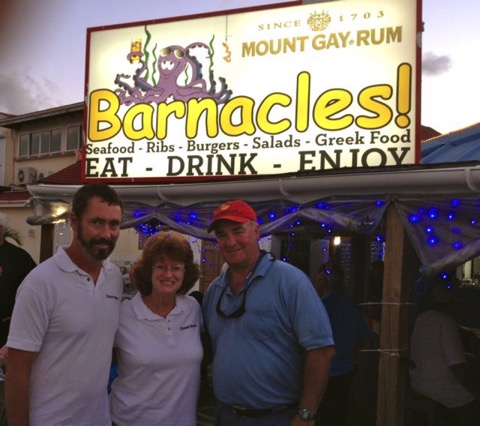
Paul and Sheryl with Toronto sailor, Dave McGuire
Our flight back to St Martin/St Maarten was good on WestJet which has direct non-stop flights from Toronto YYZ to Phillipsburg SXM. There were 5 other Toronto sailors on the plane that we knew, all heading back to their boats after visiting home for the Holidays and Toronto Boat Show, so it was a sociable flight! We all met up again later on the island, at Barnacles, the sailors' bar in St Maarten.
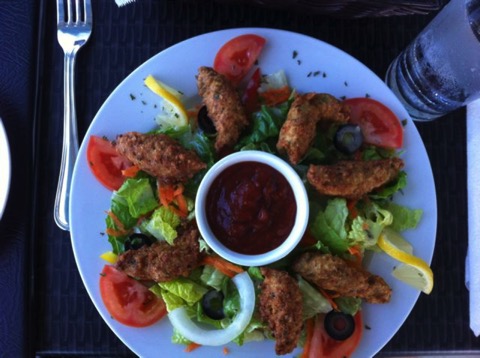
Salt fish cakes or fritters are a traditional snack throughout the Caribbean.
There are lots of great restaurants and varied cuisine on this half-Dutch half-French tropical island. When we were in the boat yard we really enjoyed the Boca Marine restaurant that was on site. The appetizer pictured above is salt-fish cakes (dried salted cod made into fritters) which are a traditional snack found throughout many islands in the Caribbean.
St Maarten Shipyard, where we had hauled out the boat for storage before flying home, is very close to the airport so we just walked to the boat after landing and clearing in!
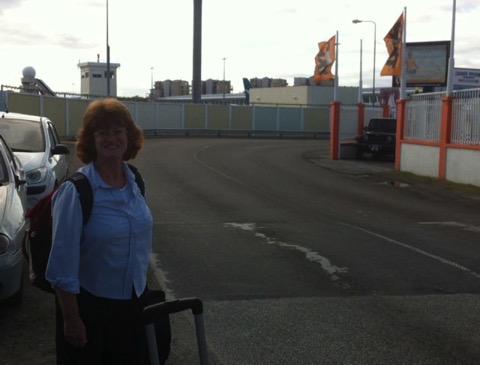
Sheryl walking from the airport terminal to the boat yard
The yard is right beside the runway so as we worked on the boat all week we had a constant Air Show :-)
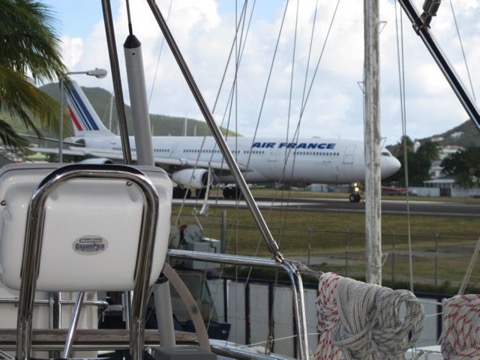
View of SXM runway from Distant Shores II in St Maarten Shipyard
There were other sailors working in the yard too and the staff there were all really helpful and nice, so the time in the yard was very pleasant despite working with messy/toxic anti-fouling paint.
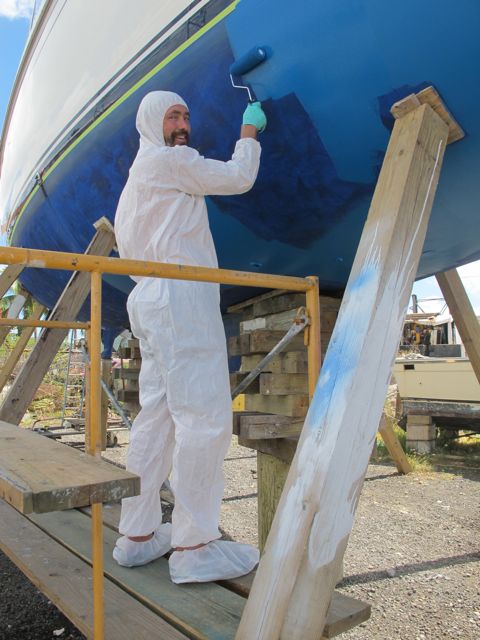
See previous newsletter for details and cost of the haul-out.
St Maarten Shipyard has a SeaLift which is like a huge padded forklift that they use instead of a travel lift. The SeaLift could raise us high enough to paint the full height of the keel. It was good to get a close-up look and see that all was well.
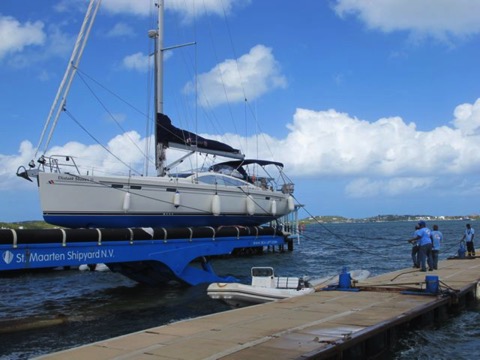
We re-launched the boat on Monday February 11 and will spend a few days at anchor in Simpson Bay Lagoon on the French side of St Martin finishing up some projects before sailing on. Mardi Gras celebrations are going strong in Marigot this week with the start of Lent. I've decided to give up "snow" for Lent this year :-)
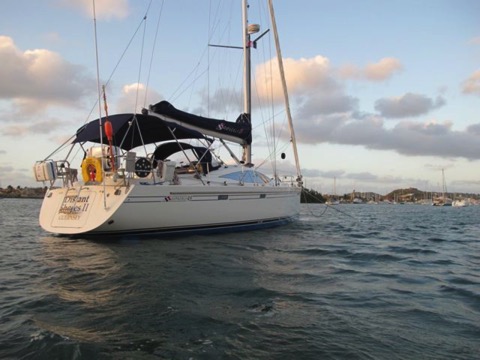
On the weekend, weather permitting, we'll leave St Martin for the British Virgin Islands where we plan to stay for about 10 days. After that we will work our way slowly south through the island chain filming new episodes for Distant Shores season 9 in Dominica, Martinique, St Lucia, St Vincent and the Grenadines, and Grenada.
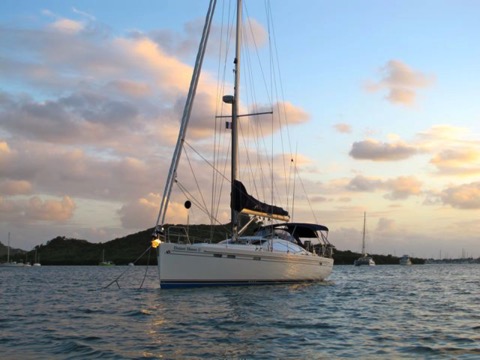
In May we will probably store the boat in Grenada for the Hurricane Season so will be home in Canada to continue with post-production on the shows in the summer for a change.
Have a really great weekend!
Warm regards,
Paul and Sheryl Shard
Aboard SY Distant Shores II
Marigot, St Martin
West Indies
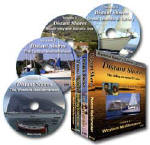
Click here to check out our DVDs for more cruising adventures and tips!
Distant Shores TV Show Facebook
Haul-out St Maarten
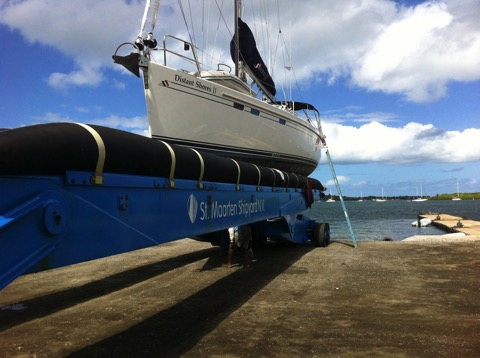
Check out the underwater garden!
Did I mention we need to do the bottom?? Corals have grown up quickly since we reached the warm Caribbean waters. Our 8-month old bottom paint was Cruiser Uno and it worked fine in Europe. Not so good for the tropics it seems.
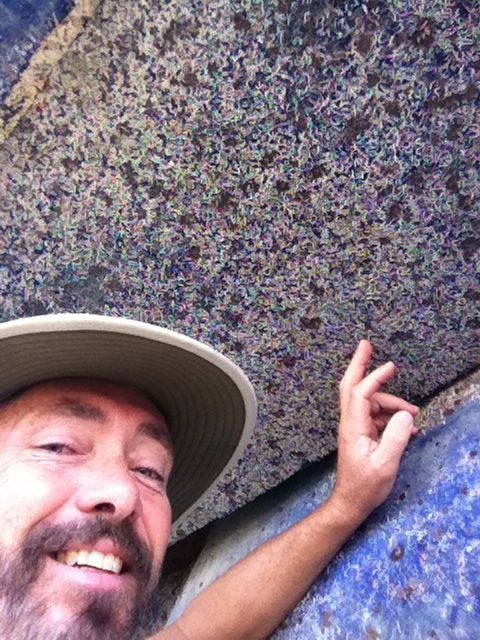
We wanted to do the bottom ourselves this time. I always did it myself on our previous boats but had Northshore (builders of Southerly) do it when we went back there to haul out the previous seasons. I wanted to do it at least once to see how hard it was on the new larger boat, and to get a really close look at the bottom.
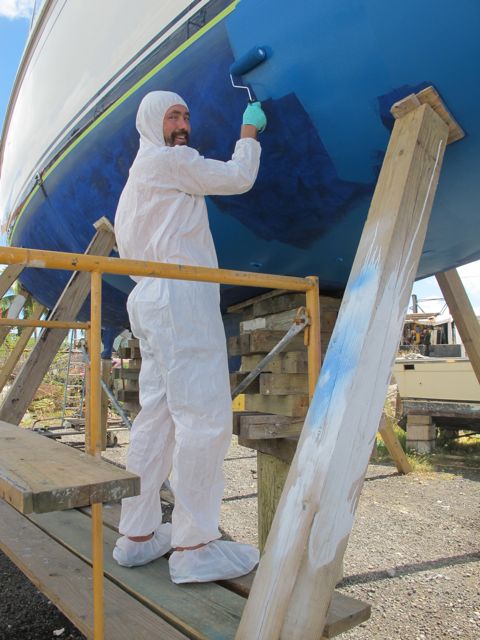
Working on the Southerly with her keel swung down I am using a scaffold. We are trying out "Seahawk Islands 44 Hard" bottom paint. It was $320/gallon minus a 10% discount at Island Waterworld. It is supposed to cover 400 sq feet/gallon. We bought 3 gallons of it and managed to get 1.8 coats of paint. I think the warm weather meant it went on thicker than normal.
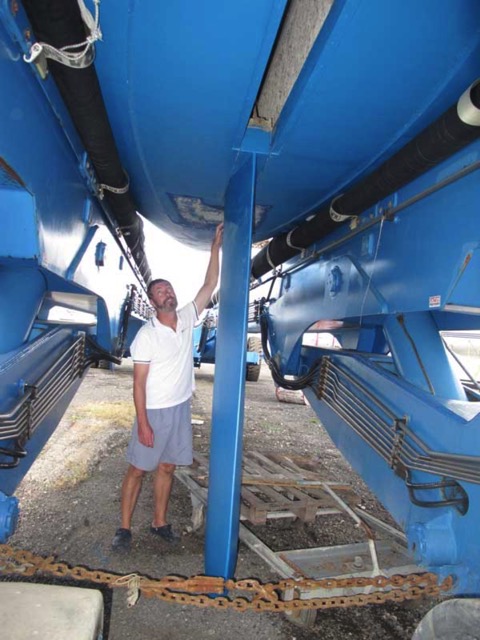
This lift can raise the hull high enough to drop the keel to her full draft so I could paint the whole thing. We draw 10’3 with it all the way down and need a ladder to reach the bottom and finish up the painting. The patch in front of the keel is where we stood on the blocks while hauled. The yard kindly let us sit in the lift overnight so we could paint the last bits of the hull that had been under the stands. Then it could dry properly. St Maarten Shipyard was excellent all round! Highly recommended! Our bill was quite reasonable I think...
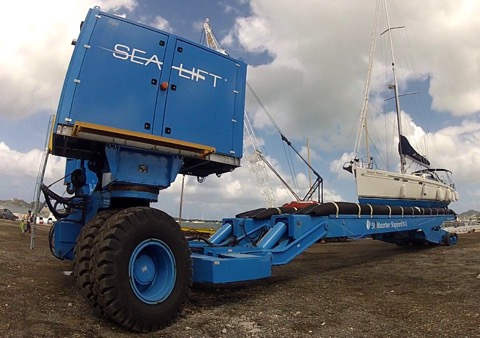
Haul/Launch.................$441
Blocking.......................$122
Pressure Wash...............$98
Storage (while home)... $448
Labour (scrape hull)......$105
All very good rates based I think. This is based on our 49 foot boat with 14’ beam. The additional labour was for an extra sanding/scraping of the hull to remove the barnacle bases and make a super-smooth hull.
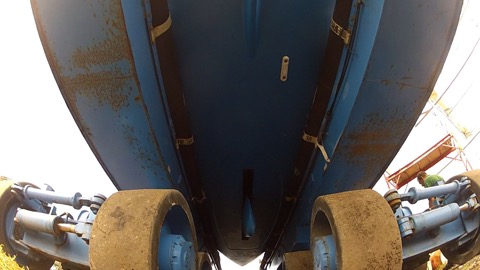
The other nice thing about hauling out in St Maarten is the access to the huge chandleries, Island Waterworld, Budget Marine, and other parts/services. These are second to none in the Caribbean.
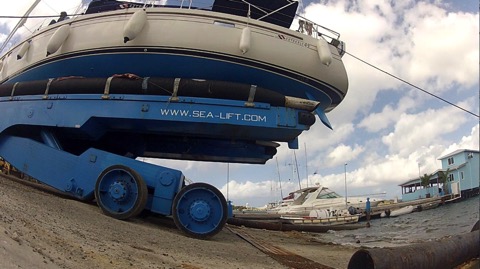
Relaunching after a successful haulout... Hank steers the sealift back in with the remote control.
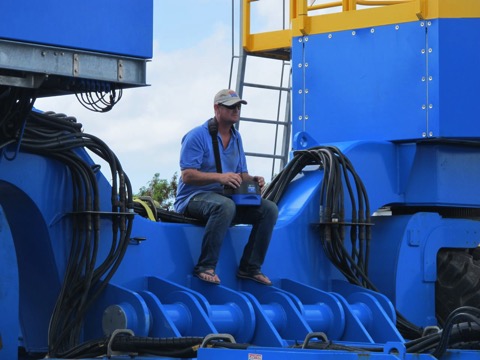
This device is unique I think. It can lift 90 tons, it can also accommodate quite large catamarans lifting under the wing deck. The boat sits gently on inflated tubes so its also good for wooden hulls.
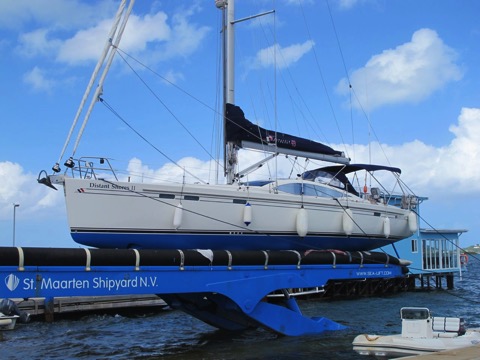
Back at anchor...
